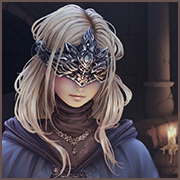|
  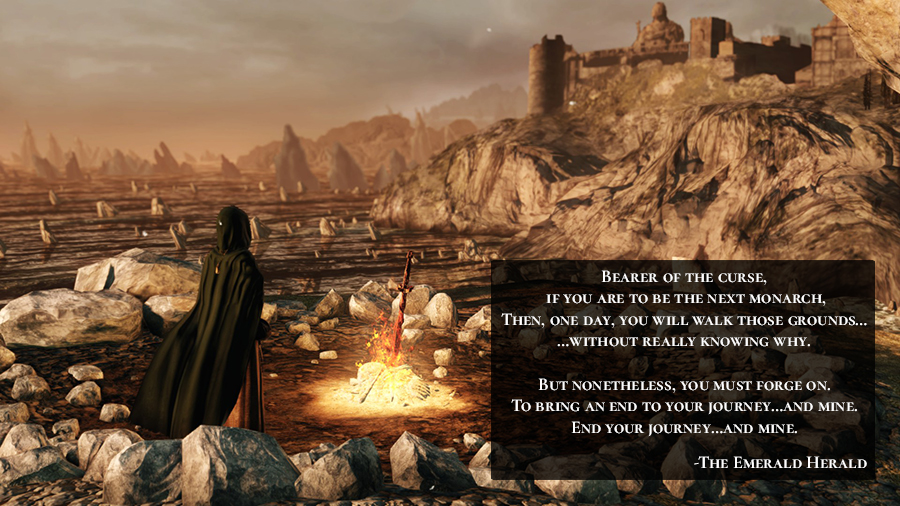 A few months ago I was working on a project entirely unrelated to Dark Souls, but my mind likes to forge peculiar connections. Those connections inspired me to look into what happened in the Dark Souls 3 DLC. I didn't have access to it when I first played through the game, and I am very bad at playing games a second time. Reading about the events in the DLC, I stumbled upon a revelation that completely changed how I see all of these games. I never completed that original project because of how much this new discovery has consumed me. It tells such a beautifully tragic story that lurks just beneath the surface of all these worlds that we thought were familiar, when all we've actually seen is their shadows.   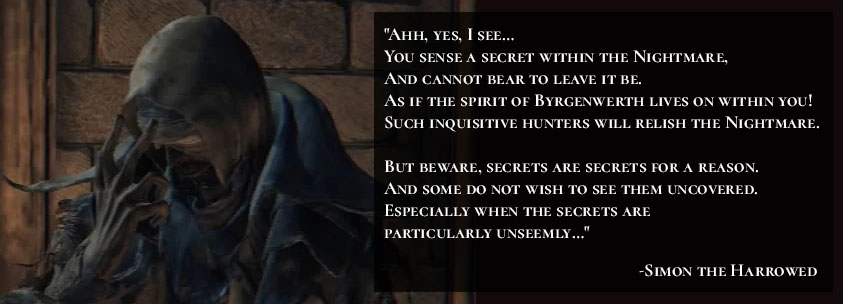 We're going to do lore-focused playthrough of all three Dark Souls games, Bloodborne, and Sekiro, with a heavy emphasis on developer interviews, so that we may have eyes on the inside. This means there will be spoilers both throughout the play through and in the rest of this post. That said, I'm trying to keep this series accessible to someone with absolutely no knowledge of the series. But if you want a strictly chronological experience you should probably start elsewhere. "Five let’s plays at once? That's insane!"  In trying to write a Grand Unifying Theory of Soulsborne, I’ve run into a problem: no one, including myself, remembers the details of all five of these games. These games are actually composed of many different worlds that have had their flames linked. We are rarely ever told explicitly when we transition between timelines, so players tend to interpret them as one unified world that they seek to explain through a single, linear narrative. This process of mistranslation is likely intentional, mirroring Miyazaki's early experiences with English-language novels involved him filling in the blanks of the sections he couldn't understand. "GameInformer posted:Miyazaki's passion for reading is life-long, extending from his time poring over library books at a young age. Even though he couldn't read all the English stories of dark fantasy and horror, he created his own personal narratives to stitch together the excerpts he could understand. But another way to see these games is a single tragic narrative happening over and over again. They share the same core DNA, but each one also has its own unique mutations. We only see fragments of each story, but sometimes we can spot blood echoes, motifs present in two separate timelines. If we transpose our knowledge of the context of one motif into the other, sometimes that produces a resonance, signalling that we've stumbled upon a more complete understanding of the underlying narrative. "Miyazaki posted:I like to think that this way of creating – leaving spaces – is satisfying. So if there are incomplete aspects of Dark Souls III, please forgive us. When the player is inside the world of the game, there are various places where they feel they may be able to peek behind the curtain, pry open a window and see beyond. Looking at it this way, the Souls series becomes a sort of forensic puzzle. Once you start putting all the pieces together you start seeing the games in a completely different light. Maybe even a more complete understanding both of what they are, and also what they were supposed to be. "Miyazaki posted:Dark Souls is in some ways an incomplete game, and I like to think that it has been completed by players, by their discoveries, as they moved along. I’d love to say that the nature of this incompleteness was completely deliberate, but it is both deliberate and by accident, in different ways. My hope is that recording a play-through of all these games concurrently will create a visual record of these echoes for my reference purposes. It might also challenge me in several ways. I've already found that playing through even the most mundane challenges of these games while also formulating a detailed description is rather difficult. It will also force me to play through the games and sections I tend to avoid or burn out on. And finally, exposing my thoughts to the world might lead to people pointing out things I've gotten wrong or connections that I have missed.  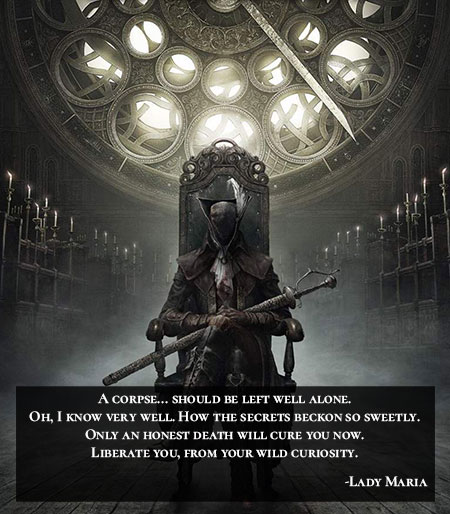 But some of you might need a more concrete pitch, so here's the more detailed description of where things are headed.  The embering of this theory begins with the intro to the Painted World of Ariandel DLC of Dark Souls 3. Slave Knight Gael explains to us that the Forlorn are those "who have no place to call their own." If this applies to the denizens of the Painted World in Dark Souls 3, why not try applying it to the denizens of the Painted World in Dark Souls 1, particularly Priscilla. In the Design Works interview for Dark Souls 1, they call Priscilla someone who has "been chased away from her natural place," which echoes Gael's description of the Forlorn. Miyazaki then elaborates that "'natural place' means something slightly different in this case." This interview is curious in how quickly Miyazaki changes the topic away from Priscilla multiple times, as if there's something emotionally painful in talking about her that he wants to avoid. They also mention that his vision for her was so specific that they contracted an outside art studio to produce it. This is curious because it suggests they went to extra expenses to make a highly detailed art asset that they then lock off in an easily missed side area. It does not make sense. Elsewhere in the interview they talk about Dark Souls 1's Firelink Shrine. They reveal that it was the original location of Priscilla, and that she was originally the heroine of the story. In this abandoned narrative, Firelink Shrine was designed as a water temple, but that "as work on the game progressed, and the image of kindling and fire became more prominent, the water gradually dried up." And that's when it hit me: the maps in these games are always missing water. So my theory is that Dark Souls (or Demon's Souls, the flow of time in game development is convoluted) was originally going to be a water-focused game centered around Priscilla. This had to be abandoned when they couldn't produce decent looking water physics on the Playstation 3 without absolutely killing frame rates. Because of this hindrance, large amounts of dev work would have had to been scrapped, but Miyazaki came up with the pyromancy of merging it all into a singular waste land abandoned by its creator with an endless cycle of monarchs invading other worlds in a desperate attempt to stave off the extinction. But this ritual required the execution of the original denizens of these worlds. Hunting them down like beasts. Massacring the inhabitants of a hamlet and carving out their skulls in search of insight. But Miyazaki, or Havel, or Gehrman couldn't bear to kill one character, and so he hid her away to keep her safe. Except that surviving orphan eventually discovered what happened to her kin. 
Sibyl Disobedience fucked around with this message at 07:16 on Jun 21, 2020 |
|
|
|

|
| # ¿ Apr 25, 2024 14:29 |
|
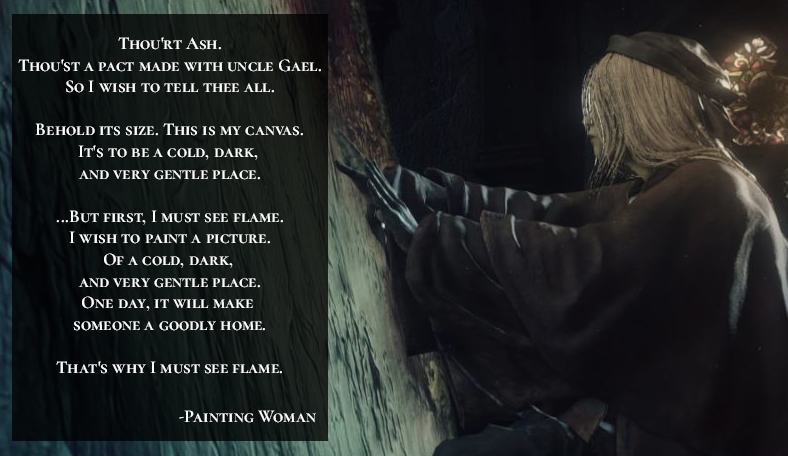  pre:Video Essays/Scripted Summaries: [Prologue] Return From Whence Thou Cam'st: Linking the Painted Worlds of Dark Souls [Age One] Of Prisoners and Bells: The Slippery Symbolism of Dark Souls [Age Two] Mercy for the Poor, Wizened Child: the Origins of Blighttown [Age Two] An Association of Gluttony: Hunger in Dark Souls Prologue - Linking the Painted Worlds: video || Text Summary: Thread Post // Offsite Age One -- Of Prisoners and Bells 01 - Infiltrating the Aqueduct(DS1-01): video || Text Summary: Thread Post // Offsite 02 - Solaire and Siegmeyer(DS1-02): video || Text Summary: Thread Post // Offsite 03 - Flushing the Ash(DS3-01): video || Text Summary: Thread Post // Offsite 04 - The Lothric Prison Break(DS3-02): video || Text Summary: Thread Post // Offsite 05 - The Lothric Civil War(DS3-03): video || Text Summary: Thread Post // Offsite 06 - The Madman's Knowledge(BB-01): video || Text Summary: Thread Post // Offsite 07 - db(BB-02): video || Text Summary: Thread Post // Offsite 08 - Gascoigne's Music Box(BB-03): video || Text Summary: Thread Post // Offsite 09 - Gargoyle Tail Axe(DS1-03): video || Text Summary: Thread Post // Offsite Age Two -- An Association of Gluttony Interlude - The Capra Demon's Wings (DS1-04) || Text Summary: Thread Post // Offsite 10 - They're all chalice dungeons?(BB-04): video || Text Summary: Thread Post // Offsite 11 - Are we left no other choice?(BB-05): video || Text Summary: Thread Post // Offsite 12 - Consumed with the Desire to Eat(DS1-05): video || Text Summary: Thread Post // Offsite 13 - Mercy for the Poor, Wizened Child(DS1-06): video Age Three -- ??? 14 - Where the accepted currency is souls(DS1-07): video || Text Summary: Thread Post // Offsite 15 - The Riddle of the Inscrutable Lift(DS3-04): || Text Summary: Thread Post // Offsite 16 - The Transposing Kiln(DS3-05): || Text Summary: Thread Post // Offsite 17 - A crow in his cage(DS3-06): || Text Summary: Thread Post // Offsite 18 - It's just that, I wish to know the truth.(DS1-08): || Text Summary: Thread Post // Offsite 19 - Seek the old blood(BB-06): || Text Summary: Thread Post // Offsite 20 - Bone Marrow Ash(BB-07): || Text Summary: Thread Post // Offsite 21 - Rune Workshop Tool(BB-08): || Text Summary: Thread Post // Offsite 22 - The Last Knight(DS1-09): || Text Summary: Thread Post // Offsite Complete Playlist Dark Souls 1 Only Dark Souls 3 Only Bloodborne Only Video Essays Only  Dark Souls 1 Design Works Interview Dark Souls 2 Design Works Interview Future Press Bloodborne Interview Guardian Interview on Déraciné References to an Edge Interview I haven’t been able to find as a primary source Dark Souls 2 Geographical “issues” Iron Keep: A Castle in the Clouds? Iron Keep: A Castle in the Right Spot Dark Souls 2: Early Dark Chasm Map Data and a Major Implication About the World Design The Paleblood Hunt The Sacred and the Profane by Mircea Eliade My writings so far: The Undeath of the Author My channel if you want to watch a recording live for some bizarre reason: https://www.twitch.tv/sibyld  Are you saying Dark Souls, Bloodborne, and Sekiro are connected? Look, the flow of cosmology at FromSoft is convoluted. I suspect officially they are not and cannot be due to publisher agreements. However, on a thematic level they are absolutely connected by virtue of being written by the same person and surrounding team. This would be inevitable even if it weren’t intentional. But I suspect it’s very intentional. Each game has an incompletess, “both deliberate and by accident,” that can be filled in thematically by transposing in our understanding of resonant portions in the other games. Does this mean _____’s interpretation is wrong? I could start talking about Death of the Author vs Biographical Criticism, but let’s keep things nice and simple. Dark Souls is full of empty spaces, so you can treat it like either a Mad Lib or solving a murder mystery whose author never got to write the ending. Both processes are legitimate and the only real test is whether the resulting interpretation is interesting. How can you be sure of any of this? I am never sure of any particular detail. If I’m spot-on with 20% of the stuff I write then I’ve drastically exceeded my own expectations. This project is like an archaeological dig. You can get closer to understanding how the civilization worked, but that understanding will never be 100% complete or 100% accurate. That being said, I’m surprisingly confident that I’m onto something. The thought patterns that I’m reading are too pronounced to be accidental. Besides, it’s a lot easier to have a complete story and obfuscate it than it is to come up with a bunch of random nonsense that nevertheless feels coherent. What about Demon’s Souls? La la la, I can’t hear you. Demon’s Souls is likely incredibly important, but I don’t currently have access to a way to play it. Also, Dark Souls 2 is already more than enough of a test of my patience. But the bits I do know about I suspect are very relevant, like Maiden Astraea and Old Monk. So are ____ and ____ the same character? I don’t know. Run with the assumption and see where it takes you. More seriously, my current suspicion is that rhyming characters are thematic reincarnations (or mergings), similar to Michael Moorcock’s “Eternal Champion” archetype. I’m not ruling out some kind of more direct character progression between Dark Souls 1, 2 and 3 though, and you could almost certainly tell a pretty interesting story taking that route How can you be certain that Miyazaki has even read _____? I can’t, but I know from interviews he’s a prolific reader, so guessing at inspirations can be a helpful way of divining authorial intent. A lot of this is based on linguistic patterns. Moorcock’s Stormbringer vs Demon’s Souls Stormruler and Elric vs Aldrich for example. Take it a step further and “Chosen Undead” seems pretty similar to “Eternal Champion.” Or with “The Sacred and the Profane” it started with noticing an unusual word choice in The Profaned Capital, and just investigating it. Then when the text of the book included a whole bunch of resonant passages including the one at the beginning of this thread, I adopted it as an interesting lens to use for broader story interpretations. Of course I’m probably going to get some of these wrong, but, for example, it’s really not a stretch to guess that a prolific reader making a game that reinterprets Lovecraft would be reading recent fiction that also reinterprets Lovecraft. And second, so what? If it tells an interesting story, is it that big of a deal if it wasn’t the one intended? Now the Allan Corduner theory, that is one that leaves me so incredulous that I haven’t shared it with anyone. "Okay, I've read all of this and I still think you're insane." 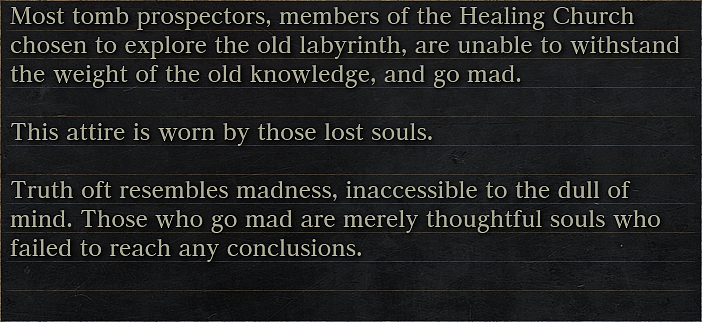
Sibyl Disobedience fucked around with this message at 02:50 on Dec 29, 2020 |
|
|
|
Latest Videos: https://www.youtube.com/watch?v=y4_WKF-pg8s https://www.youtube.com/watch?v=NkVW4LVV2HY https://www.youtube.com/watch?v=1uQSIqz8GBE https://www.youtube.com/watch?v=CIYMuOmqfFg Sibyl Disobedience fucked around with this message at 21:55 on Sep 28, 2020 |
|
|
|
The Prologue: Sister Friede and Priscilla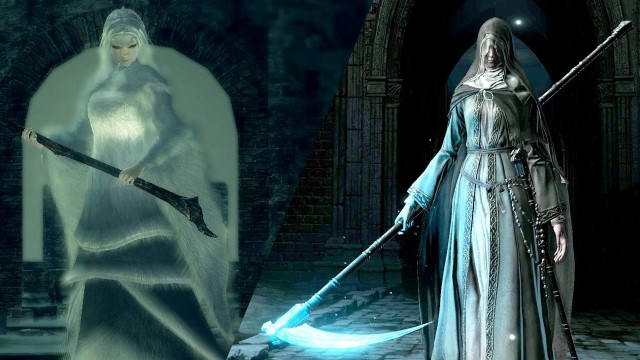 Patches the Spider (Bloodborne) posted:What a joy it is, to behold the divine. My prologue begins unconventionally with the final boss in the series. An early warning that there will have to be spoilers, but in a way, it’s hard to spoil a game that you will never really understand your first time playing through it. This probably wasn’t the most viewer friendly way to begin an LP, but from my perspective the ritual was necessary. I was actually kinda paranoid I would accidentally beat her because that would complicate future plans. If you want to skip to the meat of the video: 20:50 Starting here was important because it’s the perfect area to illustrate three concepts that will be essential to uncovering the First Sin. First, whether or not these games are linked in terms of in-universe metaphysics, they’re linked in that they all came from the same creative project. Artists of all types have a tendency to repeat themes throughout their works, and in the case of Soulsborne games, these repetitions aren’t merely homage; they’re keys to the puzzle. With the repeated but identical portraits lining the walls, Friede’s room is incredibly interesting visually. But Dark Souls 3 never explains why, never even acknowledges the oddity. But Sekiro has a similar motif that does explain itself: the Sculptor. 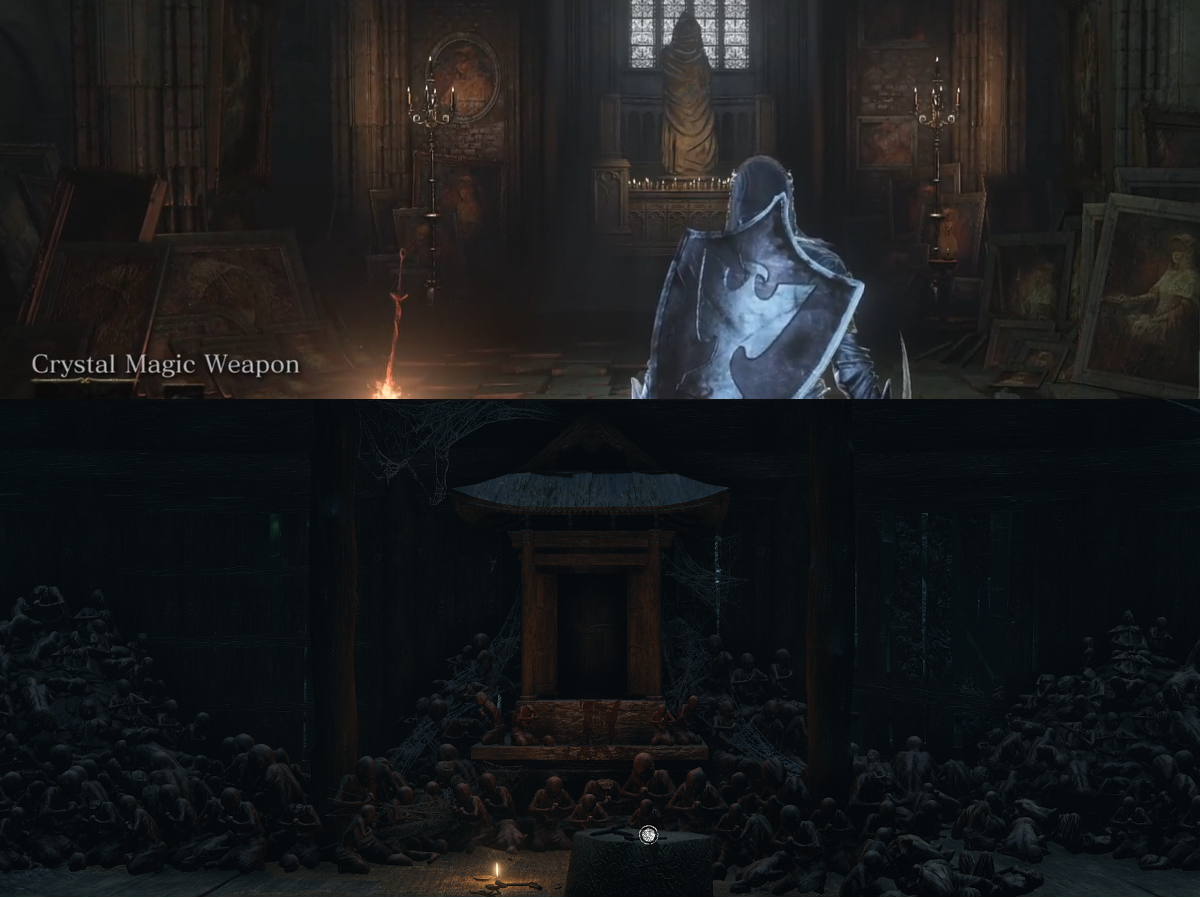 quote:No matter what I do, any Buddha I carve is an incarnation of wrath. Thus is the fate of those who owe a deep karmic debt. You'll understand when you try carving one for yourself one day. The Sekiro Sculptor is stuck in a cycle of artistic eternal return that he cannot break out of; that he even passes on to the next generation in one of the endings. His creations cannot satisfy him because they are always angry, a sign of his inability to let go of a self-destructive emotional attachment. If we assume Ariandel is the painter of all the portraits, it’s likely he’s stuck in a similar cycle of eternal recurrence. That he cannot stop devoting his artistic efforts to this woman, even if those efforts repeatedly end in tragedy (the woman in the painting being on fire). This is a perfect example of thematic resonance. Second, we have another example of resonance: the structural parallels between Sister Friede and Priscilla from Dark Souls 1. Both are scythe-wielding overseers of their respective painted worlds, but the more convincing parallel is their dialogues: Priscilla (Dark Souls 1) posted:Who art thou? One of us, thou art not. Sister Friede (Dark Souls 3) posted:But Forlorn thou seemeth not. These parallels cannot be accidental. And when it comes to parallel phrasing, we have more supporting examples linking the two Painted Worlds. Before entering the Painted World of Ariandel, you can overhear Slave Knight Gael chanting, "Ahh, merciful goddess, mother of the Forlorn, who have no place to call their own…" This is extremely interesting phrasing because in the Dark Souls 1 Design Works interview, Priscilla is described as “someone who's being chased...from her natural place,” which would certainly be someone who has no place to call their own. And just to emphasize how long the obsession with this concept has lingered in FromSoft’s game development, in an interview talking about their 2018 title Déraciné, Miyazaki explains why they chose that title: quote:“Déraciné is French for uprooting,” says Miyazaki. “Or someone who’s been displaced from their natural environment. These patterns are not coincidental. They are absolutely a sign of creative obsession. And that provides us a mystery to solve. Finally, I showcase the thing missing from the Painted World of Ariandel: a river that has dried up (I called it a river of blood though I guess the precise source of the remaining diseased trickle is debatable). 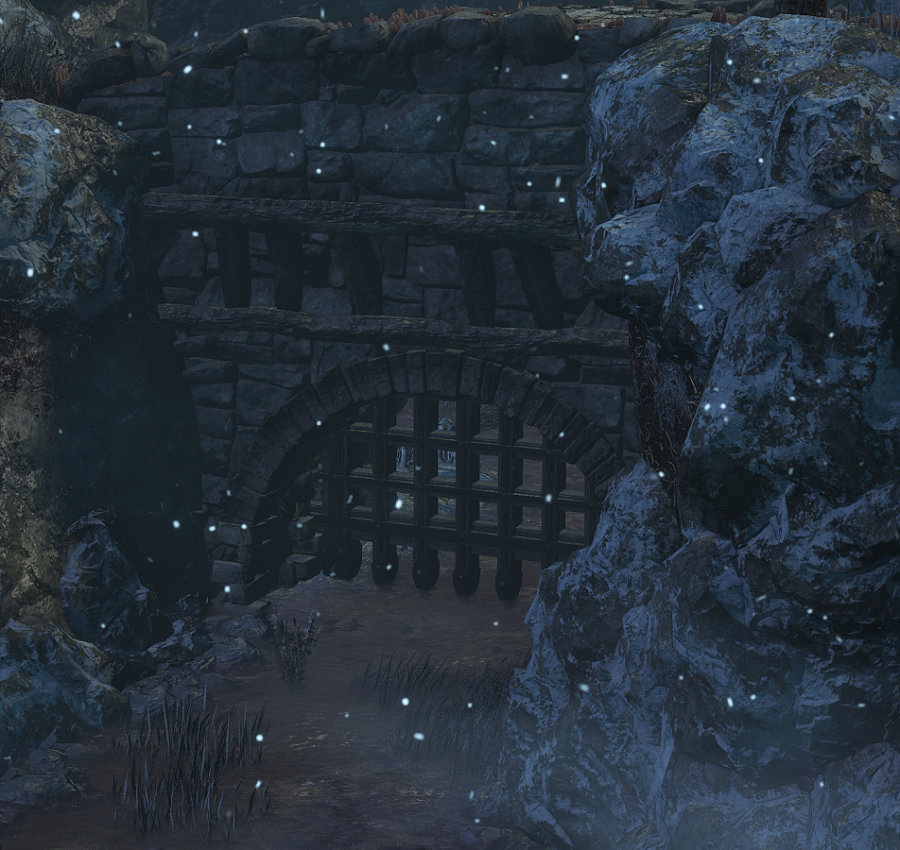 This dried up water source repeats over and over again throughout Dark Souls 1 and Bloodborne, though the narratives of the game never try to draw our attention towards it. This is particularly interesting because in talking about Priscilla and Firelink Shrine, again in the Dark Souls 1 Design Works Interview, we are told that: Daisuke Satake posted:[Firelink Shrine] was originally designed as a water temple. But as work on the game progressed, and the image of kindling and fire became more prominent, the water gradually dried up. Haha.” Oh you beautifully devious bastards… Sibyl Disobedience fucked around with this message at 00:49 on Jun 5, 2020 |
|
|
|
Episode 01 (DS1-01): Infiltrating the AqueductThe Sacred and the Profane posted:This is as much as to say that, with the building of each fire altar, not only is the world remade but the year is built too; in other words, time is regenerated by being created anew. Corvian Settler (Dark Souls 3) posted:Ohh, ohh, finally, you've come! Video too long, and this stretch is kinda boring, but we have to start here because everything that follows is built on this foundation. Possibly literally. Dark Souls 1 is the most abstracted of these games, and a lot of what’s going on only becomes clear in the lens of the later games. For now we peer through a fog gate darkly. A couple interesting things though. The Northern Undead Asylum is the first example of mirroring in map design throughout the series. It’s a little spoilery, but we’ll be back here on a mirror journey to recover an object of obsession with a sincere hope to reclaim it, and our path back in will mirror our escape out. There’s also something inherently curious about the name “Undead Asylum” itself. The area appears to be a prison, and while the state of mental health care throughout human history has been...less than ideal, mental asylums aren’t technically prisons. We’ll eventually get to an area in Bloodborne that is much more explicitly a medical asylum, but the difference between seeing it as an asylum and seeing it as a prison is merely a matter of perspective. There’s also the alternative definition of asylum as “the protection granted by a nation to someone who has left their native country as a political refugee.” Something you might offer someone who has been “displaced from their natural environment.” This series is playing misleading word games constantly, and they particularly like to use names that can point in multiple directions. Each direction offers you a different way to interpret the world. The biggest highlight to this segment for me is how you enter Undead Burg. Repeatedly throughout the series we have to resort to breaking and entering when just simply using the front gate is denied to us. I believe there’s a very deliberate metaphor in that. But more importantly, we’re entering through yet another area that is missing water. This is going to be a running theme; get used to it.  The last thing I’ll comment on is that I’m really amazed at how I notice new details every time I replay these games. Trying to make a thumbnail, I had to rewatch the intro FMV a couple of times, and what stood out to me was Nito. In the Dark Souls 1 Design Works interview we’re told: quote:Waragai: He was originally on fire wasn't he? What ended up standing out to me is how much this cloth effect reminded me of Father Ariandel’s feathers shown in the previous video, which is leading me down some interesting rabbit holes that I’m not ready to reveal. 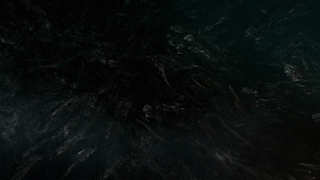  I also completely forgot about the woman at the end of the cutscene, who I’m inclined to believe is Anastacia. Her apparent grave tending in this video ties into the Dark Souls 3 lore contained in the Hidden Blessing item description: quote:Holy water blessed by the Queen of Lothric. And if this connection leads where it thinks it does, what she’s doing in the intro video becomes very interesting. But I don’t think I get to talk about that until Hemwick. 
Sibyl Disobedience fucked around with this message at 00:49 on Jun 5, 2020 |
|
|
|
Episode 02 (DS1-02): Solaire and SiegmeyerSolaire of Astora posted:But I cannot give up. I became Undead to pursue this! Siegmeyer of Catarina posted:I feel like I'm always thanking you… Ok, so here’s where things start getting fun. For me anyway. Let’s set up some history: Miyazaki posted:Demon’s Souls wasn’t doing well. The project had problems and the team had been unable to create a compelling prototype. But when I heard it was a fantasy-action role-playing game, I was excited. I figured if I could find a way to take control of the game, I could turn it into anything I wanted. Best of all, if my ideas failed, nobody would care – it was already a failure. While we don’t know the details, we do know that Demon’s Souls, FromSoft’s first game headed by Miyazaki, had a troubled development cycle. Despite helping fund it, Sony passed on publishing it outside of Japan, and the project must have been going completely off the rails for FromSoft to let a relative nobody within the company take over the creative direction. Dark Souls 2 had a similarly difficult birthing: quote:Firstly, I’d like to ask director Tanimura to give an overview of the Dark Souls 2 design process. This was your first role as director and you had some difficult shoes to fill in those of Mr Miyazaki, who was really the cornerstone of both the previous entry Dark Souls and its spiritual prequel Demon’s Souls. On top of that it was the first direct sequel in the series. Was it as difficult as it sounds? It wouldn’t be surprising for these challenging periods to influence the creative direction of these games, but I think it went well beyond influencing, with the epigenetic trauma of a hellish gamedev cycle baked directly into the narrative’s DNA. The first example we reach isn’t the most convincing on its own, but that’s the pitfalls of doing a linear playthrough, so if you’re skeptical, just give me the benefit of a doubt until we get to Majula. Anyway, Solaire and Siegmeyer are a dichotomy of failed managerial styles. Solaire follows the model of a classic grail quest that, spoiler alert for any Souls newbies, tends to end in tragedy due to hubris. He’s an extremely likeable character, always eager and willing to help you out, but his obsession with chasing after The Sun leads to his downfall. This is a metaphor for the over-eager attitude of a new project manager who hasn’t really internalized the concept of “scope creep.” quote:Miyazaki: When collaborating with the team I often come up with ideas, and I enjoy trying to fit them in as we develop the world. Of course I also have to be careful not to break anything. I think this method of continuous improvement can really help add to the atmosphere of an area, infact we also used this method on the last game I worked on "Demon's Souls", the problem is that there is a tendency to over produce things and before you know it the project can spiral out of control and work can slow down. I also suspect that Solaire marks the first major interest of Tarot symbology in the Soulsborne (minus Demon’s) series, which I’m probably going to butcher every time I bring it up. Upright the card represents something like optimism, vitality, confidence, success. All things that characterize Solaire quite well. But inverted The Sun becomes blocked happiness due to unrealistic expectations. A sentiment that I suspect was prevalent throughout the early development in this series. Siegmeyer is Solaire’s counterpart, a character who at every point in the game needs your help to progress past obstacles, eventually becoming ashamed at this dependency. There’s a lot more to be said about the character, but I think the first bit of it is best saved for Sen’s Fortress. Suffice to say he’s storyline is the polar opposite of Solaire’s. Never confident, always dependent. Like a timid manager who’s overwhelmed and reluctant to do what needs to be done. The other big thing for me in this stretch of play is a new discovery I had never noticed before this playthrough. The Taurus Demon boss from the last episode is fought on a stretch of rampart, and can sometimes backdash through a gap in the outer wall, falling to its death in a hilarious anti-climax. What I never noticed is that there are actually two gaps, and I have a theory for why that is. In the Design Works interview for DS1, Miyazaki sounds extremely proud of the area design of The Painted World of Ariamis: quote:Thank you. I'm very happy with the area overall. It was the important first map and I think I was able to incorporate the new ideas I had while not taking anything away from the original design of the area. When collaborating with the team I often come up with ideas, and I enjoy trying to fit them in as we develop the world. Conversely, he sounds rather indifferent about Undead Burg. quote:We never really spent much time working on the look of the area. It was the first map we created and the large bridge, the church and the other structures were already planned out by the 3d artist who was in charge of the area. As the lead artist on the project, he had already decided exactly how he wanted these things to look right down to the smallest detail, even the levers and statues. This is bizarre for a couple reasons. First, Undead Burg is the opening area of the game, the place where you’re trying to get the player hooked, so you would think it would receive a lot of attention and not sound so throwaway. Second, “the lead artist on the project,” sounds so distant for an interview that is otherwise very big on emphasizing the importance of “the team.” In comparison, there’s a real sense of ownership when he’s talking about the Painted World. And finally, how is it possible for both of these areas to be the “first map”? To answer all of these, I propose that the Painted World was the first map Miyazaki’s team created, and Undead Burg was an older map intended for a different project that was transposed into the world of Lordran. In fact, we're explicitly told that FromSoft did things like this in the making of Dark Souls 2: Dark Souls 2 director Yu Tanimura posted:It was at that point that I took on my current role, overseeing the entirety of the game including the art direction. To ensure we created the game both we and the fans wanted it was completely necessary, but it did of course create a problem. We had to decide what to do with the designs and maps that had been created up to that point. Ideally we’d start again from scratch but of course we were under time constraints so instead we had to figure out how to repurpose the designs in our newly reimagined game. This meant everything from deciding new roles for characters to finding ways to slot locations into the world map. This unusual development cycle faced us with an entirely different set of problems and looking back on the project as a whole it was at times, arduous. Although I’m confident that none of this will be felt by the players. So with that in mind, and jumping ahead a bit, the DS2 interview has an interesting description of that game’s equivalent to Undead Burg: Forest of the Fallen Giants. Dark Souls 2 concept artist Hiroaki Tomari[/quote posted:Much like the Undead Burg in the last game the Forest of Fallen Giants was an area primarily designed by the 3d artists. It was another map that was created extremely early on in development and it has a number of typical dark souls short cuts. It’s really a map where the map designers were able to fit in everything they wanted to. Just like Undead Burg, we have a map “created extremely early on in development” that was made by these unnamed “3d artists.” But it only gets more intriguing from there: quote:Concentrating purely on the aesthetics, you have the withered sleeping giants scattered throughout the area and evidence of the ancient conflict is all around you. And that’s when it hit me. The gaps in the wall at the Taurus Demon fight are spaced apart as though they were the handholds of a giant. It would have been a boss fight that would perhaps be similar to any number of bosses later on in the series, or even just the first giant encounter in DS3’s Cathedral of the Deep. 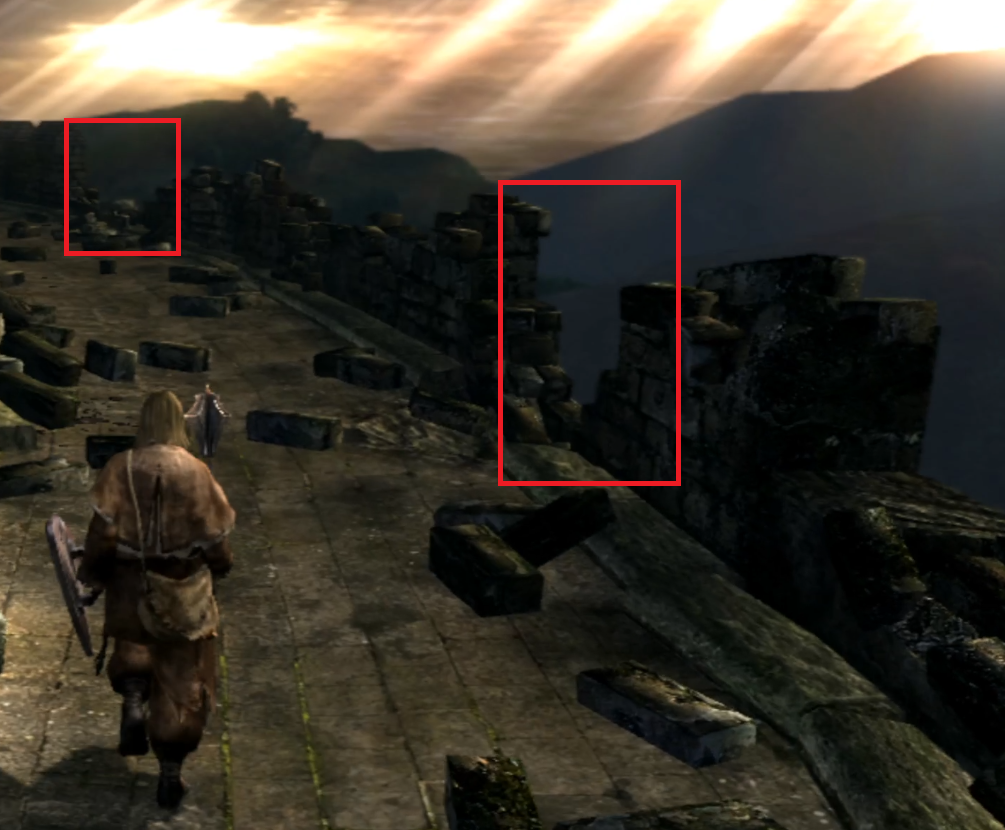 I recall reading a post somewhere about how researchers concluded that Rome couldn’t have fallen due to lead poisoning because testing skeletons showed that they only had the lead build up of an average adult in 1980. Think about that post a lot these days, actually. But the maps in these older games are kinda like corpses, where if you do enough forensic analysis you can determine the cause of death. Or as Daisuke Satake puts it: quote:The concept that it was a series of defenses made to fight against the giants never changed so most of the area actually survived the redesign untouched. I think it’s fun to look at the place and imagine what kind of battles were fought there. Sibyl Disobedience fucked around with this message at 00:50 on Jun 5, 2020 |
|
|
|
Episode 03 (DS3-01): Flushing the AshLudleth of Courland posted:Treat the Fire Keeper not with discourtesy. It’s time for our first game jump as we kick off DS3 with some embarrassing play in the Cemetery of Ash. I want to remind you that area names are incredibly important in the Souls series. Later in the game we go to an alternate reality version of this same area named the Untended Graves. If that makes this area the Tended Graves, who then is the gravetender and what does tending a grave entail? Anyway, many of the locations in Dark Souls 3 are a reincarnation of areas from previous games, particularly Dark Souls 1. In this case, the path up to Firelink Shrine is reminiscent of the outside area after the Northern Undead Asylum at the start of Dark Souls 1, complete with a Broken Straight Sword, which I believe is a reference to your starting weapon in Dark Souls 1, the Straight Sword Hilt. But the DS1->DS3 connection I want to focus on in this area I want to focus on is a bit more convoluted. Because this area used to have water flowing through it. The game rubs our nose in this when we approach the optional Crystal Lizard fight and the puddle in the passage gets just deep enough to slow our movement. So if there was water here, where did it come from and why is it gone? Well, there’s this castle right above us. 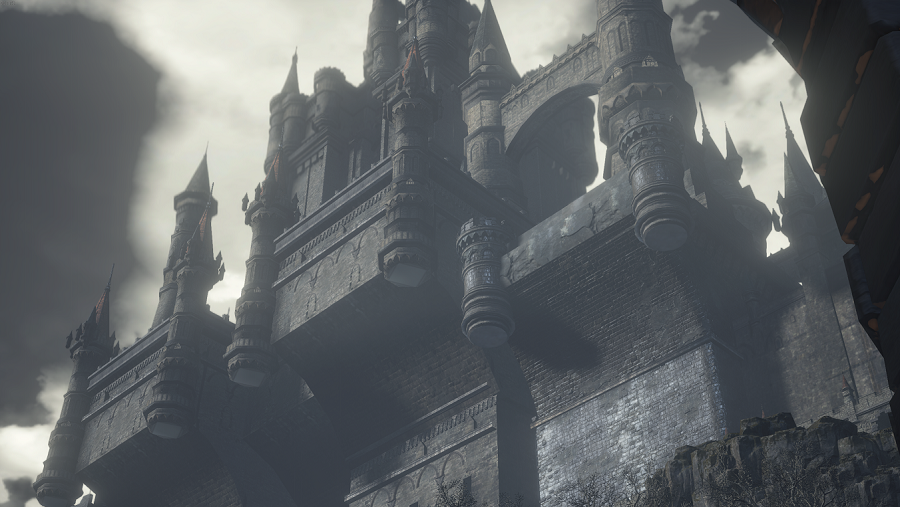 My belief is that Lothric Castle is being pushed up by seismic activity, explaining why this entire area is far above the surrounding mountain tops and why we will eventually need to exit it the way we do. And looking up at the castle from inside the Crystal Lizard's den we see this archway. 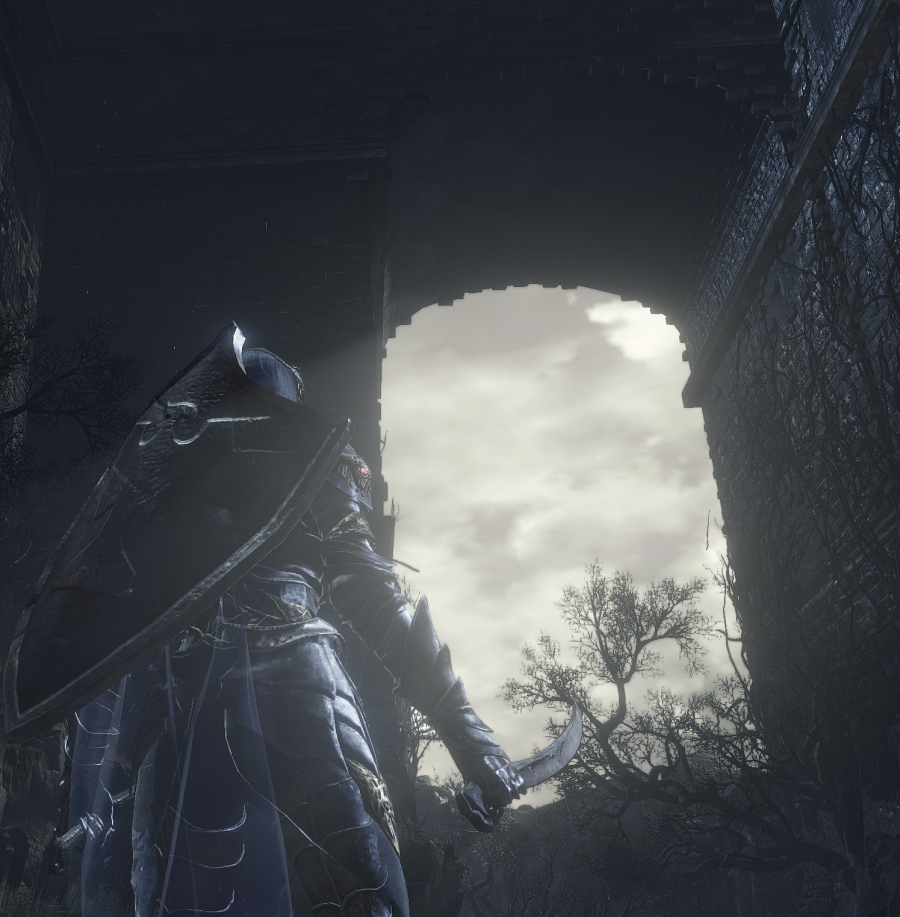 Building an archway so far above the ground here in a dead end corner of the castle doesn’t make a lot of sense. Unless maybe the arch wasn’t designed to be over ground but rather over water. Port, moat, bridge over a river, take your pick. So hypothetically, at some point Lothric had water, which was drained, that process dumped a whole bunch of corpses that became the tended graves in the Cemetery of Ash. Ring any bells Dark Souls 1 veterans? Aside from that, we also have a now conspicuous puddle of water around our first boss fight. It’s rarely made too explicit, but Arthurian legend has a big influence on the Souls series. It’s intriguing that our first boss battle begins both with something akin to pulling a sword out of a stone and, if you’re willing to stretch the definitions of words a little, receiving a sword from a lady of the lake. That boss arena also provides us this view 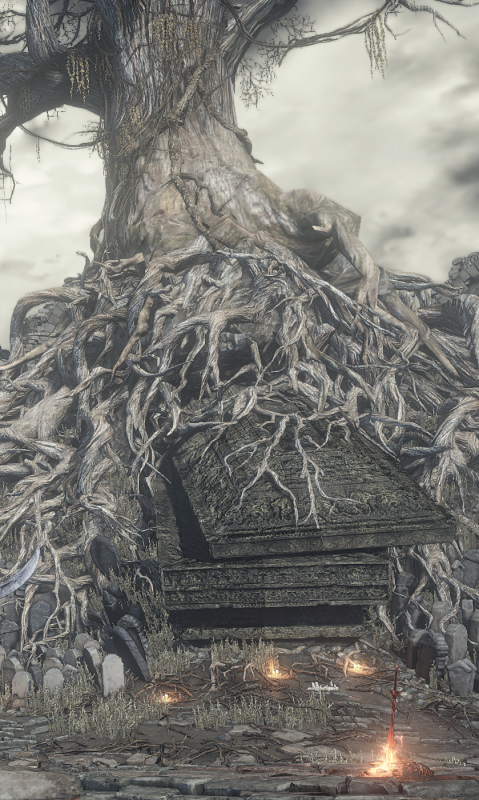 This is the coffin from the intro FMV that was housing the Lords of Cinder. What’s more interesting is the dying tree seemingly growing on top of the coffin, almost as if it lost all of its water, and now its fertilizer has escaped. Meanwhile, there’s something else curious going on with the water in this area. Despite it all being in stagnant puddles, it appears to be flowing, trying to make a pilgrimage back to its home under Lothric Castle.  And to close things off, let’s take a look at the Firekeeper. The intro movie contains two interesting details about her that I never noticed before recording this. First, she appears to be choosing to blind herself, and if that’s the case, she is staring into a whirlpool.  And finally, the first time we see her in full she appears to be framed symbolically inside a crescent moon. 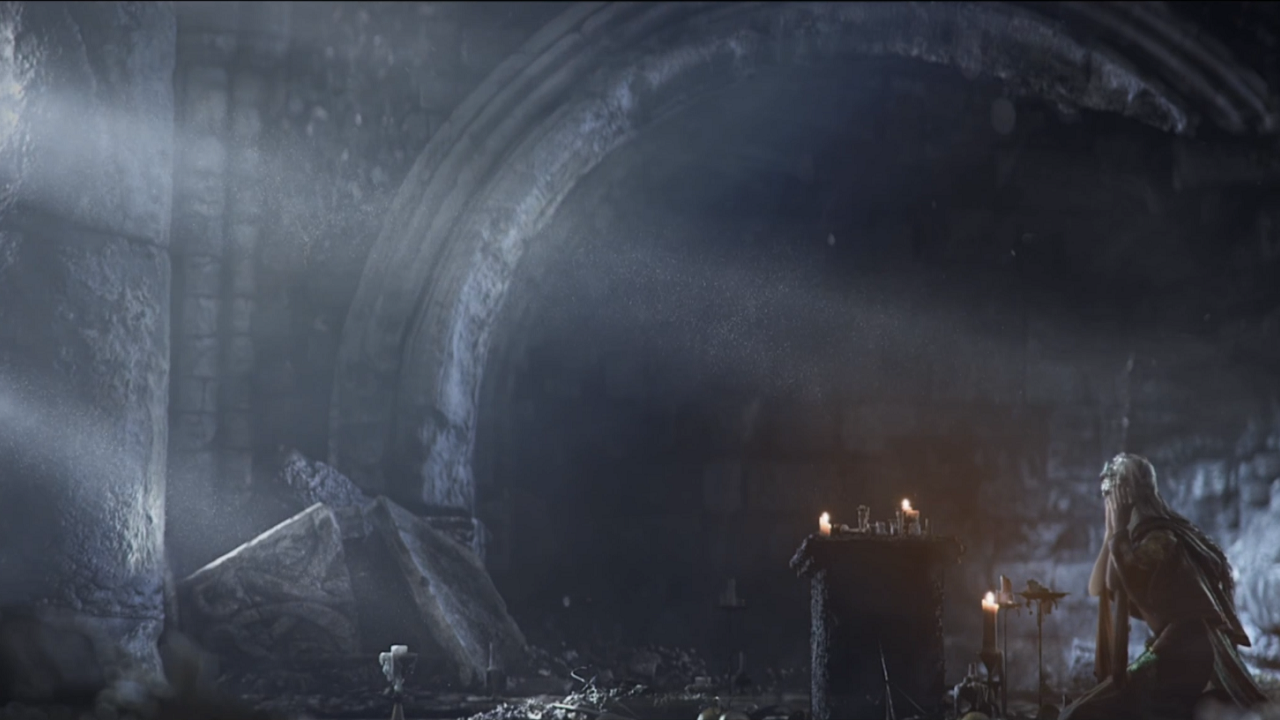 These are both tiny and seemingly insignificant details, but an obsessive attention to detail goes into the making of these video intros, and both of these details are suggestive of elements of the previous games that we’ll be getting back to eventually. Sibyl Disobedience fucked around with this message at 00:47 on Jun 11, 2020 |
|
|
|
Mraagvpeine posted:This seems like an interesting, if overwhelming, project. I doubt I can contribute anything except suggesting you announce your thread in the New LP thread. Overwhelming is a good word for it! This may be silly, but I consider this bit early access and wanted to wait until at least the DS3 intro is up to try to attract any attention. I'm less happy with the DS1 videos. It's a hard game to talk about in isolation because it (understandably) contains a lot less detail in its world design. In an ideal world I wouldn't even start there, but one of the big themes of Dark Souls is that the world is never going to be ideal. RBA Starblade posted:While you said you know a few key bits from it, linking Bloodborne and Dark Souls without playing Demon's Souls seems like a challenge, considering the scrapped references to it in BB. It'll be interesting to see how you think DS2 fits in as well; I always thought its biggest strength was in how it intentionally lies about the previous game, when it's not dismissing it. Lacking Demon's Souls knowledge isn't too crippling. It's just like trying to solve a puzzle when you're missing a chunk of the pieces. Some sections will be unreadable, but you'll still be able to make out most of the overall picture. I do sometimes worry it's at the root of why I can't make interpretive progress on certain sections, like Irithyll Dungeon+Profaned Capital. As for DS2, that game is batshit. It's somehow, simultaneously, the part that I'm both most looking forward to and most dreading. No other game in this series makes me question my sanity the way 2 does...and that might have been what they were going for...
|
|
|
|
Sorites posted:You are an insane person and this is a terrible idea. Oh-hoh! Very good, very good indeed! Take this, to celebrate our acquaintance.
|
|
|
|
Episode 04 (DS3-02): The Lothric Prison BreakOscar of Astora posted:Regrettably, I have failed in my mission... Socrates posted:So now, I replied, watch the process whereby the prisoners are set free from their chains and, along with that, cured of their lack of insight, and likewise consider what kind of lack of insight must be if the following were to happen to those who were chained. I love Dark Souls 3’s area design. From a strictly gameplay perspective I might prefer Bloodborne by a small amount, but Dark Souls 3 refines the way these games tell a sprawling historical epic through the most subtle and minute details. Our introduction to Lothric is a perfect place to examine how this is done. There are three tools I use when I’m trying to interpret the stories being told in these areas. 1. Everything you see is not chronologically concurrent. The flow of time and space are incredibly convoluted in the most wonderful ways. Often what you’re seeing as you move through an area is a societal progression. To complicate this further, I strongly suspect that sometimes this progression branches, and when these two roads diverge you as the player get to take both of them. 2. Everything you fight is not unified against you. The upcoming Mound-Maker covenant is a hint intended to suggest this. Within the area designs throughout the game you are a third party that is viewed as hostile by both sides. This is most explicit within the gameplay in front of the Abyss Watchers boss room, but it applies universally. 3. The stories we are searching for revolve around a question of succession. Civil wars, rebellions, insurrections, and usurpation of leadership roles within the hierarchy of society. With all that said, let’s break down this upper portion of the High Wall of Lothric. We have three major plot hooks that do not connect to each other in any obvious way. First, we have hollows who are turning into trees. Second, we have hollows who transform into the Pus of Man, an enemy that is similar to a smaller version of the second phase of Iudex Gundyr. And finally we have the Lothric Drakes, one dead and one very much living, with the live one invoking the fire breathing drake bridge motif we saw at the end of Undead Burg and which is also referenced in the other games of the series. We’re going to put a hold on the tree plotline until the next area and focus on the Pus of Man and Lothric Wyverns. And we’re going to have to have minor spoilers for an area we won’t be entering for quite a while. The wyverns we see seem to be native to Lothric itself. Later when we revisit this area we come across an area called the Dragon Barracks, which (for now) I’m taking as an implication that the drakes were integrated into Lothric’s military. Immediately after the Dragon Barracks we will fight the Dragonslayer Armor. This suggests that there’s a war going on where a major focus is whether the wyverns will be allowed to live. We start the High Wall of Lothric in a tower along the wall, and in both directions we go to towers that contain classic dragon-slaying weapons in the Souls series. In one direction is a Gold Pine Resin, an item that temporarily coats your weapon with lightning, a classical weakness of dragons that was showcased in the opening cinematic of Dark Souls 1. In the other direction we have a Longbow, the weapon many players used to sever the tail of the Hellkite Wyvern in Undead Burg to obtain the Drake Sword. It also recalls a major moment of dragon-slaying in Oolacile in Dark Souls. The most interesting bit is the third tower though. Here we find a mimic with a Deep Battle Axe, a weapon permanently infused with dark damage at the cost of scaling. This one is curious because dark has no association with dragon-slaying at any point in the series that I can recall. But it does have an obvious link with the Pus of Man enemies that inhabit this area. My theory is that the mimics we see throughout the games represent technological progress in warfare that ultimately doom the society that utilizes them. In this case the insurgents used the power of dark to wage their war, and then used that darkness to parasitically enslave the wyverns (or their corpses). This explains why later when we encounter two wyverns at the Dragon Barracks are symbiotically linked with their own Pus of Man. Another clue pointing towards an insurrection is the disparate equipment of the enemies in the area. On one hand we have a handful of knights along with lesser hollow soldiers wielding cheap weapons like spears, wooden shields, and crossbows. On the other hand, we have enemies like the large hollows wielding great axes and assassins skulking in the darkness. These are not conventional military troops, which suggests we are in the midst of a revolt. In support of this, the large hollows drop Raw Gems. These are worthless to highly leveled characters due to their lack of scaling, but they would be ideal for an insurrection hoping to overcome the well-equipped and highly trained Lothric Knights through sheer force of numbers. We also have a possible hint at one of the insurrection's goals. Most players never consider this, but early on in this area we travel through a jail cell. 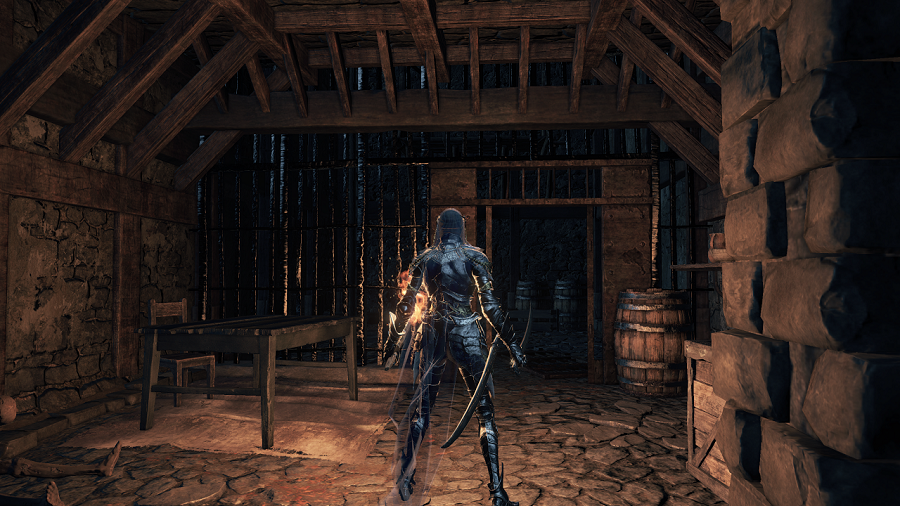 Why is there a cell? Who did it hold and what was their crime? And where did they escape to? The cell as we see it wouldn’t be very secure, unless the ladder we climb was something thrown down by someone to help the prisoner escape, a motif reminiscent of how we are aided in escaping from our cell at the start of the original Dark Souls. 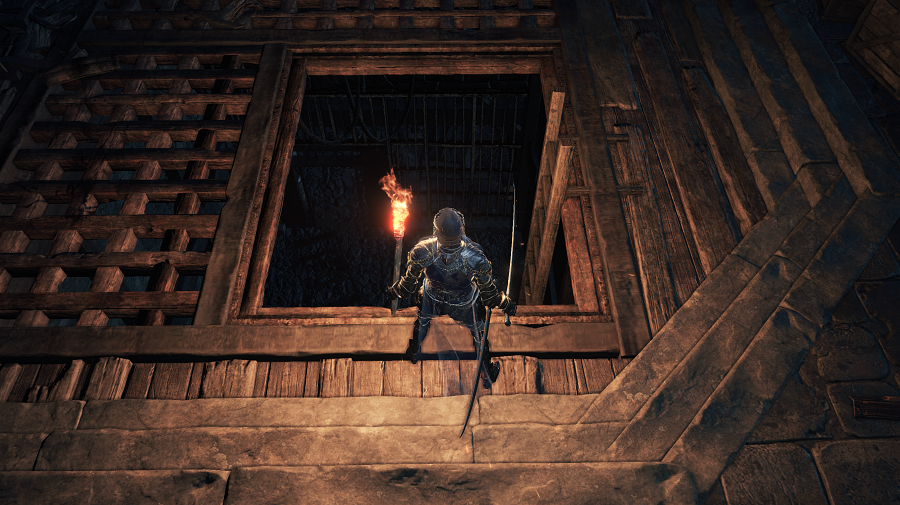 Another intriguing visual element of this area is how the bars on the upper level resemble Anastacia’s cell in Dark Souls 1’s Firelink Shrine. 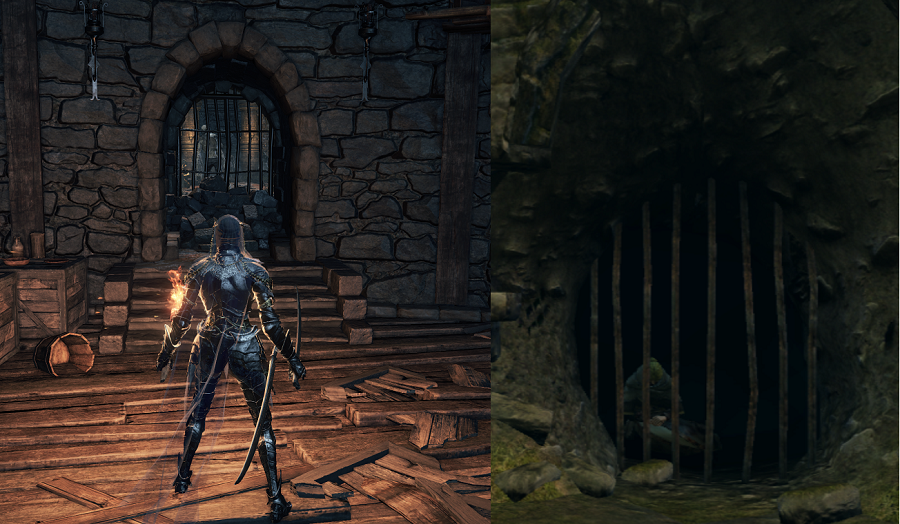 Anyway, one possible avenue of escape for our prisoner is the very room where we entered the area. Behind us is what appears to be the coiled sword of a disabled bonfire, something someone might have used to escape before it was dismantled. The cobwebs around it are a curious inclusion that I never noticed before writing this. 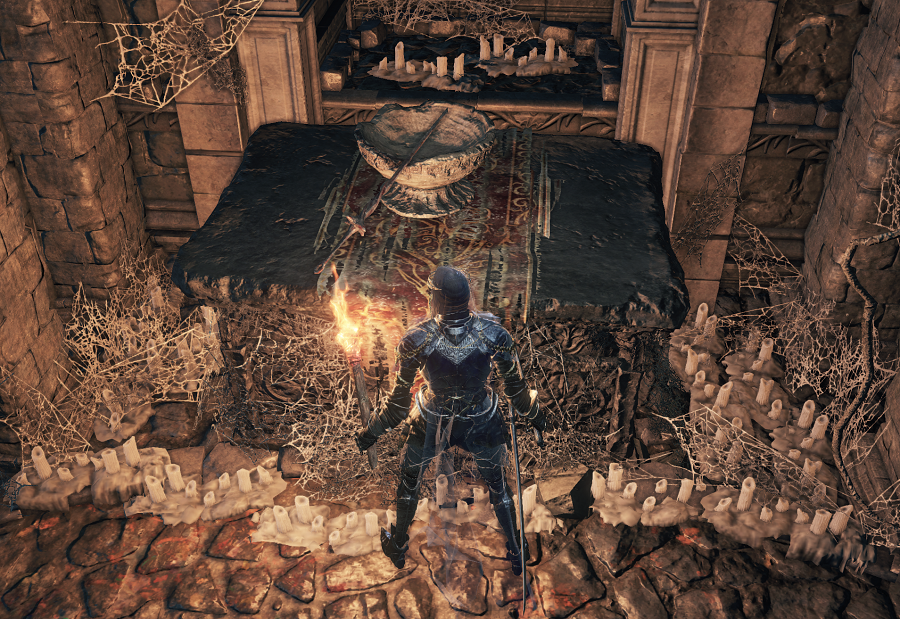 Oh, and because what would one of these writeups be without some kind of water imagery, when you first enter this area and warp into this room directly below you is a clogged drain. 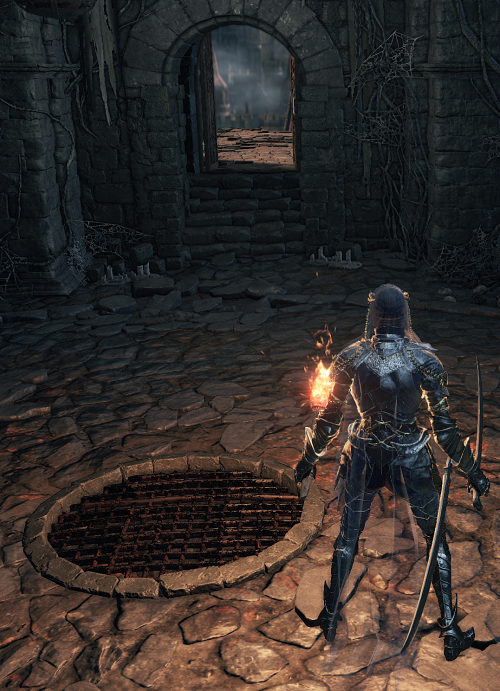
|
|
|
|
Araganzar posted:One, do a "Let's Play Soulsborne [Reborn Reborn Edition]" and slow play this a lot more, spread out the posts and info over time. There's no real opportunity here for people like CJacobs who have a ton of lore knowledge to comment. Even being a huge soulsborne lore fan you make so many points so fast I can't retain much of it. Spread this out more or you will lost your audience and burn yourself out. Maybe put meta and speculative comments (e.g. unsupported by game literature or designer statements) in a separate post. This may seem either silly, but given conditions I'm worried about running out of time. If I wake up now I'll forget everything. The release speed will probably slow some in the future. I don't have as much access to acceptable recording time as I'd like. I do worry a lot about accessibility. I've been playing around with the idea of making cluster summaries that focus on what happened during ~3 video sections and the major details. It's easier to do what I've been doing and distill it into its essence than working in the other direction, if that makes any sense. quote:Two, look into RPCS3 and see if you can play Demon Souls. Some of this is fascinating (like the Hellkite Dragon killing weapons in Lothric) but this is like analyzing Game of Thrones and not reading the first book or watching the first season of the series. Demon Souls is the foundation of all of these games. I'm not going to invest in this deep a run that's not informed by the first game unless you are going to LP it eventually. If you spread this out a bit you will have time to do this. I might crack and play Demon's Souls regardless of how much I dread it. Regardless, I think you're vastly overestimating its..."essentialness." Game of Thrones is linear storytelling. We don't even think of it as linear storytelling because almost all human narratives are linear, and we forget there are even alternatives. Soulsborne is not linear. When I was first trying to fit all this into some kind linear narrative, I started trying to fit it all into shapes like this. 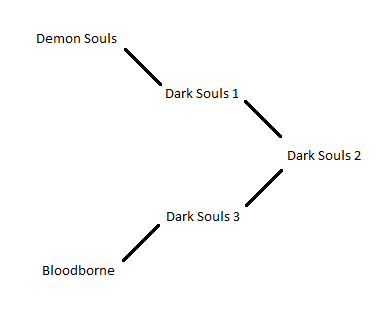 And maybe I haven't completely abandoned the chaos going on here, but it's absolutely not the best way to frame things to make progress in understanding what's going on. Soulsborne is better thought of like this 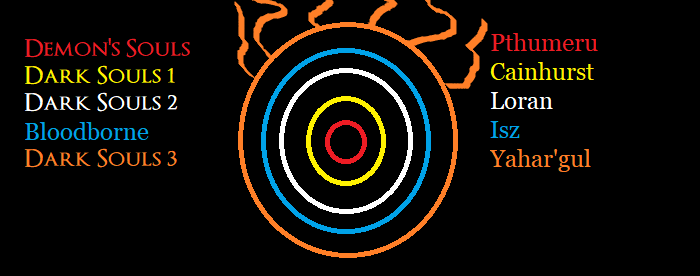 Each game is repeating the same structural myth with its own individual mutations. The same thing applies to the kingdoms within the games (the Bloodborne progression on the right is just an example and may not necessarily be an accurate order). It's like how various cultures all have their own flood myth, but with the details being uniquely influenced by local conditions. But to complicate things, Souls games have gaps in them. 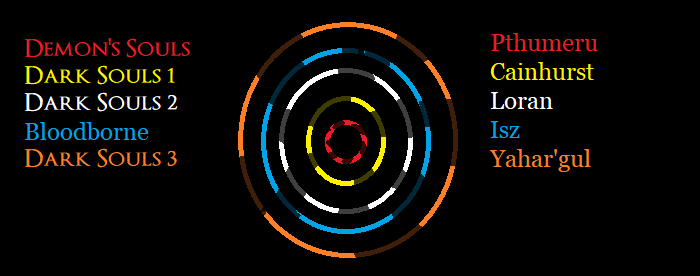 So what we see looks more like this. We can use the echoes of one game to try and fill in the gaps of other games. Demon's Souls would certainly be helpful for this, but it's not really more foundational. If anything, it tends to be a lot easier to use the later games to explain the earlier ones, because honestly, FromSoft just now has the resources to include more detail in its worlds. So with that said, let's make things even crazier. This bit isn't super essential, and it's really nbd if it doesn't pan out, but I'm hopeful because it's so fun. If we were going to do something like this with repeating stories with holes in them, we might cut up the story progression into sections. In which case we'd have something like this.  But framing it like this is fun because it starts to look like this popular graphical depiction of the hero's journey/monomyth.  FromSoft/Miyazaki has certainly had monomyth on their mind based on the item description for Ricard's Rapier in Dark Souls 1. A rapier with intricate decorations. Chosen weapon of the famous Undead Prince Ricard. Ricard's exploits are told in a monomyth. He was born into royalty, but wandered the lands in a fateful ill-conceived journey. He became Undead and disappeared up North. But what people miss is that the monomyth isn't about you, the player; it's about a monarch, and presumably the fate of their kingdom. We're simply living their echoes. So if FromSoft has their own internal monomyth structure that repeats itself throughout all of these games, what if the design document has been sitting in front of (or behind) us the whole time? 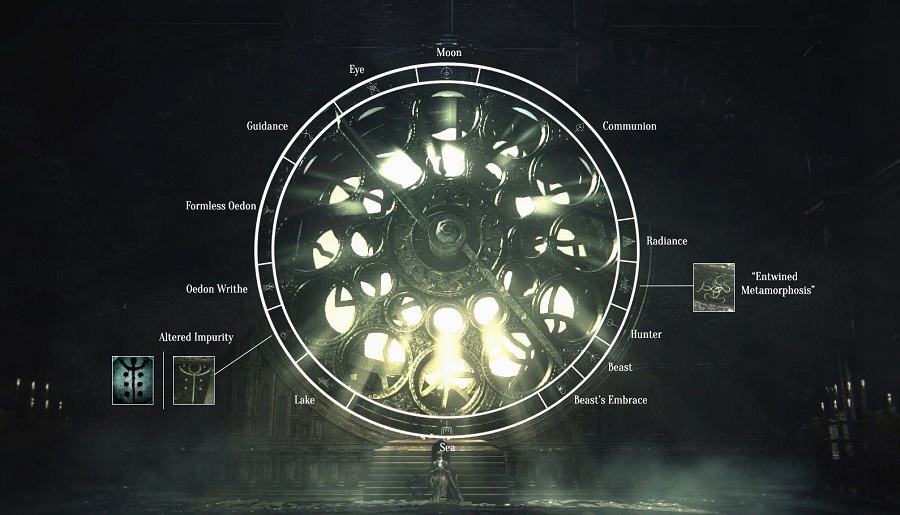 Used to slaughter the Vilebloods in Cainhurst. Bathed in pools of their blood, and forever steeped in their ire.
|
|
|
|
ilmucche posted:This is all pretty wild stuff, interested to see if I'll agree, disagree or just think it's all insane. If I do my job right, the answer is going to be yes. Anyway, thank you everyone for the feedback. This is attempt #4 to turn this into something palatable for human consumption, and it's probably only going to end up slightly less of a failure than the others. Knowing where I'm going there's certain things I cannot cut, but I'm going to attempt something at the end up the first age that will hopefully help alleviate the overwhelming density. Also, going to try not timg'ing the next update since it's more visual and less text based than the others. We'll see how that goes.
|
|
|
|
Episode 05 (DS3-03): The Lothric Civil WarRed Tearstone Ring(DS2) posted:A ring set with a red tearstone. Blue Tearstone Ring(DS2) posted:A ring set with a blue tearstone. Time for the second half of the High Wall of Lothric, and as it turns out, cutting it in half is rather appropriate. One of the most intriguing things about this area is that the environmental narrative completely changes halfway through the level. As we talked about last time, the first half is dominated by three storylines: tree hollows, dead wyverns, and the Pus of Man. After we leave the bonfire and move on to the next section, we experience one short section featuring all three of these elements. Once we climb down the ladder, they never show up in this area again and are replaced by three entirely new narratives. Why this is the case is never made clear to us, but any theorists should keep in mind that time and space are convoluted. But before we get to these new narratives, there’s one bit of environmental storytelling that I love. 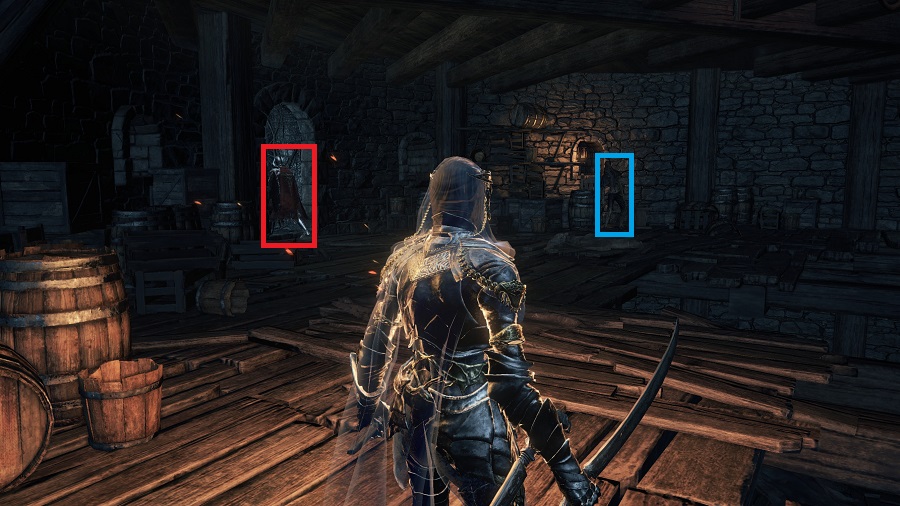 To enter the tower housing the halfway bonfire of the level, we have to get past the single Lothric Knight [red square] of this section. It’s one of the more challenging enemies of this stretch, but it’s also a skippable fight if you wait for it to patrol and sneak past it. Behind the knight is a dark tower full of Hollow Assassins [blue square]. We tend to assume everything we fight is allied with each other, but what if these assassins are sneaking into the tower just like we are? ------------------------------------------------------------------------------------------------------------------------------------------------------------------------------------------------------------------------- 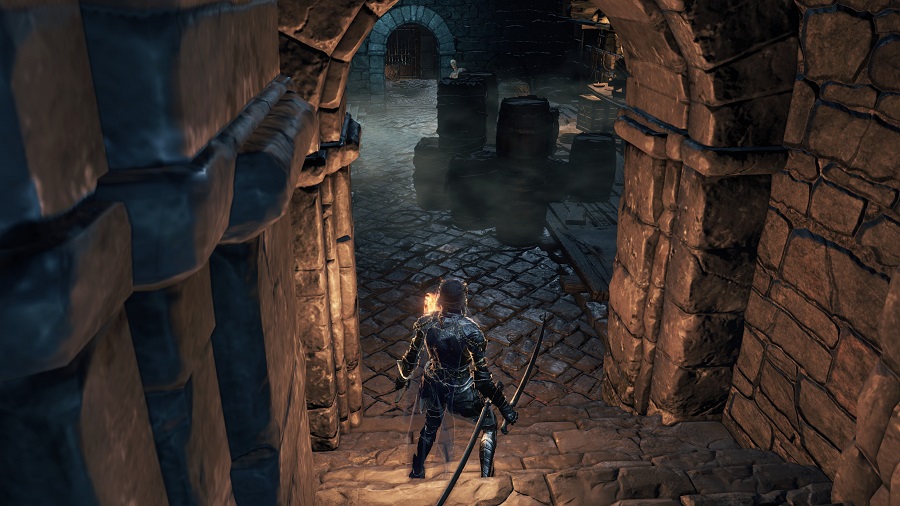 On the bottom floor we can exit into a different section that begins with a firebomb tossing hollow that has set up an explosive ambush. A peculiar thing for a traditional military to have sitting inside their own stronghold, but it's a much more logical improvised setup if they’re a member of an infiltration squad guarding the rear. ------------------------------------------------------------------------------------------------------------------------------------------------------------------------------------------------------------------------- 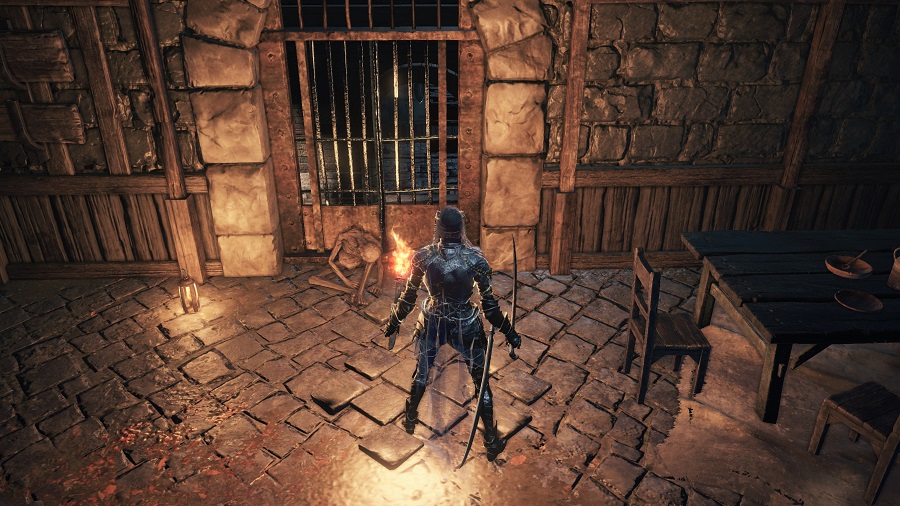 After this we enter a room with another Hollow Assassin and a corpse with an item that is sitting against a peculiarly placed and unusable gate. ------------------------------------------------------------------------------------------------------------------------------------------------------------------------------------------------------------------------- 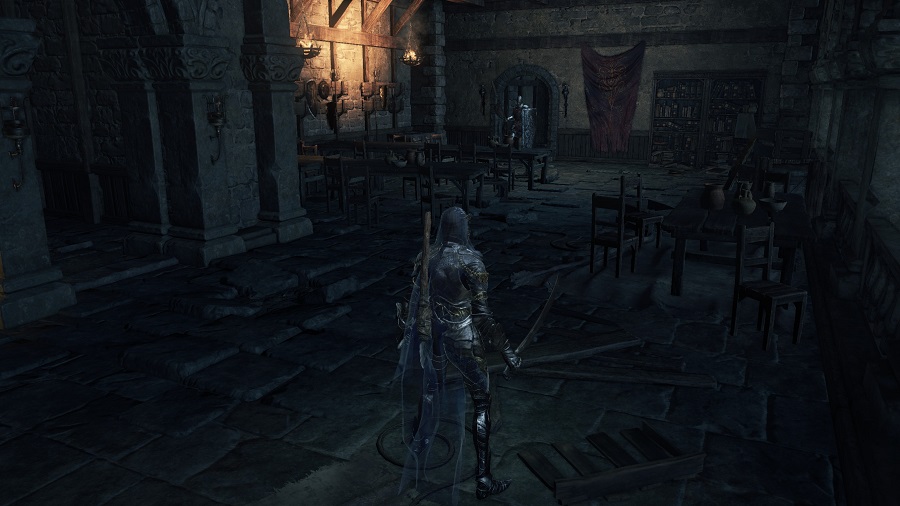 Jumping ahead a bit, once we leave this tower to move on to the next area, at the bottom of the ladder is a sort of mess hall patrolled by a second Lothric Knight. To the left here is a small room where several plain hollows are setting up an ambush. I like to think of them as the cooking staff. Behind them we arrive here. -------------------------------------------------------------------------------------------------------------------------------------------------------------------------------------------------------------------------  This room houses the only Hollow Assassin in the level not found inside the previous tower. It also happens to be the other side of the peculiar gate. The implicit story is that the Hollow Assassins are infiltrating the area to assassinate the Lothric Knights. This is hinted at by the Deserter Trousers they occasionally drop. Additionally, the item in front of the gate is a Mail Breaker: quote:A small sword made for thrusting attacks. Not only is it a weapon designed for dealing with heavily armored targets, it might also be what they used to pry open the gate that its holder is resting against. ------------------------------------------------------------------------------------------------------------------------------------------------------------------------------------------------------------------------- So anyway, getting back to the three new narratives replacing the three old ones. One of them are these dudes:  But they come back in the next area, so along with Emma back there and Vordt, we’re going to talk about them later on when we have more pieces to their respective puzzles. For now, what I want to focus on is this: 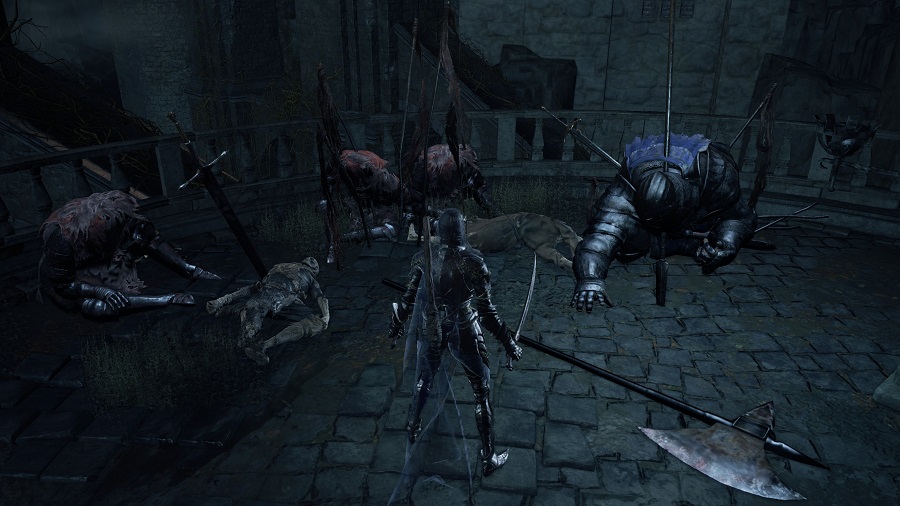 There’s a civil war going on with red and blue armies. It’s interesting how the proportions of both types of corpses are significantly larger than the typical hollow, with the red knights here looking somewhat similar to the upcoming Abyss Watchers, and the blue Winged Knights shaped more like Smough from DS1 or the executioners from Bloodborne. Anyway, the area only has a single Winged Knight patrolling a courtyard, possibly implying an eventual blue win. In that courtyard we have a rather noteworthy statue. 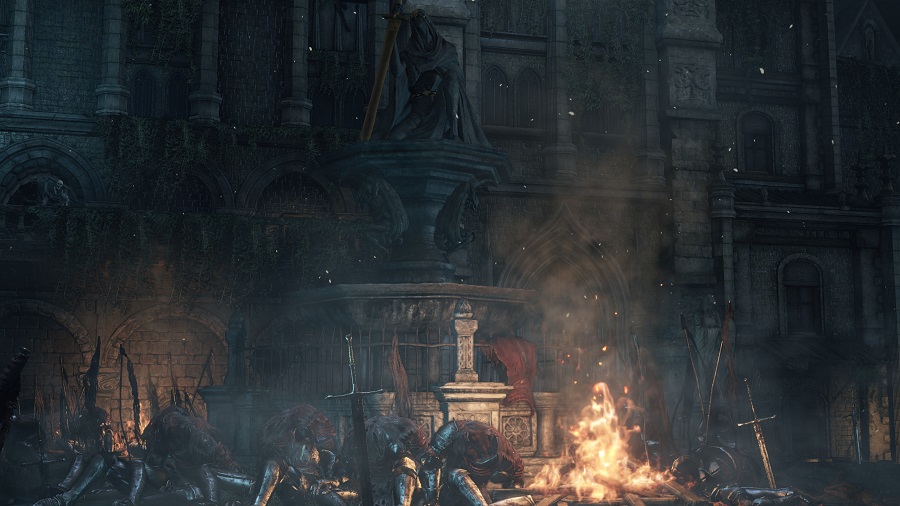 There’s a lot of debate on the internet over who this is, but I’m not going to treat that as important right now. Instead, I want to draw your attention to the knights in red that surround the statue. My interpretation is that the red forces were rallying around this figure, and ultimately gave their lives in their defense. (Side note: it might be difficult to see, but the features of the statue that people argue over, specifically the sword and the bracelets, are a different color from the rest of the statue. This could be simply done for visual emphasis, or it could suggest that those embellishments were added later, a usurpation of the statue’s originally intended purpose. A religious figure reinterpreted as a conqueror.) Anyway, this isn’t the only noteworthy statue of the area. Exiting this courtyard we come across these headless statues: 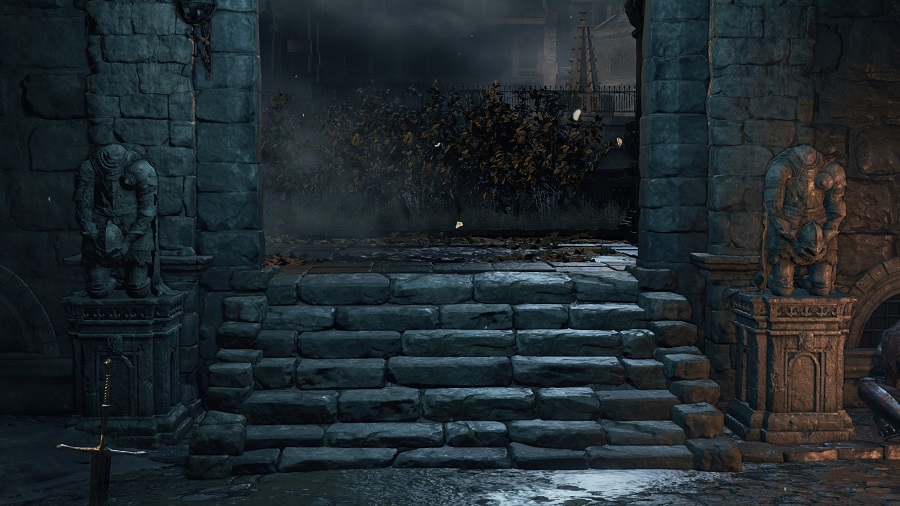 And then shortly after we go through these complementary statues:  The path to the cathedral ahead might be suggesting that these statues are part of a repeating cycle. 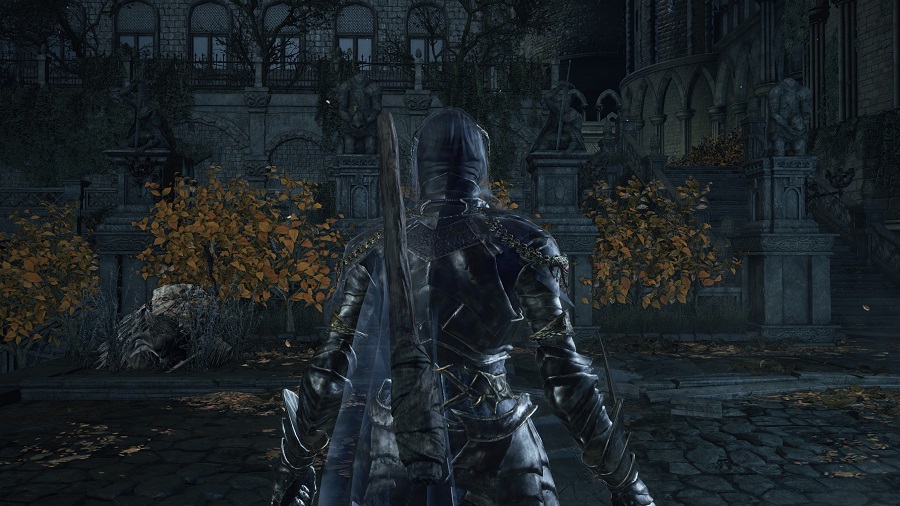 What I really want to focus on is this statue in particular. 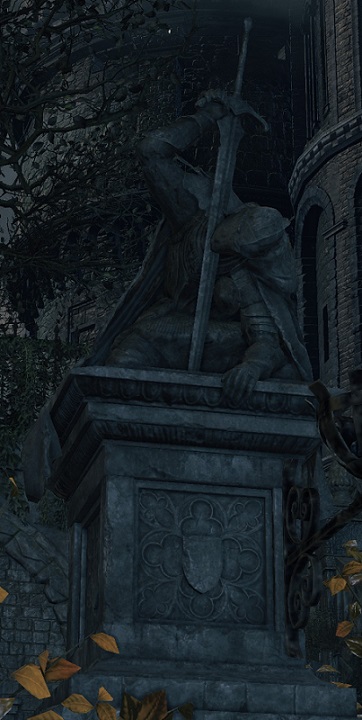 Because if you’ve played all of the recent FromSoft games, you’ve seen something very similar to this in a different context (that I’m personally going to draw the line on not spoiling). So suppose this beheading cycle is a ritual with a very similar result of that other self-decapitation, and that in Lothric “linking the fire” is a sort of euphemism for that ritual. That interpretation makes the item description for Soul Stream (a spell from a later portion of Lothric) pretty interesting: quote:The first of the Scholars doubted the linking of the fire, and was alleged to be a private mentor to the Royal Prince. So maybe that one really prominent statue has its head because they’re from a faction who doubted the linking of the fire, a choice the knights in red defended to the death. The mourners of the undeserving dead. Alternatively the red faction is the pro-decapitation side, and that’s why they all appear to be missing their heads. Cinders of a Lord posted:The Lothric bloodline was obsessed with creating a worthy heir, and when this proved impossible, resorted to unspeakable means. Suffice it to say, the path to linking the fire is a cursed one indeed.
|
|
|
|
I certainly can't prove beyond a shadow of a doubt that there was a civil war. All we have are environmental clues and item descriptions, and nothing in there provides us a definitive answer. That being said, alternative interpretations would need to address why there are so many corpses strewn about that area. If they were fighting together, what were they fighting and why is there no sign of it? And if you buy my explanation that there are signs of infighting in the upper sections of the High Wall, why not extend that explanation to this courtyard? Part of the problem telling this story is that I think clues for what is going on are strewn all over. In this case not only in all of DS3 but in previous Dark Souls as well. And if this comes off as excessively dense now, you should try listening to me bounce between games. I'm trying to build a case slowly, and that entails bringing up my interpretation of an area plot when I come across it, and coming back to it later on when I've played through later stretches that provide more circumstantial evidence. That being said, here's a slightly more complete version for those who remember enough not to be overwhelmed. The blue Winged Knights have an armor set with this as a description: Armor of the Winged Knights, who swore themselves to the Angels. Worship of the divine messengers was viewed as heresy in Lothric and unrecognized by any of the Three Pillars of rule. This is believed to be why Gertrude, the Heavenly Daughter, was imprisoned in the lofty cell of the Grand Archives. "Heresy" and "unrecognized" further point to the idea of the chaos we see in Lothric as being a result of an Angelic Faith uprising. It also explains the assassination plot against the knights who make up one of the Three Pillars. I didn't draw too much attention to it, but next to the chapel where we get the Way of the Blue covenant from Emma is a red-eyed enemy that also happens to be the only Lothric Knight in blue. My theory is that red-eyed enemies are a representation of a major storyline actor who invaded or betrayed the denizens of the area you're currently in. This is a little more speculative, but if I had to guess the Red team is related to the secret fourth Pillar, which is the hunters and the Black Hand. This eventually leads to the Abyss Watchers. This divide is essentially DS3's World Tendency. Lothric being pulled in Red and Blue directions. Meanwhile, you have the Scholar pillar who doubts linking the flame, and possibly wishes to prevent both the Blue and Red paths from coming to fruition. "What do you want, truly? Light? Dark? Or something else entirely..." And what might be one of the sticking points to the divide? Well, it could be hinted at in DS1, but I think DS2 is more explicit about it if you think about the choice of bosses you have in the Heide's Tower of Flame... Don't trust the symbolic pattern though. DS2 is a mirror, and mirrors are often deceptive. As for "Linking the Flame," setting this up is a bit too heavy for me right now. I suspect each game might use "linking the flame" slightly differently, but I suspect they all share a relation to the myth of Cronus and leave it at that.
|
|
|
|
I'm glad to hear it! And if you think things are wild so far, stick around because this is positively tame compared to where we're going...Oh how I wish I could sequence break my own LP. Anyway, in more general news, I'm hoping the next stretch won't end up delayed. It's the start of Bloodborne, and recording PS4 stuff is a pain compared to everything else on the PC. Current plan is to do Central Yharnam as a 3-parter, and then finish off the section by ringing the first Bell of Awakening back in DS1. What I'm then going to attempt is to create a short summary video for everything up until that point that quickly runs through the important events. Ideally, this abridged version will allow people to follow along without having to deal with the full density, and then point them to any individual sections they might find particularly intriguing. Of course it might fail to accomplish any of that, but what would a Soulsborne LP be without some failures here and there?
|
|
|
|
Blaziken386 posted:interested to see where you go with this! Well, some teasers include the player character performing an orchiectomy, Aldia saying trans rights, and an in-game reference to a late 19th century author who definitely wasn't a closeted transwoman because such things obviously didn't exist back then. Sorry to assume what you might find intriguing, but I couldn't resist the opportunity to foreshadow a small fraction of the insanity that I can't wait to get to.
|
|
|
|
RBA Starblade posted:I wonder what it says about me that I instantly knew what this was referring to If that includes the third teaser, that's really impressive. It took me quite a bit of work to dig up that one. Anyway...
|
|
|
|
Episode 06 (BB-01):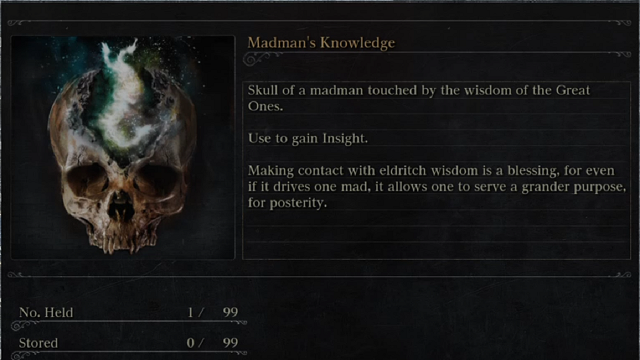 It’s funny. I’m finding Bloodborne to be almost a breather between Dark Souls sections. I’m going to have the least to say about it, at least early on, but Darkroot Basin triggers Dark Souls 2, and we need to have been to Hunter’s Workshop and Hemwick Charnel Lane before that happens, so here we go. Let’s begin by laying out the framework I’m using. First, we awaken on the night of the Hunt, but it’s not a “night” in a traditional sense. As the note in the Hunter’s Dream tells us:  And let’s combine this knowledge with the note in the Operating Room that I totally skipped over despite it being one of the few things I actually scripted:  Things are going to get vaguely spoilery for a bit, but it’s unfortunately necessary to set up the cosmology I’ll be operating within. Bloodborne has 3 endings that I’m going to refer to as ending 1, 2, and 3 in increasing complexity of trigger conditions. People like to assume based on ending 1 that you’ve ended the night and brought day to Yharnam, but I disagree strongly with this interpretation. In ending two, you do not transcend the hunt and the night does carry on forever. This is because you did not halt the source of the spreading scourge of beasts. You also fail to halt the source in ending one, so the night is still going on. You personally have merely escaped to the waking world. I see the Night of the Hunt as an eternal purgatory, a punishment for its denizens for some long forgotten sin. As I put it in the video, it’s a Lovecraftian Groundhog Day. As a result of this, the game never contains a “real” Yharnam. It’s just layers of dreams upon dreams. Echoes of the histories of it’s imprisoned inhabitants. Everything therefore operates on a sort of dream logic, more of a Lynch-ian exploration into the subconscious of its subjects than a truthful replication of whatever once passed for “actual reality.” And because it is formed from subconscious memories, it will lie to us. With enough insight we can begin to see through these lies. Or maybe go mad. Por que no los dos? With that out of the way, let’s introduce something even crazier. I believe that Bloodborne repeatedly utilizes this iconic bit of dialogue from Aldia in Dark Souls 2. quote:Many monarchs have come and gone. This becomes more important later, but I suspect the introductory cutscene hints at this with the blood werewolf, the flame, and the messengers. You likely find this ridiculous, but if you stick around maybe I’ll be able to put together a convincing case for it. There’s a lot to be said about how Gehrman, the Doll, and the Messengers relate to each other, but I want to gather more evidence before I start speaking about that. For now I just want to observe that when the Doll says “you’ve found yourself a hunter,” she is almost certainly speaking to the messengers not the blood minister, as if they usurped his ritual. It’s also interesting that Gehrman pauses before giving you his name. Almost as if the name “Gehrman” is foreign to him. Anyway, the real meat of this section revolves around the Madman’s Knowledge. Most people will probably get their first insight stumbling upon the Cleric Beast, but we're starting off by going a bit out of our way because I feel the consumable insights tell a more interesting story right now. Like the Mail Breaker in my previous episode, The Lothric Civil War, I suspect the placement of certain items is done very deliberately to tell a story. Armor clumps is one likely example of this, though it’s admittedly one I haven’t made a lot of progress on. I suspect Flame Butterflies in DS2 is another that I suspect holds a secret. But Madman’s Knowledge is the one I’m feeling most confident about, and this stretch of Yharnam holds two of them. 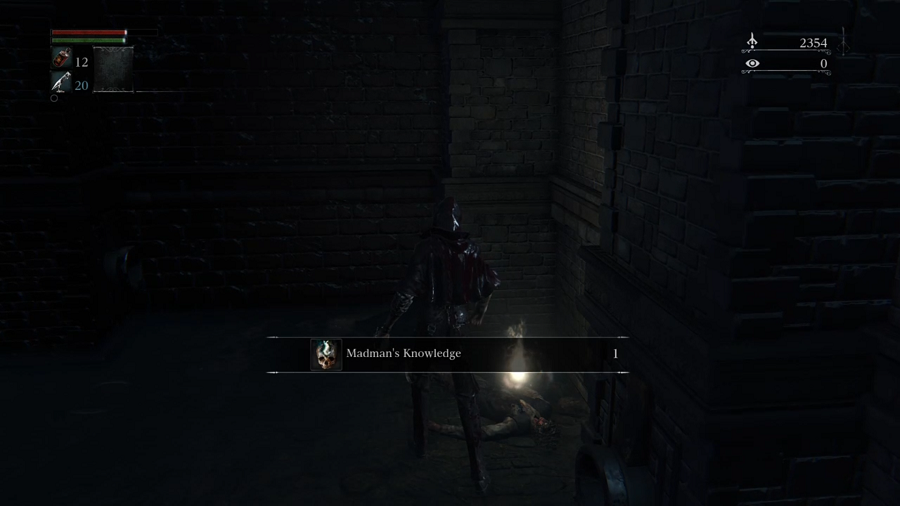 The first is found here, formerly surrounded by rats in a non-descript dead-end. But when we turn around… 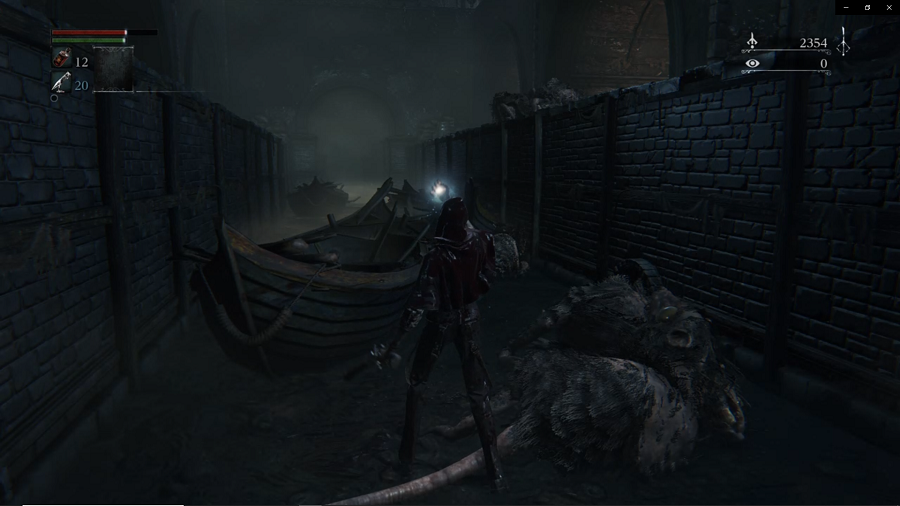 There are boats... This area used to have way more water flowing through it, and was possibly a port of some kind. 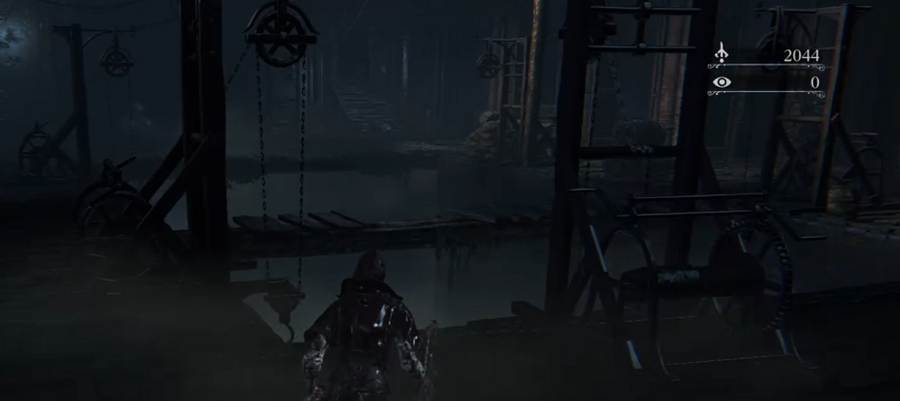 These devices had been perplexing me for a while when someone who was watching me play pointed out that they could be used for loading and unloading cargo. That leaves Madman’s Knowledge #2, and I admit, this one is a little too Crack-Ping for even me to feel fully confident in. There’s an interesting parallel where one Knowledge is “guarded” by rats and the other is guarded by crows (or ravens, but most game material calls them carrion crows, so I'll refer to them as that). And the crows are a curious enemy because of how bizarre they look when they attempt to fly.  People have floated the theory that this inability to fly is a result of the beast curse causing them to overeat until they were too bulky to maintain altitude. But what if they’re incapable of flying because the environment they've been evolving in was aquatic, until someone drained their habitat? This one's admittedly a longshot, and the only real supporting evidence I have for it is that the bulk that they have might not be from overeating but rather something they previously used to maintain aquatic buoyancy. Admittedly, that theory is way out there and is possibly an example of one of those theories I'll end up abandoning in a couple weeks. But while we're here, I'll just mention that the pebbles the crows often drop are definitely petrified eyeballs. So that's fun. Sibyl Disobedience fucked around with this message at 19:57 on Jul 5, 2020 |
|
|
|
George posted:I’m three videos in and annoyed that I’m hooked. I wish you edited your videos, or did post commentary, or anything at all to help you present the really interesting stuff you’re trying to tell us without stumbling over everything. Right now by trying to play and explain at the same time you’re compromising both. Oh, believe me, I know. I hate these things and cannot relisten to them. But learning to let people see something before it's perfect is part of my penance in this ritual. In the long-term, more scripted stuff is the plan. I'm scripting out the first for after the ringing of the first bell, and the only hold up will be figuring out how to make Reaper and Premiere play nicely. But part of doing what I'm doing now is just getting footage. For instance, I could talk for 30+ minutes about Solaire and Siegmeyer, but to do it in video form I need at the very minimum footage of Lost Izalith, Irithyll, Profaned Capital, Cainhurst, and Dragon Shrine, and right now I just don't have the saves to capture all that. This project is a stepping stone, and honestly, going through it like this and doing the post video writeups have been helpful at both making new connections and organizing my thoughts. quote:And there’s already been a couple of times where I’ve wished you tied some threads you’re holding to Demon’s Souls. Maybe when the remake drops you can do a coda of sorts. Yeah, I'm suspecting something like this is inevitable. Valley of Defilement in particular is somewhere I know enough about to see hints of in a lot of different areas and narratives. Lord_Magmar posted:Personally, I've never liked the thought line that we don't visit real Yharnam. It rings false, especially with the first section of the DLC being what it is. Instead I argue that what's real and what isn't is largely unimportant in the Bloodboren cosmology, it's all "real" it's just how much of it you can see/visit. In the case of the Yharnam most of the game takes place in, that's a physical location on the Bloodborne equivalent of Earth, it's just being invaded/stolen into the Dream of the Great Ones. The actual purgatorial area is also the DLC zone imo. From my perspective, if you're seeing game Yharnam as somewhere "invaded/stolen into the Dream of the Great Ones," then that's already quite different than what most people think of as "real Yharnam." But yeah, I agree that there is a certain unimportance at this point what is and isn't real. Breaking it down into finer details, my "not realness" for game Yharnam has two important properties. First, all the areas you visit never existed in a single chronological moment. This is most blatant w/r/t the change in Hypogean Gaol, but I believe it extends beyond that. Second, the areas you visit would not have been physically connected in the way you experience them. Again, most blatant getting to Yahar'gul, but the connections between places like Cathedral District and Old Yharnam are more symbolism than a true depiction of physical reality. DS2 specifically uses this map design motif in ways where they go out of their way to draw attention to how physically impossible many of the zone transitions are. So in summary, time and space: convoluted. As for the looping, Djura and Eileen talk about having visited the Hunter's Dream, but there's no reason to assume that their iteration of the Dream was identical to yours. Maybe time flowed relatively normally until about the time you showed up. Maybe each generation has its own loop that it has to break out of. With that said, I really want to talk about looping and purgatory, and I've decided I do not want to wait a really long time to be able to do it, so I'm going to spoiler chat stuff that way ahead of where the playthrough currently is. It would actually be incredibly helpful to be able to talk about some of these things ahead of time to iron out bugs and communication failures. So anyway, Bloodborne and purgatory. The Hunter's Dream and the Painted World of Ariandel are a useful instance of resonance leading to thematic transmission. Both areas feature a trinity: Father Ariandel, Sister Friede, and Painting Woman for DS3 and Gehrman, Moon Presence, and The Doll for Bloodborne. We know explicitly that Friede has some kind of control over Ariandel. She won't allow him to burn the Painted World, and as a result he appears to be stuck in a loop of painting the same picture over and over. So let's map that onto Gehrman and Moon Presence. The narrative slice of Bloodborne you experience is infinite looping, implied by the replace Gehrman ending, and it is looping because Moon Presence demands to be fed. This process is first suggested in the motif of the Gaping Dragon in the Depths in Dark Souls 1. As they describe it in the Dark Souls 1 design works interview: Yes, it was completely consumed with the desire to eat, so much so that it began to adapt, and the parts of it's body it no used such as it's head, began to retrogress. It no longer eats with it's mouth but takes food directly into it's body, but it had to change in this way in order to survive. Aside from eating It's lost any faculties it may have once possessed and has to survive in this desolate, harsh environment by eating anything he can. It simply did what it had to, to continue to exist. The Depths also have the butchers whom I suspect are the ones feeding the Gaping Dragon using the various chutes and slides in the level (we'll see if that holds up when I play through it again). This motif of feeding an insatiable beast is repeated in the Nightmare of Mensis with the butcher look-alikes you encounter prior to Micolash. In the Hunter's Dream, Gerhman is playing this role. He wields a scythe because a scythe is primarily a farming tool for harvesting stuff like wheat. Gehrman's role is to harvest an endless supply of player-characters whose collective blood echoes keep the Moon Presence alive. This dynamic is also coded into DS1 through the relationship of Quelaag, The Fair Lady, and the Chaos Servants. If you feed her enough humanity, maybe some day she'll be whole again... With that all said, the differences between resonance echoes can be just as important as the similarities, and the Painted World of Ariandel has a fourth major inhabitant: Sir Vilhelm, who is essentially the Painted Woman's jailer. Does he have a Bloodborne parallel? Yep I've seen your kind, time and time again. Every fleeing man must be caught. Every secret must be unearthed. Such is the conceit of the self-proclaimed seeker of truth. But in the end, you lack the stomach. For the agony you'll bring upon yourself..." -Sir Vilhelm A corpse... should be left well alone. Oh, I know very well. How the secrets beckon so sweetly. Only an honest death will cure you now. Liberate you, from your wild curiosity." -Lady Maria (Incidentally, the cut content for Maria sounds a lot more like Friede's dialogue when she's trying to convince you to leave the Painted World) So yeah, the DLC is most definitely the core of Bloodborne's purgatory, but the consequences of that purgatory extend into the rest of the game. quote:and the water thing, which again might come up when we visit the DLC. Oh, it most certainly will... quote:Listen close... and you, too, will hear...
|
|
|
|
Lord_Magmar posted:The fact that many of the other zones are visible makes me think it's intended to be spatially accurate, you can see Old Yharnam and Cathedral Ward from Central Yharnam, so on and so forth. Based on the patterns I'm seeing in all of these games, I will not be joining you on this assumption. Like, if we assume that Old Yharnam gets burnt down at some point early on in pre-Dream history, what would remain for there to be seen from Central Yharnam? It's frankly just as likely (if not "considerably more" given FromSoft's track record) that the geography is intended to metaphorically convey the idea of Central Yharnam being built on the ruins of Old Yharnam as it is to demonstrate accurate spatial relations. quote:The only dream travel is the journey to Cainhurst, which is a solid bit of intertextuality (it's Castlevania as gently caress). As for the time shifting stuff, Yahar'gul when first visited has a great chanting in the background, almost as if they're performing a ritual, once you slay Rom the ritual can finally complete and thus it changes. I'm going to throw this out as an unexplained future teaser: I believe that slaying Rom doesn't complete the ritual; it interrupts it. Rom and the Choir are maintaining a seal on Yahar'gul, and you break that seal. quote:Anyway, the point I'm making here is that Yharnam Central and Cathedral Ward were both built long after the original township/city, on top of the valley with great bridges to traverse it. Part of why Yahar'gul and Hemwick are almost certainly quite close physically is that they share a rather interesting enemy feature, the Witches, and the Kidnappers are likely Pthumerians, not Yharnamites. A quick list of things that this interpretation doesn't sufficiently answer. 1. Yahar'gul houses the Micolash storyline, and all signs point to Micolash being a sort of inheritor to the institutions found in the Cathedral Ward. What's the suggested timeline here? 2. This also puts the Powder Keg hunters of Old Yharnam as precursors to Gerhman, since he's tied to the Hunter's Workshop located inside Cathedral Ward. Is this what you're running with? 3. There's then also the question of why the main Cathedral in the Cathedral Ward has three different variants, including the two in the Hunter's Nightmare. What's the timeline for these iterations? What faction is in control in each iteration? Who are the Church Servants? 4. There's a distinct implication in second part of the Hunter's Nightmare that Cainhurst invaded a Yharnam at some point (Cainhurst Bloodsuckers throughout the city). Where does this fit into things? 5. When did the Fishing Hamlet happen in relation to all of this? Are the stories of characters like Simon and Brador precursors to Old Yharnam? Contemporaries? And separate from that, there's no reason why the presence of the Witches means that Yahar'gul and Hemwick are quite close physically. There are executioners in Central Yharnam, the path between Cathedral Ward and Yahar'gul, Hemwick, and the Forbidden Woods, and this certainly doesn't mean these areas are physically close. I certainly believe that specific enemy repetitions in this series are intended to convey something, but there's so many more plausible interpretations than "These areas are next to each other." quote:As for the spoilered stuff I don't think the Moon Presence demands to be fed, although it likely is part of it. I see the endless grind of hunts and failure as a result of the deal Gehrman and Laurence made with the Moon Presence long ago. Laurence sought godhood through blood and maybe insight, this we know, and a side effect of that search is the beast plague because Great One blood is transformative. The healing properties are just it transforming an injured/sick person to a healthy person, and eventually they transform further into all manner of odd creatures and shapes based on some probably quite strange metrics. The mass research therefore creates a problem, greater and more numerous beasts and the possibility that the Healing Church's research and the truth of the Beast Plague will be discovered by the common people. So Laurence has an idea, have Gehrman make a contract with a Great One to effectively act as a cleanup crew for the Healing Church, whenever the Beast Plague looms large the Hunter's Dream takes a Hunter to empower. In the case of Laurence transforming into the first Cleric Beast, it chose Djura and thus he led the burning of Old Yharnam. Gehrman is the surrogate here, the Moon Presence's host/price, his deal is also specifically to have the Doll be alive (and thus Maria back in his life) but the Doll is not Maria so Gehrman comes to loathe it's presence. Ok, so super ending Bloodborne stuff for people who do not want to see it yet. I get this is pretty in-line with the general consensus of Bloodborne interpretations, but it doesn't actually tell us all that much. What specifically was the deal that Gehrman and Laurence made with the Moon Presence? If the beast plague is a result of Great One blood why wouldn't obtaining that blood be the deal rather than some kind of cleanup crew contract? One of the first things we're told in the Hunter's Dream is that we need to "halt the source of the spreading scourge of beasts." If Moon Presence isn't the source than what is? And if Moon Presence is the source why would you make contract a contract with the Moon Presence to exterminate the beasts? Is the Moon Presence here a metaphor for the Military-Industrial Complex? What does it mean to seek godhood? What specifically motivated Laurence? You're not really offering him the same level of sympathy that you extend towards Moon Presence. And honestly, I get it. I find Friede to be one of the most sympathetic characters in all of the games, but I'm also inclined to believe that she's possibly the most villainous. Meanwhile, I just instinctually kind of loathe Gwyn, and I recognize that these biases influence which interpretations I'm likely to explore. But anyway, Laurence might have a more complicated story than what you're getting at, and understanding it might offer some insight into what any deal with the Great Ones might have entailed. Finally, if we can accept that Gehrman is a surrogate in his role, why rule out the possibility that there's been more than one Moon Presence? This series is rife with imposters and usurptions, and there's no shortage of Great Ones in Bloodborne that this interpretation doesn't bother accounting for. Kos, Oedon, Rom, Ebrietas, Amygdala, Mergo's Wet Nurse, the Forbidden Wood's snake infestation. These entities also had an effect on the world, and any Moon Presence theory has to account for them as well. Incidentally, I'm currently running with a theory that the Doll isn't based on Maria at all. And that Gehrman might not exactly loathe it's presence. I can also say that your read on the Moon Presence's motivations strongly resonates with some of the stuff I'm playing with at the moment.
|
|
|
|
Lord_Magmar posted:4. Cainhurst’s invasion of Yharnam if it happened would have been before the Burning of Old Yharnam, as the Church Hunters Garb is based on the Executioner’s shawl in thanks for them slaughtering the Cainhurst Vilebloods. I personally suspect that no invasion happened, mostly because the Bloodlickers seem to just show up where there is lots of blood to feast on. You can actually make them spawn in the Chalice Dungeons if you visceral an enemy and then leave the room for a bit. It’s more likely a specific torment for the boss of that area, who I suspect might have been an Executioner at some point. So you accept that some parts of the game are deceptive, and we just disagree on which parts those are. But to make my case, you're underselling Cainhurst's role in things: quote:The only “Hunter” Lineage with no influence from Gehrman is Logarius’ Executioners. This seems a bit off because Alfred tells us: quote:Ah! There's something I want to tell you! A bit of wisdom, from the eminent Master Logarius. Once a scholar betrayed his fellows at Byrgenwerth and brought forbidden blood back with him to Cainhurst Castle. It was there that the first of the inhuman Vilebloods was born, the Vilebloods are fiendish creatures who threaten the purity of the Church's blood healing. The ruler of the Vilebloods is still alive today... and so, to honour my master's wishes... I search for the path to Cainhurst Castle. And we also know that Ludwig, leader of the Healing Church Workshop, is associated with two swords in the game: Ludwig's Holy Blade and the Holy Moonlight Greatsword. Both of these weapons have the highest and most consistent Righteous damage bonus, a bonus which only applies to enemies associated with Cainhurst. This suggests that the "much larger inhuman beasts" that the Healing Church Workshop was preparing for were the armies of Cainhurst, not Cleric Beasts. This would then seem to ally Logarius' and the Executioners with Ludwig and the Healing Church, which you do admit to suspecting, but it also strengthens the ties between Old Yharnam and Cainhurst (reflected both in the bit in the Nightmare that you don't think is real and the fact that Old Yharnam beasts are poisonous just like, well, Vilebloods). Surely then Gehrman must have had some awareness of Cainhurst, particularly because their condition is likely a consequence of what he was involved with at the Fishing Hamlet. Also because a certain someone also happens to be tied to the lineage of Cainhurst. And if we view that whole Cainhurst business as being an antecedent to Old Yharnam's burning, we have a monarch who drowned in poison (Annalise) followed by another who most definitely succumbed to flame. All we need is a monarch frozen in ice and we can complete the set. And of course, neither of us are even touching upon Amygdala given the absolute myriad of places in the game they pop up, so let's just say that as much as I do love reading Bloodborne lore theories, I always find them to be a bit incomplete in that their tend to be portions of the game they just ignore or at least treat as tangential B-plots. I simply believe that these things are much more tightly interconnected than they appear to be. To do that we need to pretend we're back in the Crystal Cave and make some leaps of logic, and some of the hints for where to leap lie in Dark Souls.
|
|
|
|
Lord_Magmar posted:The types of poison are different, Old Yharnam has a lot of Slow Poison (Ashen Blood Plague) which in other places it’s suggested the Healing Church intentionally poisoned the people of Old Yharnam to increase the number of patients they would have access to for Blood Ministration and experimentation. Meanwhile most of the poison effects for The Vilebloods are Fast Poison. This is fair. I was playing around with the idea of Slow Poison being a descendant of Fast Poison that was diluted over time, but it was based on misremembering a connecting mob type that actually does Frenzy instead of either. quote:As for the whole monarch drowned in poison and another devoured by flame, I’m curious which of the characters you claim to be the second monarch, because I can think of two and one I definitely disagree with but the other is actually clever as gently caress. As a suggestion though, what if you’ve picked incorrectly as to the poisoned monarch, that could be Yharnam (her Shadows and gravesite have become infested with poison snakes), with Annalise as the frozen one (Cainhurst is covered in ice and snow even though nowhere else in the game shows signs of such a climate). I really only can think of one monarch devoured by flame, and the game is not particularly subtle about it. Maybe he's the one you disagree with, since we have different philosophies on what the nightmare is. I actually suspect, for reasons, that there are two sets of monarchs, and the second frozen one is not frozen in the most literal of senses. quote:As the list of weapons that have it is a bit eclectic. Church Pick, Moonlight Greatsword, Ludwig’s Greatsword, Threaded Cane, Kirkhammer and of course the Wheel; of these only the imitation Greatsword mentions inhuman beasts, and the real Greatsword is an ancient relic. However the things they actually do increased damage too is quite small, Bloodlickers, Gargoyles, Ghost Ladies and Labyrinth Madmen. Oddly enough, 3 of these are actually native to the Chalice Dungeons, and the one native to Cainhurst is the ghosts of people slain by the Executioners. Nothing I've read suggest the Labyrinth Madman are weak to righteous. Maybe you're thinking the Vengeful Spectres. In any case, 3 of the enemies weak to it are the three most common enemies found in Cainhurst, and the fourth is an enhanced labyrinth version of one of those enemies. Righteous is too negligible of a gameplay effect to have been included for any reason other than lore purposes. This suggests that the people who originally wielded those weapons were all ones who were in conflict with Cainhurst or its descendants. Along this line, I'm treating Gargoyles and Bloodlickers as former nobles mutated by a Cainhurst specific beast plague. Werewolves are merely the beasts most central to the perspective from which we see the game. Snake heads and spider people are other location specific variants. quote:Maria, who could be considered at fault for some of the pain and suffering of the Research Hall, even if she wasn’t fully aware of the Healing Church’s actions. I think her personality suggests if she knew about the atrocities she would have abandoned them, much like she abandoned Cainhurst and Gehrman’s Hunters. But she lays asleep/dead guarding the secrets of Gehrman. The only one this thing actually torments is the original curse recipient, Gehrman, who gets to relive the Fishing Hamlet massacre from the perspective of the Child of Kos, and see the pain and suffering he himself caused in someone else’s name. Maria is central to the stuff I'm going to be setting up, so for now I'm just going to say that she's extremely complicated. What I will say is that she knows what she's doing to Gehrman in the nightmare, and it's very much intended.
|
|
|
|
Anyway, I finally start a project, and the only place I have to share it promptly maybe dies a few weeks later. Typical. In the meanwhile, if anyone was interested in a resolution to the original video, the Heir of Fire has been slain. There was also this fight a few attempts earlier that ended pretty dramatically.
|
|
|
|
Lord_Magmar posted:Nah this proves that we're thinking the same person, the other one being the only other boss in that area with fire as a major power. I just now realised Logarius' could be considered the Frozen Monarch if Annalise is the one drowned in poison. Logarius is certainly a candidate, but consider, if you're willing to interpret things more figuratively than literally, "frozen" could be "frozen in time," and that opens up the list of candidates considerably. quote:Have you considered it's the other way around, those weapons are strong against the monsters of Cainhurst because in the past the Church was in conflict with them, and not because they were used to fight the Cainhurst vilebloods. Especially because the only one that we gaurantee was there, is the Logarius Wheel (which was soaked in their blood for it's current eldritch properties to manifest). The Holy Moonlight Sword also was discovered by Ludwig not made for fighting Vilebloods, so whatever properties it has are not necessarily related to the conflict between the Church and the Vilebloods of Cainhurst. I think Righteous damage might actually be a remnant of a time when the game was a bit more expansive and Cainhurst was a much larger area, potentially with an entrance to the Pthumerian Dungeons, as one of the known mechanics that ended up being dropped was that the Dungeons would be an accessible part of the game that you could go into and traverse to reach various parts of the map through them, and those awful centipede insect things show up in one other place that also could've been a dungeon entrance. Based on patterns in the series, I interpret most weapons and armor that have specific advantages were developed as evolutionary responses to a specific threat. In many cases, this involves turning parts of your enemies against them Transient Curse(DS1) Limb of the victim of a curse. Temporary curse allows engagement with ghosts. The only way to fight back against ghosts, who are cursed beings, is to become cursed oneself. The safest method, however dreadful, is to cut off an arm of the dead. Logarius' Wheel is an example of this, but a far more direct comparison is the Executioner's Gloves. One of the secret treasures hidden in Cainhurst. The gloves of an executioner from a faraway land. Passed from executioner father to executioner son, these gloves can be used to summon wrathful spirits of the past by smearing them with blood. It is said that the nobles found immeasurable delight in the dances of these vengeful specters. My belief is that this suggests that Cainhurst as we know it is a settlement. The nobles that would eventually become Cainhurst had their own class of executioner's separate from any of the Healing Church, and they used tools like this to execute the previous inhabitants. Technology acquired through genocide. But the curse is never as transient as you think. Regardless of whether your civilization perceives it as a disease, a poison, or a curse, you always pay a price for your sins. Quicksilver bullets, for example, are likely the result of a civilization weaponizing its own mercury poisoning. Another example is Brador who has an addiction to chugging lead elixirs. The reason he needs to use Bloodletter is to thin out his blood and prevent the elixirs from petrifying him. Incidentally, the idea that the conceptual framework of how the Chalice Dungeons were integrated into the game is in-line with one particular theory that I intend to bring up, but the Hateful Maggot ditch in Cainhurst being a buried entrance would explain their inclusion in the area... I should also mention that the weaponizing inhuman arms doesn't end with the Executioner's Gauntlets. Amygdalan Arm, Augur of Ebrietas, and arguably the Beast Claw and Kos Parasite all play with this conceit. This concept also has another parallel to Dark Souls in the myriad of weapons you can obtain by cutting off tails as well as Havel's Dragon Tooth. quote:Also, Ludwig's Rifle is not righteous, yet it does discuss the anticipation of much larger inhuman beasts, which re-iterates my point that the weapons are meaning size, not anything specific from Cainhurst Just because they figured out how to infuse melee weapons with whatever causes righteous damage doesn't mean they figured out how to do it with ranged weaponry. Gehrman, for instance, uses his weapon for interrupting rather than damage. Alternatively, the righteous property wouldn't be in the weapon. It would be in the ammo. quote:Just a natural side-effect of the blood itself is transforming humans into non-humans, and there's a lot of forms this can take based on various influences. But what is "the blood"? The Research Laboratory introduces the idea of a Blood Saint (a concept with intriguing parallels to the Fire Keepers), and throughout the course of the game we get special blood vials from four different women, with three of them having some sort of mutual exclusion. We have four chalice dungeons representing four civilizations. Wouldn't it be thematically satisfying for there to be four separate forms of blood ministration developed independently with each causing its own variant of beast plague? I think I'll have more to say about Ludwig's weaponry in the next video's writeup. I've been debating how much I want to introduce in it since the section is otherwise bare since the Cleric Beast alone isn't particularly rich in lore, but I think it might be best to just pull off the bandages and jump straight into the semiotic nightmare. quiznossubs92 posted:Just curious, as I've noticed a bunch of emphasis placed on area names and dialogue in the first few posts I've read, how are you taking translations and localization into account? I know for a fact there are at least a few errors or misunderstandings that have been brought up over the years when others have attempted to piece this stuff together, at least from a Western point of view. Taking into account original Japanese is beyond my abilities at the moment. Even if I dug up sufficiently good translations for everything, I wouldn't have an appreciation for the cultural context of those translations. My belief at the moment though is that because I've seen enough clever wordplay that subtlety suggests hidden story conceits, I suspect Soulsborne's obsessive attention to detail extends to the English translation. It's certainly something I would consider on a case-by-case basis, but I expect that often when the English and Japanese translations don't entirely agree, they're intended to both be revealing in different ways. Something like this might arise when a word game only works in one cultural context. Edit: I also forgot to mention, Ludwig's Rifle has a high base damage but low bloodtinge scaling, which would make it an appropriate weapon for someone in an ideological war with a society that heavily utilizes bloodtinge equipment. The badge that unlocks it also unlocks Bone Marrow Ash, another tool for amplifying gun damage without resorting to bloodtinge. Sibyl Disobedience fucked around with this message at 07:17 on Jun 25, 2020 |
|
|
|
I also want to say that I've noticed the subscriptions and really appreciate them. I do intend on continuing regardless of what ends up happening to SA, and I'm lurking the LP discord to keep track of any diasporas. There's just a weird sense of loss. I've had an account here for a ridiculously long time, and it and its offshoots is really the only internet community I have any remaining connection to. I also appreciate the way forums work because I can just plop something out and maybe people look at it and maybe people don't. Reddit, Twitter, Youtube, and Twitch all rely so much on deliberately building up an engagement base, and participating in that continues to feel gross. It's also frustrating because I've had all the local connections I've been building recently mostly severed by quarantine. And so that motivates me to start this and a few weeks into that the forum is maybe dying. The nightmare swirls and churns unending I suppose.
|
|
|
|
Blaziken386 posted:
It's the worst year, a record that will be broken by every subsequent year. Anyway, I intend to react to events as they unfold. In the meanwhile I'll be continuing the ritual certain to reveal nothing for the sake of my own sanity.
|
|
|
|
Episode 07 (BB-02) King's Mirror (DS2) posted:A greatshield created from the soul of the Looking Glass Knight. Can deflect spells. This text summary was either going to be boring or crazy. I have opted for crazy. Let’s start off with something simple: water. One of the first things we do in this episode is go to the upper aqueduct to get the Hunter Set. I’m pretty sure there’s some kind of meaning to this item (why it’s here, why it’s featured in cinematics, who wore it), but I haven’t cracked it yet. What I do have is more water-related observations. At the head of the upper aqueduct we have the presumed source of water for Central Yharnam that has since been blocked or dried up. 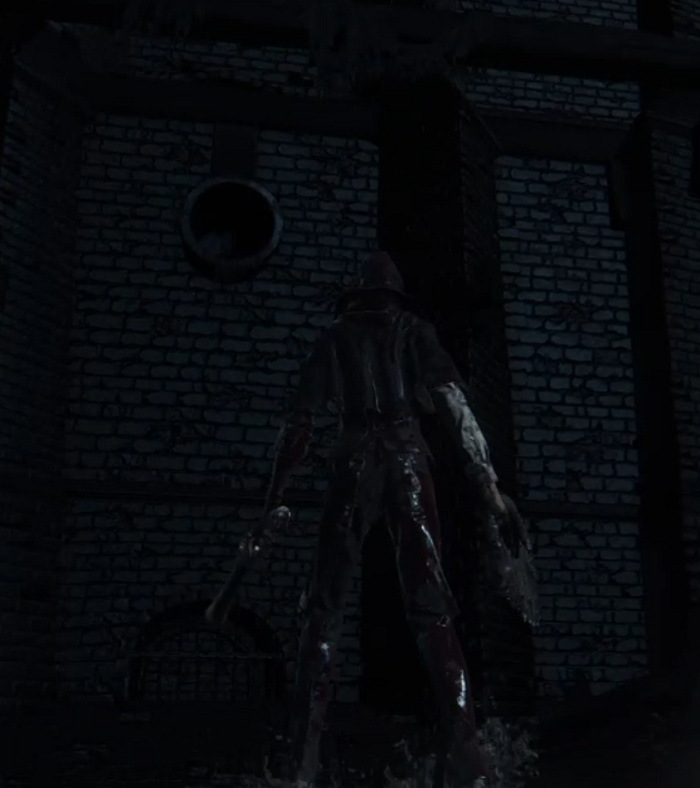 Given its location relative to areas we’ll visit later in the game, this might suggest that Central Yharnam was getting its water from somewhere in the Forbidden Woods, which might have been less than ideal. Following the aqueduct to its end, we come to where the Hunter Set resides. 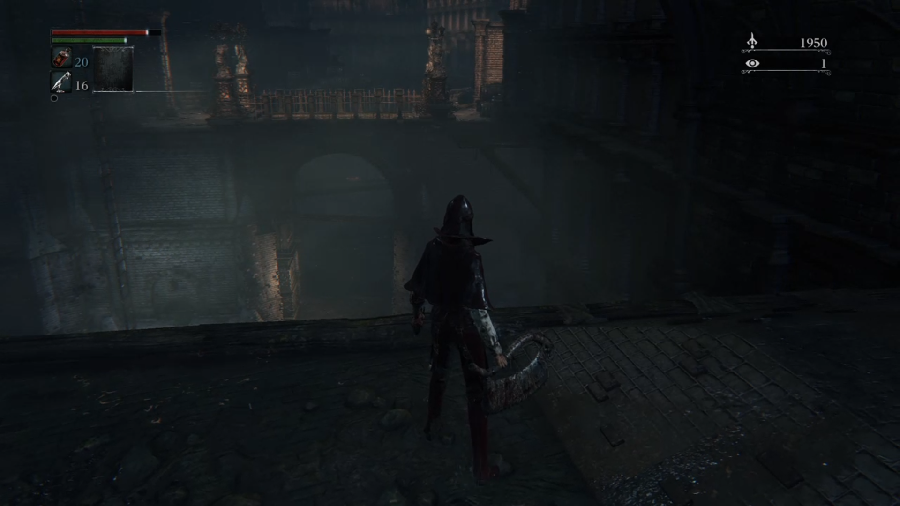 One of the immediately noticeable things about this is the steep dropoff. I don’t know enough about architecture to definitively say whether an aqueduct system like this would ever be found inside a city, but I do want to mention that if there were still an active flow we would have a waterfall. Waterfalls are kinda a big deal in this series. The second thing is the peculiar fact that Central Yharnam contains two aqueducts, an upper and a lower one. It also contains two bridges to the next zone Cathedral Ward, again an upper and lower one, and each featuring one of the two boss fights of the area. I’ve mentioned before that duality in Soulsborne map design is a thing. In Dark Souls 1, the Northern Undead Asylum has a mirrored structure between when you escape and when you return. In Dark Souls 3, the High Wall of Lothric has upper and lower portions with entirely different storylines. And Dark Souls 1 begins with the two Bells of Awakening, a motif replicated in both of the sequels. I think Bloodborne’s title art is an incredibly clever hint to what’s going on: we’re dealing with mirror universes. Blood and Insight. Body and Soul (see? I do know something about Demon’s Souls). That’s why we have two Iosefka’s, one working with blood and the other creating kin. We also have a mirror for the Hunter’s Dream. Well, hypothetically I can think of at least two that could qualify, but I’ll leave filling them in as an exercise for the reader. Some of the answers might even surprise me. It’s kinda like if someone were making a video game, had two different ideas they couldn’t choose between, and decided to just make both. I lost everything, but remained here, patiently. The throne will certainly receive you. But the question remains... What do you want, truly? Light? Dark? Or something else entirely… Why do I bring this up now? Well, the Cleric Beast is one of those bosses we don’t really have a lot of lore for. This is pretty typical for Soulsborne games. Asylum Demon in Dark Souls 1 (and really basically every boss until Quelaag), Iudex Gundyr in Dark Souls 3, The Last Giant in Dark Souls 2, all of them are more or less mysteries. So hypothetically, what if they’re as unexplained and generic as they are for a reason? A floating signifier is a word or phrase with no agreed upon meaning. They were described by the person who invented the term as “void of meaning and thus apt to receive any meaning.” We will come across many cleric beasts later in the game, but none of them match the Cleric Beast of Central Yharnam. So what if instead of this Cleric Beast being one of them, it’s actually all of them? One of my many hypotheses is that the worlds of all of these games are made from a monomyth being repeated over and over, and we are exploring the memories of this multitude of heroic journeys intertwined. And for some of those heroes, their journey begins with the slaying of what is now the composite Cleric Beast. I suggest this because I think NPC summons are part of the implied story of these games, and for the Cleric Beast we can either summon Father Gascoigne or Alfred, Hunter of Vilebloods. I honestly didn’t know about the latter option until doing this playthrough. Summoning him is pretty convoluted as it involves doing the Gascoigne boss fight first, meeting Alfred in the next area, and then coming back to Central Yharnam. Anyway, hypothetically, suppose both Gascoigne and Alfred have their own story arcs (beyond what we know of through related questlines) told only through implication. Both arcs begin (or can begin, we’ll get to that) with fighting a specific Cleric Beast. In Alfred’s case though, he can be only summoned for either Cleric Beast or Blood Starved Beast and not both. Almost as if his story begins with a choice between two options. Anyway, we have another line of investigation open for us when it comes to the Cleric Beast: its drop, the Sword Hunter Badge. The item itself is the first mention we have of Ludwig, and it also briefly explains the general concept of Cleric Beasts. It allows the purchase of Antidotes and Hand Lantern, both items that would be quite useful for anyone venturing to Old Yharnam, and Bold Hunter’s Marks, which I don’t really have a lot to say about right now. The Repeating Pistol is an interesting inclusion. We will eventually come across two NPCs who wield Repeating Pistols, “Imposter” Iosefka and the Bloody Crow of Cainhurst. We will fight the latter in a room that previously housed a Cleric Beast, so that’s a potential connection to keep in mind. But the most “impactful” unlock is the Kirkhammer. The flavor text isn’t particularly helpful, so I’d prefer to focus again on NPC interactions. Alfred himself shows up wielding a Kirkhammer, a fact that could be explained by him will have had (time: convoluted) acquired it from the Cleric Beast he killed, so that might not be too much of a mystery. The more intriguing lead for me is an obscure chalice dungeon fight known as the Forgotten Madman. The Madman himself is very Ludwig coded, wielding both Ludwig’s Holy Blade and Ludwig’s Rifle. Halfway through the fight a second NPC named the Madman’s Escort shows up wielding a Kirkhammer and Flamesprayer. This suggests to me a duo of tomb prospectors, perhaps brothers, on a quest to find a sword. Or possibly to upgrade an existing sword. The Madman does obsessively maintain an Empty Phantasm Shell buff at all times, which is kinda suggestive of someone trying to find a more permanent solution. Could be that, successful or not, they both eventually end up Cleric Beasts, becoming the threshold guardian of somebody else’s journey. It’s also possibly noteworthy that it is the escort who wields the Kirkhammer. This might be the evocation of a character archetype first seen in Garl Vinland from Demon’s Souls, and eventually repeated in Eygon of Carim of the big blunt weapon user serving as the guard for somebody else’s journey. The last unlocked item is the Hunter Chief Emblem, whose purpose in this game is reminiscent of the Crest of Artorias from Dark Souls 1. More immediately interesting is its description: quote:A cloth emblem that belonged to the captain of the Church hunters long ago. Opens the main gate that leads to the round plaza of the Great Cathedral. Given the location of this gate and some of the implied geography, this suggests that the Cathedral Ward at one point had a predatory relationship with Central Yharnam, which seems at odds with what we see in the game, and instances like that are always incredibly intriguing. If we were to map this relation back to Dark Souls 1, would it suggest that the denizens of the Undead Parish once hunted the members of the Forest Hunter covenant? Or would it have been vice versa? Speaking of geography, defeating Cleric Beast also opens up a door that does not and will not ever work, and that presumably leads up to another not working door in the Cathedral District. There’s speculation that this was due to technical limitations, but I’m starting to believe that it was more of a conceptual design change during development that was left in for flavor. In any case, there’s this fascinating Tumblr blog Illusorywall that had a post on the unused map data in Dark Souls 2. One of the things they mention is that there’s indications that there was once a path to Drangleic Castle via an aqueduct. I’ve been playing around with the idea that its removal was a change made with the intent of maintaining a weird synchronicity with the disabling of the Cleric Beast door. Because yes, this is the sort of detail almost completely unnoticeable to the player that FromSoft would obsess over. So anyway, this update ended up a bit more future referential (and text heavy) than I wanted to make these, but the Cleric Beast is hard to say anything about without reading into implications. There’s also observations like how the visual design is evocative of Manus from DS1 and appears to have nails jammed into its legs, and its fur looks like fungus, but I don’t have anything to offer about this that Bloodborne wikis don’t already cover. I have a difficulty reading the Cleric Beast model during the fight, so visual observations here aren’t going to be my strong suit. So to lighten things up, one easily missable detail is that the messenger baths change as you progress through the game. Until you get your first point of Insight, the Insight Bath is completely empty. As for the Blood Echo bath, every time you discover a new badge a new messenger arrives.  The Sword Hunter Badge adds the little guy on the left holding a red bottle. Sibyl Disobedience fucked around with this message at 15:58 on Aug 7, 2020 |
|
|
|
Lord_Magmar posted:The Hunter's set is a bit like the other times through the series where you can find trailer distinctive set somewhere early, often with the implication that it's a previous Undead/Hunter who failed early for whatever reason. There could be more to it but that's one of those things that's interestingly repeated. It shows up in Demon's Souls and Dark Souls 1 from memory, not sure about Dark Souls 2/III though. Yeah, there's a pattern there, and it's one I'm frustrated I haven't made any progress on. What's really intriguing to me is that the location of the Hunter set is bizarre given the presumed ending of the character in the trailer. Other parts of that trailer do not map at all to what we experience in the game, and taking that to be an intentional and deliberate choice may lead to some interesting observations. quote:On the Iosefka thing, she straight up is called Imposter Iosefka, Game lies; so what? Suppose you're telling this story with mirror realities, and now you need to credit the voice actors for two mirrored characters with the same name. Problem is, you don't want those credits to reveal your secret; what do you do? You credit the second according to the prejudices you're trying to induce in the player. Quelaag is the iconic example of a Souls character who seems villainous until you happen to gain a point of insight. Discovering her purpose doesn't necessarily make her good, but it allows you to understand the tragedy she's undergone, which makes her sympathetic in nature. And most importantly for the points I am about to make, the core narrative is deliberately trying to make you misunderstand her. Many people hate "imposter" Iosefka, but you know who doesn't? Miyazki. quote:Interviewer: That's interesting… To get a bit more into the story, everyone at Future Press really liked the character Iosefka. Let's list some things we think we know about Iosefka based on things we experience in-game. She appears to be responsible for the existence of Celestial Minions. She's trying to give birth to something. Aside from her clinic, Celestial Minions only appear in a small stretch of the Forbidden Woods and in the Upper Cathedral Ward. How crazy should I make this next part...? Let's go full. Literalists hate it! Ok, so the Forbidden Woods dead end with the Celestial Minions (And 3 Madman's Knowledge, a sign that deceptive poo poo is going down). It used to be an outlet of a river. The narrow walls are a remnant of the erosion process. At the base we have some remaining stagnant ponds just like in Cemetery of Ash. And above us, we have not one but two bridges that appear to be over either a dammed river or one that has lost enough flow that it can no longer get over a rocky lip. There's actually a lot of things to point out about this setup. Like in Central Yharnam we have architectural repetition. The zone has two bridges with the same design and same underlying geological structure. This pairs with the two windmills of the zone, and both the windmills and bridges can be thought up as upper and lower, again like Central Yharnam. The second bridge serves as a sort of halfway point of the zone, as crossing it opens up the shortcut to Valtr. Just like in the Upper Wall of Lothric, this halfway point changes the storyline of the zone entirely by introducing the various snake mobs. And finally, that stagnant pond is evocative of the glowbugs in the Dark Souls 2 intro cutscene. But the narrative parallel most important right now to us is that just like you at the start of DS3 (and like the corpses of New Londo) the Celestial Minions have been flushed. Displaced from their natural environment. So what was their natural environment. Well, we have two remaining answers, don't we? Spoiler alert: the answer is both. "Imposter" Iosefka is going through pregnancy. This seems unrelated to the Celestials unless we entertain the very weird notion that she will have had given birth to them. That is, until you killed her. You monster. So let's talk about Amygdala. One of the weirdest things about Amygdala is their inclusion in the Great Cathedral. For starters, they do not appear as large as they ought to be. You can handwave that one away as a sculptors choice, either within the narrative or as a 3D modeler needing to size the model to fit into the level design. But there's two features that are harder to rationalize. First, unlike the one we fight, the statues appear to have tentacles. But the second is that they're holding spears. This inclusion reminds me of something Miyazaki said in the DS1 Design Works interview: quote:It's true I dislike designs which are too obvious, but there are times when I feel a design lacks a certain something. At times like this I have been know to look through the reference materials, pick out things I like and simply stick them on. The capra demon's head is an example of this, it gives a sense of ceremony and long held tradition, which in turn hints at a developed culture. Details such as this can really improve the designs giving them a significance not present in initial image. Symbols contain inherent meaning, they wouldn't be symbols if they didn't, but it's difficult to then add new meaning to that symbol. So I think this can be a really powerful weapon for the artists. The idea that their spears similarly indicate that the Amygdala once had a developed culture is a pretty intriguing one. It's also interesting that the (first) Hunter's Nightmare version of the Great Cathedral is guarded by a Nightmare Executioner. It's a model used only 3 times in the entire game, and it has tentacles similar to the ones that surround it, so perhaps it came from the same culture as the ones who made the statues. But let's go back to the Forbidden Woods. In the bottom half of the zone, we have some pretty fascinating environmental features that I am choosing to interpret as petrified Amygdala. This isn't a particularly radical concept for these games. In Dark Souls 1 the Everlasting Dragon seems pretty petrified. Or possibly hibernating. Curse in Dark Souls 1 appears to petrify you. In Dark Souls 3 it is the Demons in the Undead Settlement and Farron Keep that are slowly petrifying. Dark Souls 2 gives us both Petrified Something and Petrified Dragon Bones. So let's just run with the idea that there are you-sized Amygdala who are diseased. Or infected. Or infested. Parasitism is, after all, one of those constantly reoccurring themes that never get properly addressed. Kos Parasite, Egg Carriers, Sunlight Maggot. I'm currently playing through the Ringed City, which might be the most beautiful area in all of Soulsborne. The Pilgrim Pupa could be simply be interpreted as simply the next phase of Pilgrim metamorphosis as the name suggests. They could more intriguingly be interpreted as cordyceps, the zombie fungus that takes over insects. So if Amygdala had a parasitic infestation, couldn't you imagine it looking something like the Vermin Hosts we see in the Forbidden Woods? And then suppose those vermin infected holes were once orbital cavities. Wouldn't the best anti-parasitic evolution be to cover your skull in a translucent film? Get your eyes on the inside, as it were. What is humanity? What are demons? If you're trying to tell a story from the perspective of an amygdala, the most true way to do this is to show them as humans. Because the Amygdala doesn't see its kin as Amygdalas; they see them as normal. And from the player's perspective, a human model will always be interpreted as the normal. It's like that Twilight Zone episode; beauty is in the eye of the beholder. So just like real Iosefka, "imposter" Iosefka is, in a sense, trying to create her own vaccination. And to do this she needs to give birth. Changing realities for a second: Seathe the Scaleless. If you look at his concept art  He's pregnant. Seathe is another character like "Imposter" Iosefka who is depicted as a kidnapper. But his Crystal Cave is full of Moonlight Butterflies. He's giving birth to them. Re-birthing them. Because he's trying to save them. And if "Imposter" Iosefka is a deliberate return to this re-birthing motif, well, then you might call her the Mother of Rebirth. And what better place for a Mother of Rebirth than an altar that is used to rebirth someone? Isn't it intriguing how many visual similarities Seathe and Ebrietas share? Of course for Ebrietas (at the time we encounter her) it's an Altar of Despair, because the most precious pregnancy ended in a stillbirth. Every Great One loses its child, after all. Sibyl Disobedience fucked around with this message at 22:13 on Jun 26, 2020 |
|
|
|
Carpator Diei posted:But seriously, the layout of Yharnam is fascinating to me. It very much feels like the city has grown on its own, without any unifying plan or even actual human interest behind it. Not something that was deliberately constructed, but rather something that happened to the people living there. They already told us what's happening.  Welcome to Yharnam, where the transitory lands of Pthumeru, Loran, and Isz converge. quote:Another option is perhaps even more intriguing: The other places in Bloodborne that are supposed to have been cities at some point are the Chalice Dungeons, and the entire thing about those is that they're constantly changing. The description of one of the Loran chalices states that Yharnam might be on its way to suffer the same fate as Ailing Loran; maybe it's not so much of a stretch to assume that the physical city itself is in the early stages of turning into the sort of ever-changing mess that the Chalice Dungeons already are. Early stages? Nah baby, we're late term at this point. quote:I'm really grateful that you're doing this, it's the first serious thematic analysis I've seen for the Soulsborne series (so much "analysis" seems content with just reconstructing lore or interpreting the "main" storylines as allegories for something or other). I know, right? There was a period at the start of this googling because surely someone else must have already done something like this. Things get so fun when you start transposing the thematic DNA around. It's like you're gradually making the individual worlds a little less hollow. I suppose I should warn that things will start getting a little allegorical once we get to the central originator myth, but it won't be derived from the "main" storylines. Just like with water, what we're interested in is the negative space. And it makes me want to talk about Gascoigne's model, but I think that I should definitely save for later.
|
|
|
|
Lord_Magmar posted:Imposter Iosefka is actually probably one of the most easily explained things in the game. Nothing in these games is easily explained. There is no room for canon in a house which serves the muse. quote:She uses the Call Beyond (Secret Rite of the Choir) and Augur of Ebrietas (as the name suggests a gift from the beautiful daughter herself). Why do you assume that Iosefka is the recipient and not the giver? quote:She’s clearly transforming humans into Celestial Emissaries (there’s a failed attempt with a human arm on a gurney), and every one in her clinic drops an item related to an NPC you sent to her. In fact they spawn based on who you send to her even. The one that’s always there drops Iosefka’s Blood Vial. One of them will drop the ribbon if you sent the girl to Iosefka. I forget the rest but it’s very consistent. This is such an awfully anthropocentric point of view. If Loran can be an ascent to Amygdalan, why can't Isz and the Choir be an ascent to the Celestial? quote:She’s also not actually pregnant by the end point of the game, she ate an umbilical cord in the hopes of ascending instead of becoming a beast. Which is why she discusses seeing the phantasms dance inside her skull, compared to Arianna who does actually get pregnant (presumably with Oedon’s child) and gives birth. And this is a tragically narrow view of what constitutes pregnancy. For reference:  What do you think the intended symbolism of this icon is supposed to be? Bonus Content: 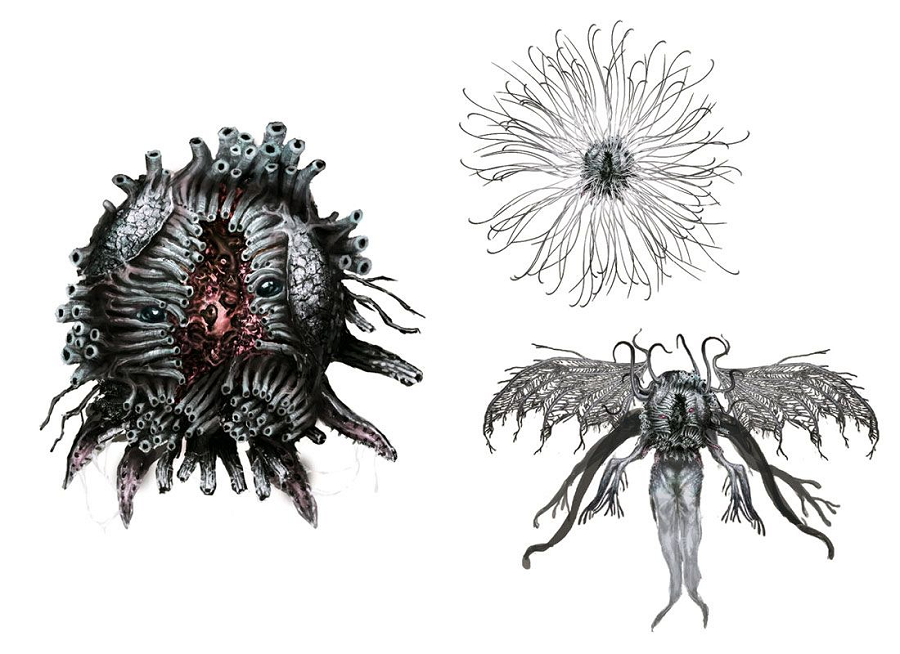 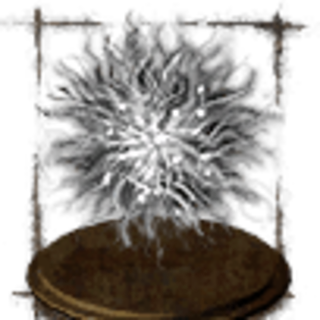 God I'm nauseous... Have you ever felt this? It's progressing. I can see things... I knew it, I'm different. I'm no beast... I... Oh... God, it feels awful... but, it proves that I'm chosen. Don't you see? How they writhe, writhe inside my head... A Fire Keeper's soul is a draw for humanity, and held within their bosoms, below just a thin layer of skin, are swarms of humanity that writhe and squirm. quote:The one you fight is the “Greater” Amygdala, given their design I’d almost accuse them of being hive minded with a visual similarity to the human neuron, basically a vast web of interlocking beings thinking as one creature with one mind and many bodies. Hehe, now we're getting somewhere! You cling so tightly to what you think you know when the possibilities that lurk within the unknown are positively rapturous. This is a game with a mechanic that explicitly conveys that the universe is going to deceive you in a series with spells like this one. Cleanse yourself of prior assumptions and take the plunge. 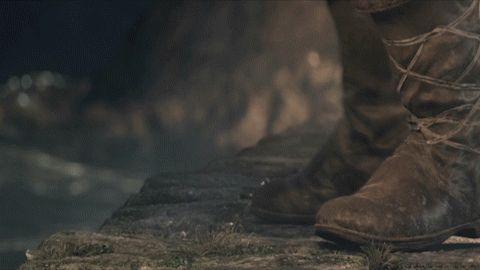 Have you heard how curiously the sea churns? Like a storm, but like the rain, only gentle, like dripping water. It bellows from deep inside of me. Here it comes, up through my insides... but gently, like little droplets. Sibyl Disobedience fucked around with this message at 06:48 on Jun 28, 2020 |
|
|
|
Episode 08 (BB-03)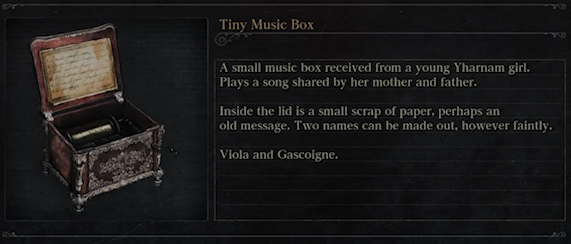 Malcontent's Ring+Malcontent(Sekiro) posted:An old ring well-suited for slender fingers. "Kingfisher" is engraved on the underside. Can be used to upgrade the Finger Whistle Prosthetic Tool. This video was pretty exciting. I made four new discoveries during it, and one is actually kinda mindblowing even for me. Won’t get to fully reveal that one until the Lecture Building though. This section gave me a lot more to work with, and part of the reason why involves a pattern that exists throughout much of Bloodborne. There is a tendency to bounce back and forth between abstract bosses and specifically named bosses. Cleric Beast to Gascoigne. Blood Starved Beast to Vicar Amelia. Shadows of Yharnam to Rom the Vacuous. Celestial Emissary to Ebrietas. Just an observation for now. We begin by going back to Iosefka’s clinic because this is the last chance we get to talk to this Iosefka. She’s one of the few people in this town grateful for our presence, but she can’t let us in because the “patients here in my clinic must not be exposed to infection.” She does, however, give us an item that is really fascinating for a whole host of reasons.  First, let’s talk about what it is not. There are 4 special bloods we get throughout the game that are mutually exclusive from one another (if you currently have any of these, none of the NPCs will give you theirs). Beside’s Iosefka’s we have Blood of Arianna, Blood of Adella, and Blood of Adeline. Iosefka’s Blood Vial has two big differences: the naming convention and the color. Beside’s Iosefka’s, all the others are Blood of _______. This grammatical difference suggests that it is the vial that is Iosefka’s, not the blood. Iosefka’s Blood Vial is also the only one of the four that isn’t red. It’s yellowish color combined with its description of being a “product of a slow and careful refinement process” and “a clinic original” suggests that what she is actually providing you is blood serum, specifically an antiserum. This method of using a transfusion to pass on antibodies is one of the more promising treatments for COVID-19. How’s that for topical? (Bonus thing to consider: how are serums made?) Anyway, we’ll return to this clinic later. In the meanwhile, take note of this architectural imagery on the way back to the lantern, because we’ll be returning to it as well.  We’re almost getting to Gascoigne, but we have two detours. The first is something I had completely missed until recently: this well.  The denizens of the town appear to be using the well to fill bottles. If I had to guess, I’d say they’re making Pungent Blood Cocktail, because “In Yharnam, they produce more blood than alcohol. as the former is the more intoxicating." This then raises the question of why the water system would be full of blood...but this unfortunately is definitely never brought up again. 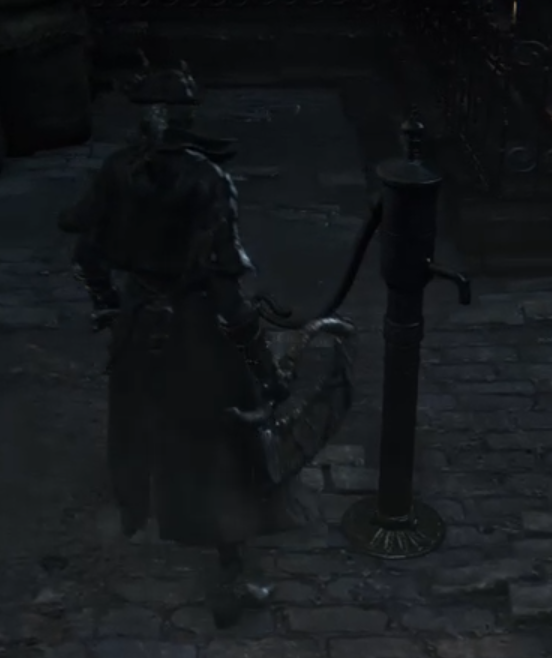 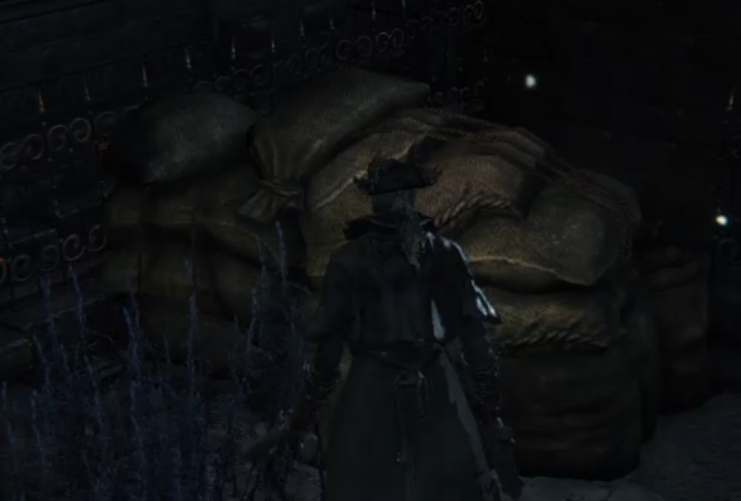 Emphasizing this theme, there’s also a water pump in the background. Sandbags also litter the area, suggesting the possibility that the residents have dealt with some flooding in the past. Detour two: previously I mentioned the possibility that Bloodborne is a merger of two mirror realities, and that this might be reflected in the two aqueducts in Central Yharnam. Well, both of those aqueducts have a mirrored design feature where a corpse with an item is on a wooden support beam, and you have to jump down onto the beam to pick up the item. You can actually see the upper location from the lower location. 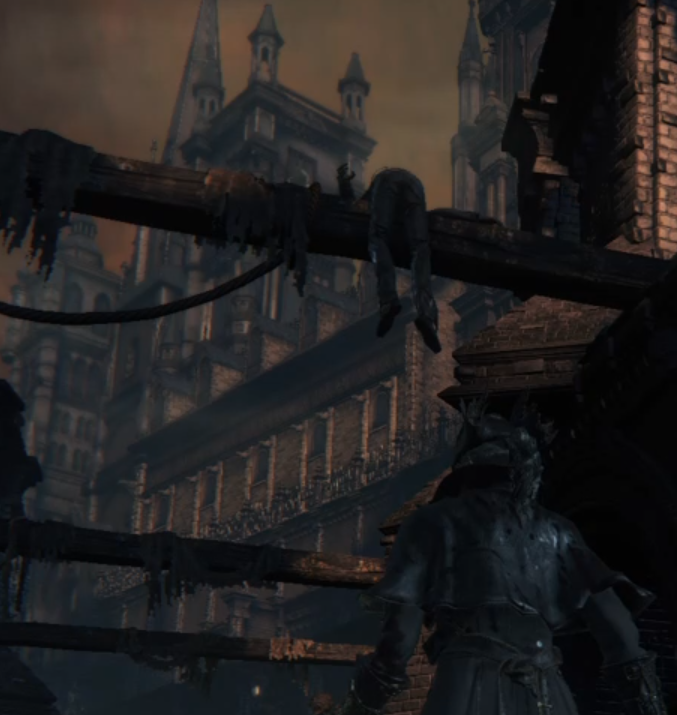  After you get the item, you have to jump down into the aqueduct basin. So I had the idea of comparing the fall damage. When you do that you only take fall damage in the upper aqueduct. My belief is that this item location motif is intended to draw your attention to the fact that the aqueducts are built to different senses of scale, almost as if they were built by two separate civilizations with differently sized citizens. So anyway, we finally get to Gascoigne’s daughter. She gives us the titular music box, but what stood out to me this playthrough is this line.  I know people are going to say that she can just smell the stench of blood on you, and from that surmises that you’re a hunter, but hear me out. This line is reminiscent of a couple moments earlier in the series. First we have Shalquoir’s dialogue in DS2: quote:Oh…Who were you again? Secondly, we have Dusk’s dialogue from DS1: quote:This may strike thine ear as somewhat peculiar, but… And finally we have the alternative Sif cutscene. I’m not necessarily going anywhere with this parallel right now, but it’s this sort of resonance, that I try to pay attention to. While we’re here, I also want to mention the Brick Troll beneath the girls window. I believe this is the only Large Brick Troll in Central Yharnam, and possibly the only Brick Troll in the game wielding this particular weapon, which I only just figured out this run is a statue. 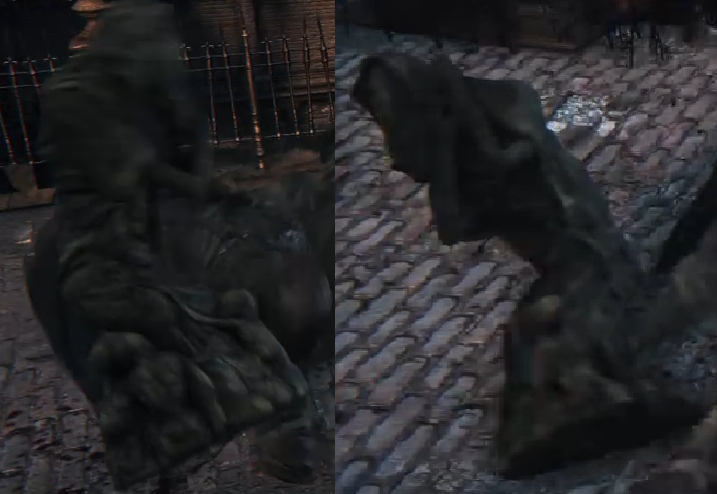 My understanding is all Brick Trolls have the line “So cold, dear sister,” but I’m inclined to attribute its symbolic meaning to this troll in particular. The positioning under Gascoigne’s window is uncanny, and there’s a play of words going on. While we’re told from Gascoigne’s armor set that “‘Father’ is a title used for clerics in a foreign land,” Gascoigne’s family contains the only references to fatherhood in the entire game, a conspicuous feature given the plethora of references to motherhood. Similarly, our primed interpretation for “Sister” is a title for a nun, but as we find out later Gascoigne has two daughters, the only officially declared female siblings in the game. And hypothetically, if Gascoigne had three children, that would map quite nicely onto Gwynevere, Gwyndolin, and the Gwyn’s nameless son, though the family tree has gotten a bit more convoluted since the halcyon days of Dark Souls 1. Now we can finally get to fighting Gascoigne, but first, the requisite boulder set piece.  I just wanted to mention that this potentially highlights the cubby safe zones at the middle of the bridge, a feature that the Cleric Beast bridge shares.  So let’s finally get to the Tiny Music Box. Two separate directions for this one. First, I opened with a quote from Sekiro. Two quotes merged actually, one for the Malcontent’s Ring and the other for the whistle upgrade Malcontent. To refresh your memory: quote:An old ring well-suited for slender fingers. "Kingfisher" is engraved on the underside. Can be used to upgrade the Finger Whistle Prosthetic Tool. But I left off the stated use of the Malcontent: Can be used to drive beasts mad. It’s an intriguing parallel to the Tiny Music Box, and it’s more intriguing when you consider the item you need to unlock the Finger Whistle: the Slender Finger. quote:The slender finger of a young woman. Can be fitted to the Shinobi Prosthetic to create a Prosthetic Tool. Gascoigne’s iconic cutscene snarl... 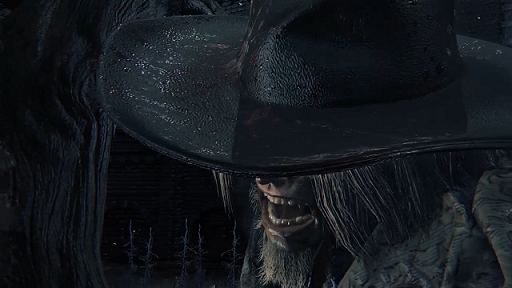 It certainly looks bestial, but it doesn’t immediately read like a wolf to me. Instead what I see is something more along the lines of this. Just food for thought. Second potential lead: the name “Tiny Music Box” reminds me of the Tiny Being’s Ring from Dark Souls 1. Which is funny, because if you compare the ring’s graphic to Viola’s Red Jeweled Brooch… 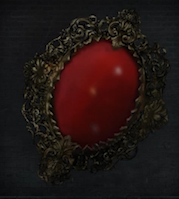 It’s also an interesting fact that the character who gives you the Tiny Being’s Ring, Siegmeyer, is the only other character in the series to have a known daughter. Other than Gwyn, I suppose. There’s actually so many more directions we could go with the Tiny Music Box. Why does it play the boss theme for Mergo’s Wet Nurse? Why is killing Gascoigne the trigger for Iosefka being replaced? Why does it wake up a snail woman in the Hunter’s Nightmare? But that would be getting ahead of ourselves. Going back to Gascoigne’s cut scene, and this might actually just be me reading too much into things, but his scarf from behind reminds me of a noose. 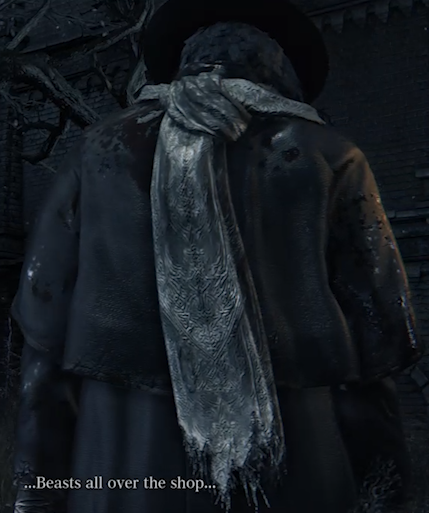 It would be thematic because, as some have argued, the Hunter’s Mark is a riff off of the Hanged Man tarot. 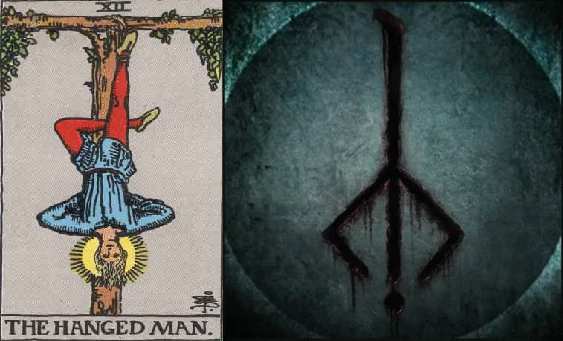 And while I don’t want to get into Odin just yet, I’d point out that the nails in the Cleric Beast’s thighs might be the remnants of an inverted crucifixion. Gascoigne’s dialogue here is also potentially fun. A Bloodborne wiki pointed out to me that “beasts all over the shop” is an Irish colloquialism matching the origins of the name "Gascoigne," but it’s also one of those phrases with a potential double meaning if we take “shop” to mean “workshop.” I want to impress upon you that Soulsborne loves double meanings. There’s also a bit about him saying “Umbasa” in the alpha version. Likely means something, but as I’ve said elsewhere I haven’t played Demon’s Souls. Oh, I also said in the video that Artorias had a sword scrape, but I was really thinking of Knight Slayer Tsorig. My bad. So anyway, we take the brooch back to the girl, she’s less than thrilled at the development, we restart the game, and the window is now unlit. Moving back down into the sewer, it’s time to point out yet another implicit water story. 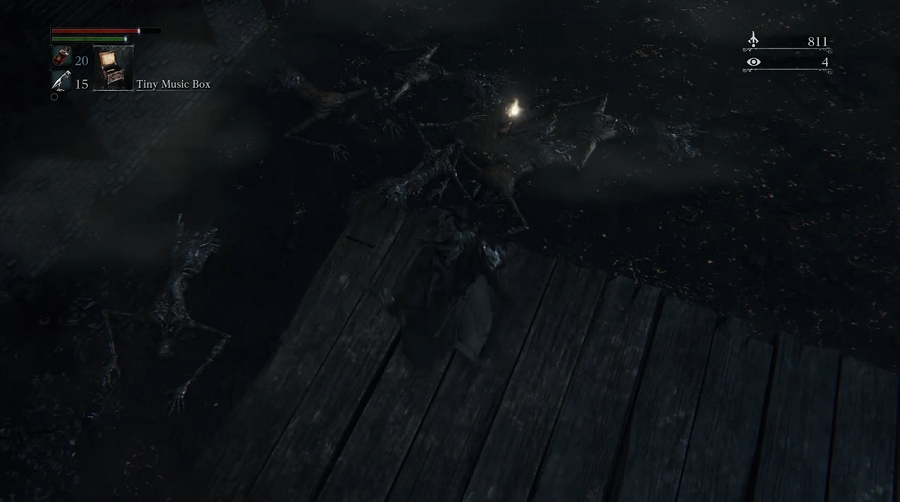 This corpse pile at the base of Central Yharnam would have most likely been deposited here by the upper aqueduct, repeating the corpse flushing motif seen in New Londo Ruins in DS1 and the Cemetery of Ash in DS3. From here we head towards the sewer where we kill a Maneater Boar that drops a Red Messenger Ribbon. Described as a red “was drawn from the organs of some unfortunate Victim” and an object that “perhaps for the messengers constitutes a form of mourning,” suggests that Gascoigne’s daughters trip did not go particularly well. With that said:  If you summon Gascoigne like we did for the Cleric Beast and bring him here, he will immediately Silencing Blank out as soon as you approach this entrance. It’s almost as if he subconsciously knows what will have had transpired here. Briefly, I want to mention that the names of the enemies found here, Maneater Boar and Carrion Crows, combined with the melty zombies suggest that this sewer functions as a sort of trough. Back to the story progression, in addition to the Ribbon we get the Saw Hunter Badge that unlocks for purchase all of the potential starting equipment plus the saw spear. 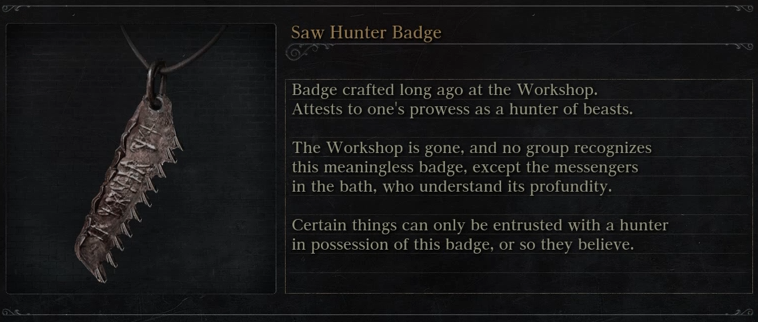 The most interesting part of this description is the messengers understanding the profundity of the badge. If I were to guess at any intended visual symbolism, the obvious answer is a jawbone. The less obvious answer is a caterpillar. The Saw Cleaver and Saw Spear are still a mystery to me. Most weapons in Bloodborne can clearly be attributed to someone, such as Gascoigne being the iconic wielder of the Hunter Axe. But despite being the most iconic weapons of the game, I have no fruitful leads on the saw twins (well, ok, there’s Henryk, which is rather relevant, and the NPC hunter in Old Yharnam who is less obviously so). So maybe this is just my desperation speaking, but I wonder if these two enemies outside of Gascoigne’s boss room are in some way symbolic of the missing Cleaver and Spear hunters.  Perhaps the spear hunter slayed the equivalent of a dragon and then the cleaver hunter chopped it up into poisonous bite sized pieces. Back to Gascoigne’s boss room, the Tomb of Oedon. There’s a repeated pattern of tombstone clusters. 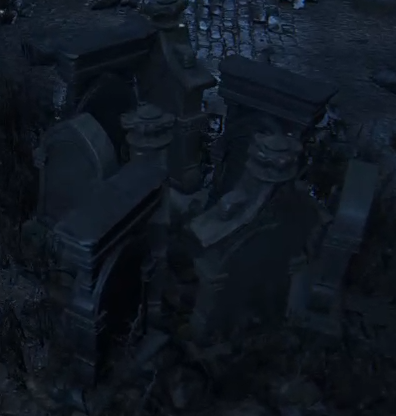 Given the standard use of tombstones this doesn’t make a lot of sense, but tombstone circles show up elsewhere in the series. I suspect they’re supposed to be a symbolic representation of a fairy ring. The tombstones are metaphors for mushrooms and the broader cycle of death, decay, and renewal. I’m also going to throw this out there with a lot of visual backing, but I think this boss arena echoes Scorpioness Najka’s in Dark Souls 2. Specifically, the location of the Red Jeweled Brooch is a weird echo of the Flame Butterfly in Najka’s room. So way back when we actually killed Gascoigne, we obtained a key 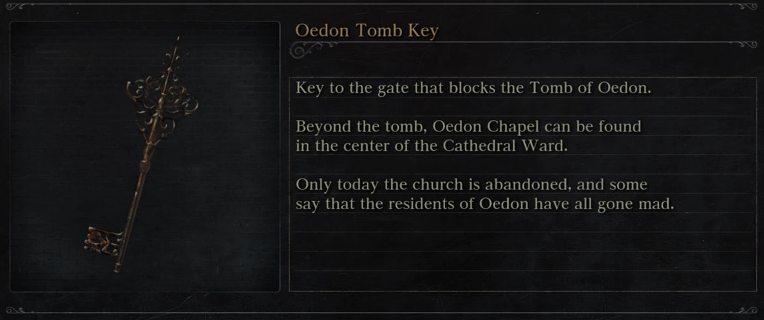 The final sentence is the one I want to focus on because of it’s bizarre phrasing, specifically “residents of Oedon.” Normally one doesn’t typically talk about a church having residents, but even if that were the intended meaning it would be much more natural to say “the residents of the chapel” or “its residents” or even “its former residents” given that it is now supposed to be abandoned. This phrasing distinctly implies (at least to me) that the church and Oedon are two different entities. Anyway, we enter the chapel through it’s sewer system I guess. Weird way to connect your chapel and it’s graveyard, but hey, you do you. We go through a more scholarly oriented room, which is a bit interesting given the dichotomy Soulsborne games often establish between the scholarly and the religious, sorcery and miracle. Here we get the Blood Gem Workshop Tool. 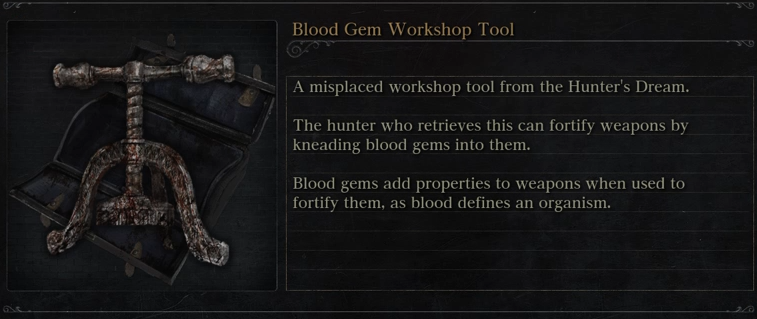 This has another bit of ambiguous phrasing where the blood defining an organism could apply just as much to the weapons as it does the blood gems. And finally, we enter Oedon’s Chapel. We’re saving it for next time, but the cutscene greets us with a familiar friend.  Note how the focus shifts from the foreground to the background as if to say, “Pay attention! This is important!” I’ve harped about the duality of the world design, and here we have this obnoxiously bright feature present in the two places we will eventually be able to send the poor townsfolk of Yharnam. And to top it off one of these is a research clinic and the other is a chapel. And with that this “summary” is finally complete 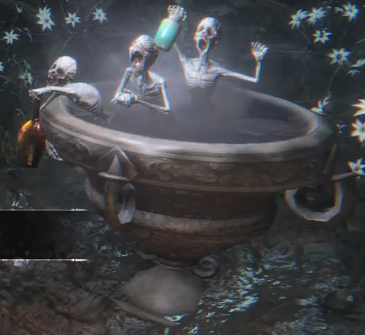 ...except we got a new messenger with a green bottle! I know that this section is overwhelming in size while simultaneously being annoyingly vague. Part of it is that I'm still working through the connections here myself, but the bigger issue is that everything revolving around Gascoigne is definitely tied to a larger myth pattern that I can't reveal just yet. It's just too massive, and unlike serpents we're going to chew our food properly. So all I can do is vaguely hint at a sin and hope someone picks up the inversion. Sibyl Disobedience fucked around with this message at 15:59 on Aug 7, 2020 |
|
|
|
Episode 09 (DS1-03): Gargoyle Tail AxeTwin Humanities (DS1) posted:Rare tiny black sprite found on corpses. Very unusual twin humanity. Use to gain 2 humanity and restore a large amount of HP. Mircea Eliade, The Sacred and the Divine posted:For all these palaeo-agricultural peoples, what is essential is periodically to evoke the primordial event that established the present condition of humanity. Their whole religious life is a commemoration, a re- membering. The memory reactualized by the rites (hence by reiterating the primordial murder) plays a decisive role. Video was sloppy, but I suppose I should come to expect that from DS1 episodes. I came across something incredibly cool and unexpected while making this one, but let’s first knock out the simpler stuff. 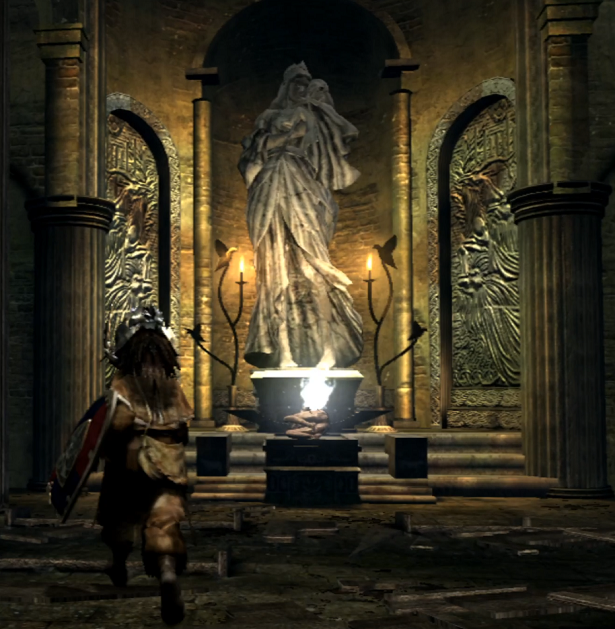 Besides the Bell of Awakening, this is the thematic focal point of the area. There’s probably significance to why a Fire Keeper Soul is here, but I cannot tell you what it is at this point in time. It is worth pointing out that the mother and child statue motif is similar to the one in the waterlogged ruins in Firelink Shrine. 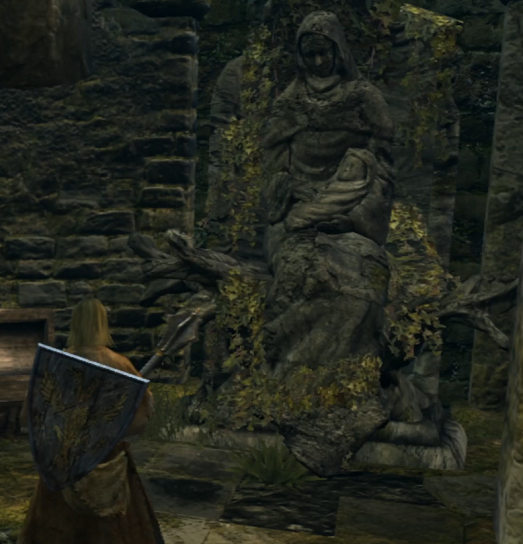 On the topic of goddess statues, the Design Works interview talks about the original plan for Andre the blacksmith. quote:Miyazaki: Oh there are many, for example Andre of Astoria. Originally he played a far more important role in the story. 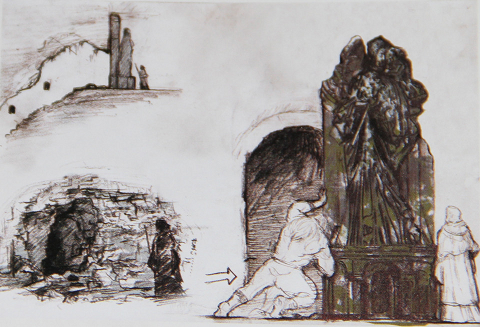 Despite what the interview says, the statue depicted in the art looks to me like it’s standing, which makes it more similar to the Undead Parish statue. But whatever the case, despite it being cut from Dark Souls 1, we see a set piece similar to this return in Dark Souls 3.  When FromSoft can’t pull something off in a game, they don’t give up on it. If anything, they obsessively find an excuse to figure out how to do it in a future game. This will be important. Anyway, back in the room with the Fire Keeper Soul, we have a single Berenike Knight guarding the altar.  And three Balder Knights guarding the front entrance, with a Channeler overlooking the altar room. 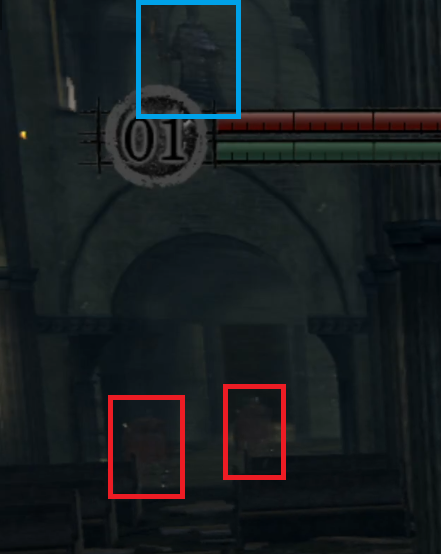 They seem to be coded as allied given the Balder Knights positioning solely to watch the entrance. It’s as if they’re all either guarding the Fire Keeper Soul or alternatively were guarding the Fire Keeper and have frozen in this hollowed out state repeating their last moments for all eternity. One noteworthy feature is the parallel resemblances between Berenike Knights and Cathedral Knights from DS3 and the Balder Knights to Lothric Knights. It’s almost as if the Undead Parish is a parallel universe to Lothric. There’s also the repeating single Balder Knight with the rapier to keep under consideration. The Channeler we will come back to later. Suffice to say he may have played a part in imprisoning the NPC we rescue, Lautrec of Carim. I don’t want to talk about Carim yet, because we haven’t yet come across nearly enough of its many, many references to make a dent in what’s going on there. But there are two things I want to bring up about Lautrec himself. First, according to the imdb credits at some point his voice actor seems to change. I don’t know when this happens because I’m voice blind or something. What’s particularly interesting is that one of these voice actors also voices Patches. We will come across Patches stealing someone’s armor and impersonating them in DS3, so maybe there’s a possibility of an imposter Lautrec at some point. I can’t say anything more about this though since I cannot recognize a voice change. Secondly, his armor design: he’s known as the Embraced Knight, and his armor reflects this with two raised sections looking almost like arms that are embracing him. But there’s another parallel you could draw to that particular feature. 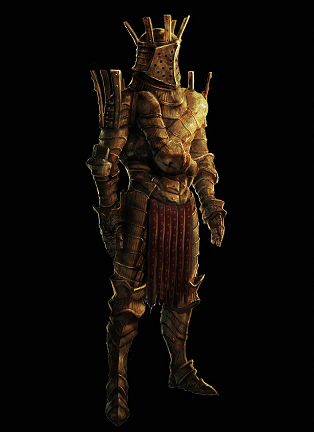 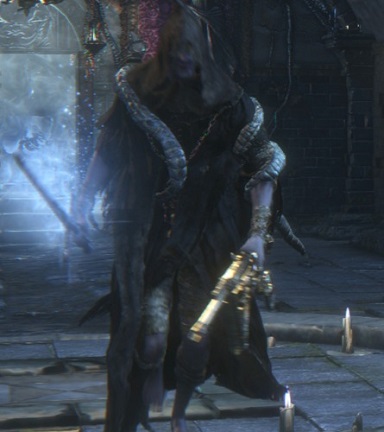 Anyway, Lautrec and Solaire are both available as summons, providing a potential parallel to Alfred and Gascoigne for the Cleric Beast, but here both can be summoned simultaneously. Does this represent a history of jolly cooperation in their pasts or is it merely incidental? Lautrec does give you a Sunlight Medal despite not being part of the covenant, as indicated by the color of his summoning sign. Perhaps he got it from working with Solaire, but he has no use for it so he gifts it to you. This finally brings us to the Bell Gargoyles, who ended up being far more interesting than I originally gave them credit for. First we have this description of their creation from Design Works: quote:Miyazaki: I remember we talked about a great many things, how to make the creature fit in, about its heavy thick armour and its level of technological advancement. The interview also mentions that the Centipede Demon from Izalith was originally going to be here, which is fascinating on its own merits, but let’s focus on the relation between their armor drops and technological advancement. Gargoyle's Shield posted:Bronze shield of the gargoyle guarding the Bell of Awakening in the Undead Church. Gargoyle Helm posted:Helm of the gargoyle, an enchanted creature that guarded the Bell of Awakening in the belfry of the Undead Church. Both items suggest that this equipment is for show, but I want to emphasize the phrasing “perhaps its shield may have been a prop.” This is an unreliable narrator. They are speaking from the perspective of a different civilization, a different culture, and they are merely guessing at the reason the Gargoyles wear these items despite their apparent uselessness. A potentially overlooked alternative is that these used to be humans who have become gargoyles through some kind of process of mutation and petrification. Neither of these elements are unheard of for the series, and Bloodborne specifically gives us a potentially parallel example in the Lost Child of Antiquity. Underlying all of these games is a theme of a civilization going through the ruins (or possibly creating the ruins) of a previous civilization, appropriating their technology, and completely misunderstanding their entire culture. It’s the heart of what a Chalice Dungeon represents. The “perhaps” in the Gargoyle’s Shield is a human narrator trying to rationalize away the obvious answer that these things have vestigial human armaments because they used to be human. Or maybe more chillingly, that despite their demonic form they still retained their humanity until you literally take it away from them. The second mystery of this boss is the asymmetry between the two gargoyles. It’s easily noticeable during the fight that the second gargoyle arrives at half health and without a tail, but a closer look is even more revealing, with the second gargoyle clearly lacking the first’s shield, helmet, wing tips, and holding a broken halberd. 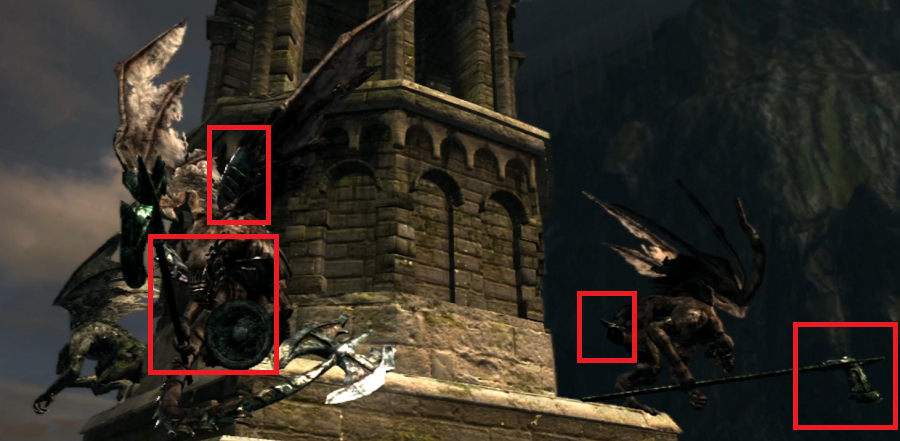 Some have suggested these deficiencies are indicative damage from a previous battle. Others have raised the possibility it has less health because it is a child with its parents. I have an alternative proposal: suppose they are siblings. This boss is one of the few bosses in the game to drop Twin Humanities. It’s not an item that really serves much of a purpose outside of a narrative one, so perhaps it indicates twins here in a very literal sense. That still leaves the question of the second gargoyle’s missing health, and for that we turn to the Gargoyle Tail Axe that you can get by severing the first gargoyle’s tail. The most noteworthy feature of the weapon is that it doubles your Bleeding, Poison, and Toxic resists. If this is meant to imply that the tail does the same for the Bell Gargoyles when it’s still attached, then perhaps the second twin was born frail, with a physical defect that leads to it being more susceptible to a poisoned environment and subsequently significantly less healthy. This whole line of thinking is intriguing to me because it would provide a direct symbolic parallel with not one but two bosses later on in the series. In any case, with the Bell Gargoyles defeated, we get to ring the First Bell of Awakening. One interpretation I like to use especially for Dark Souls 1 is that we are performing a ritual reenactment of some primordial myth. In this light, the ringing of the bells is a symbolic representation of what would have gone on here in their story. Therefore, it’s worth it to look at the context surrounding this bell in order to suss out what happened at this point in the foundational myth. Anyway, on the way out we run into this charming fellow 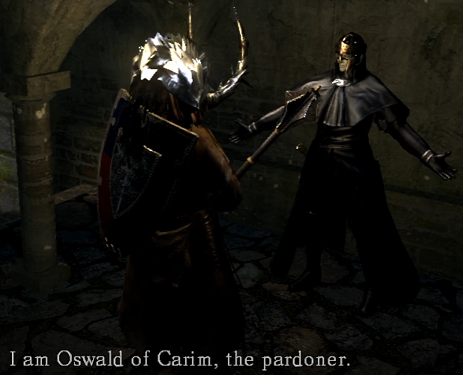 Without going too in depth, he tells us “Cometh thou to confess? Or to accuse? For indeed all sin is my domain.” Perhaps whatever is represented by the ringing of the bell was a sin that warrants confession. Or perhaps it represented Karmic Justice brought down upon a sinner. If I’m on the right track with Oswald’s relevance here, then I suspect the answer will be ‘both.’ At least, that’s where I thought I was going to end this writeup. Then I showed the text to someone and they brought up something that has piqued my interest. In the city of Dewsbury, England there is a church called the Dewsbury Minster (which is, incidentally, a parish church). It has a yearly ritual known as Tolling the Devil’s Knell, where on Christmas Eve they ring their bell, known as Black Tom, a bunch of times to commemorate Lucifer being killed by the nativity or something. I’m taking liberties in this paraphrasing, but what’s important to us is that it’s a play on the death knell, the ringing of a bell to announce a death. In our case, you could conceive of the ringing of the Bell of Awakening as an announcement of the death of its guardians. Or alternatively the impending death of someone more specific. What’s especially interesting about the Dewsbury ritual is that Black Tom was donated to the church in an act of penance for a murder. The ringing of the bell is a ritual reenactment of the forgiving of all sins, but in a sense, its creation was a penance for that first sin in particular. This all vibes thematically with Oswald’s sudden appearance, but it leaves us with a question: whose murder is it that we are commemorating? Sibyl Disobedience fucked around with this message at 15:59 on Aug 7, 2020 |
|
|
|
I'm going to tie up all of these responses around Lautrec, because Lautrec seems to me to be incredibly important, while also being virtually inscrutable. I still mostly feel that Bloodborne+DS3 is the most foundational starting point for understanding this series, but that doing it without a good understanding of Demon's+2 is kinda like solving an incomplete Sudoku. You can still make substantial progress, but you're going to hit squares that are simply unsolvable. The Sunlight Altar. Next video probably goes here because I'm an idiot who has pumped Faith to 25 and is going to probably hate my life on Capra. The most interesting thing about it is how green it is compared to everything else in the area. I can't remember with absolute certainty, but it might be the only distinctly vegetative area in the game that isn't a Darkroot variant. This haven of fertility in an otherwise barren world being here could actually have a connection to the Parish itself. The altar in the Parish is guarded by one of the three Berenike Knights in the game. The knights themselves are curious because they're mostly described as the "Knights Berenike" or "Knights of Berenike," but the Tower Shield description says "Used by the Knight Berenike, known for his heavy armour," strongly suggesting a single individual that perhaps the order is imitating (a la Artorias -> Undead Legion of Farron). 'Berenike' itself is interesting because it likely is inspired by the Greek name Berenice (alternatively, Berenike, Pherenike). The name means "bearer of victory," which I don't think has the natural implication of bear as to give birth, but maybe it's a weird multilingual play on words. Miyazaki and co might not be above such a thing. Getting back to the point, the first evidence of Berenice is a priestess of Demeter, the Greek goddess of harvest and agriculture. So the disruption of the Parish Fire Keeper being tied to a barren land with the Sunlight Altar being the last remaining holdout of the former glory does kinda track, especially with the statues in the Parish being rather Greek looking despite the British Isle trappings in the name and the pews. Also, the mother of Demeter is Rhea, so that's fun. Gwyn vs the goddess statues And yeah, I'm increasingly skeptical of the Gwyn creation myth. Intro aside, if Gwyn never existed what about the actual game world would change culturally. Even his Anor Londo statues look, well, fake 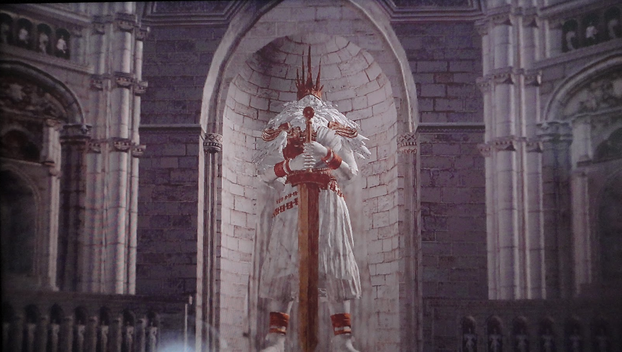 To me this comes off as previous god re-imagined as a conquering hero, with all the warlike accessories clearly a different material than the base statue. Admittedly though, the hand positioning is rather difficult to explain without a greatsword. And while the mother statues seem even more out of place, I'm inclined to read them as 5 years worth of foreshadowing for Rosaria and Filianore, who I consider much more central to the overarching plot than Gwyn ever was. Lautrec and the Fire Keeper Soul Now as for Lautrec, is he responsible for the dead Parish Fire Keeper? Could be. He does drop 5 humanity when you kill him, which is exactly what you get when you use a Fire Keeper Soul. It does leave us with some questions though. Why would he use the Parish Fire Keeper's soul but not Anastacia's? If he took the Parish Fire Keeper Soul, why is it that you can still loot it, and if he didn't, why would he leave only that one there. And why are both he and Solaire summonable just like the Twin Gargoyles fight? (and why is there also a Channeler there?) The core of Lautrec's storyline appears cut and dry, but the trappings are rather inexplicable. Leonhard, imposters, and moral ambivalence But anyway, that brings me to the moral ambivalence of Soulsborne. Note that is not ambiguity. Individual characters are often portrayed as distinctly good or evil, but these scenarios repeat, and that repetition reflects an internal conflict surrounding the underlying ethical question. It's as though the games themselves are grappling with a specific moral quandary and trying to see things from both sides. Take imposters. We assume imposters are bad people because the word itself implies fraud and deceit, but is that always the case? If you accept the common interpretation that Gwynevere is an illusion maintained by Gwyndolin, then Gwyndolin is an imposter. Does that make Gwyndolin a bad person? Maybe at some point the sun goddess of this world died and Gwyndolin is trying to carry on her work. Trying to save the world. Is this world worth saving? And even if it we feel that it isn't, can we fault Gwyndolin for believing otherwise? Either way, Gwyndolin could genuinely care about that sun goddess while still relishing the opportunity to perform her role (wearing her ribbon). And that sun goddess could have been completely oblivious of the existence of her sibling. In other words, no one mentioning a sibling to you does not prove that there is no sibling. Bear in mind that I'm not necessarily arguing against the possibility that the second daughter is a straight up imposter, just that you get there by making assumptions that are not as certain as you believe them to be. Along the same lines, we have Ringfinger Leonhard. His storyline mirrors Lautrec's to an almost absurd degree. Hanging around a female religious figure until he can betray her and take her soul to the entrance of Gwynevere's bed chamber. He wields the shotel, just like Lautrec. And for all of Leonhard's shady-ness, he genuinely seems to revere his patron goddess. "Curses, I can't... die here...My dear Goddess..." But whether you like him or not, Leonhard believes he is doing the right thing, and he distinctly believes his actions to be in service of Rosaria. Well, well, never expected to see you here. Felt sorry for the poor thing, in all her festering glory? And now you want to ravage her soul, as well. I sowed the seeds. I'll prune the mess. I, Leonhard, swear so upon my vows to the goddess. No one will despoil her soul. Certainly no beast wrapped in human skin! What do you want with her soul? Isn't flesh enough for a sick beast?! His motivation appears to be a desire to let Rosaria rest in peace, and given Rosaria's condition is he wrong? It's the inverse of Gwyndolin's choice. Ultimately, it comes down to the choice of do you try to extend a ravaged life in hopes of saving it, or do you let it die with dignity? Is saving the world merely extending the illusion that the egg hasn't already cracked?
|
|
|
|
Sinner Sandwich posted:I want to chime [ First, thank you for the compliment. I really do appreciate them, even if I do not always properly respond to each and every one. I started with Bloodborne. My girlfriend was watching a Let's Play, and the twist was compelling enough for her to pick the game up. I had ignored the series up until that point because I don't think highly of most 3D action games. The latter half of Soulsborne is light years ahead of any other games of that genre that I've played, so props to them on that. I do want to clarify that I do not believe there to be a coherence of intent. Quite the opposite actually; there is an argument. But thematically, to all of these games there is a central resonance frequency, and once you tap into it the terms of that argument become considerably clearer. After all, Oolacile light magic is about creating illusions, and, in that light, insight is learning to see through them. And on that point, yeah, I think Bloodborne and DS3 are far and away the best starting points because their DLCs are so incredibly revelatory. I'm internally debating how I want to handle this next section, because you're very much touching upon several important points (especially the symbolism of the moon; I'm so eager to get to that one), but responding to them all would be excessive, so I'll focus on this. quote:The Age of Fire is treated as something abnormal, as is lower-case-h humanity as we know it -- the primal, 'rightful' state of human beings is as Hollows, but the processes of life and by extension, one's mind and the inner workings of it are affiliated with Fire. Allowing the First Flame to go out, insofar as we know in the text of Dark Souls, will snuff that all out. This brings us to the big decision -- do we value something aberrant and ultimately transitory (after all, the First Flame WILL go out, eventually, even if we choose to keep it going) or instead find value in something bleak, stark, and horrifying, but ultimately natural and larger, more grand than our fleeting sense of self? Oh, the Age of Fire is very much abnormal. FromSoft loves to play word games, and they're actually incredibly adept at it considering how often they're not working in their native language. So take the title. Dark Souls. A slight mistranslation gives you Dark Sols, and that seems to me rather significant given we have a character known as the Dark Sun. So given this, here's an argument in favor of what I suspect is one of FromSoft's greatest deceptions: the First Flame has already gone out. Went out long before the start of Dark Souls 1. Given that, what is it that you're given the choice to link? And what was the actual First Flame? And as a hint, what pyromancy is missing from Dark Souls 1? Appropriately enough, there are actually two answers that are useful to us.
|
|
|
|
dotchan posted:Quick culture note about bells - in Japan, a giant bell in...uh...I think maybe a specific temple is tolled 107 times on New Years Eve for the cleansing of sins, with the 108th heralding the New Year. Also, I wanted to say thank you for this. Given that Japan has its own association with ringing a bell for the cleansing of sins, I'm feeling even more confident about the Oswald connection. I'm trying to work on a pair of summary videos for this set of videos, and one of the points how often bells get used in all of these games and how inconsistent their purpose and symbolism is. So far I have Dark Souls 1 - Bells of Awakening Dark Souls 2 - Belfry Sol and Luna Dark Souls 2 - Alarms in the Undead Crypt Dark Souls 2 and 3 - Chime offhands Dark Souls 3 - The Title Screen Music Dark Souls 3 - Awakening both the Lords of Cinder and the Unkindled Dark Souls 3 - Maybe the Pilgrim staffs, though they look more like incense burners (though dual meaning is certainly a thing in these games) Dark Souls 3 - The tiny bell in the Cemetery of Ash Dark Souls 3 - The grave of the Fire Keepers - Tower Key Dark Souls 3 - The bells in Archdragon Peak Dark Souls 3 - The broken bell in the Painted World of Ariandel Bloodborne - The bell on the top of lamps Bloodborne - The items for PC summons Bloodborne - The bell that rings throughout the game (for instance, entering or exiting the Grand Cathedral or the ladder into the blood pit outside Ludwig) Bloodborne - The bells that the Church Servants and Church Giants wear Bloodborne - The bell ringing women Bloodborne - Brador's silent bell Bloodborne - The Choir Bell hunter tool Sekiro - The Demon Bell Sekiro - The giant in Ashina who fights with a bell Sekiro - The Illusive Hall Bell for the Folding Monkies fight Sekiro - The Bell Charm for accessing Hirata And not to mention various structures throughout the games that could arguably be said to resemble bell towers (Yorshka's Chapel, Research Hall, the original position of the Brain of Mensis). And probably more that I've either forgotten or missed entirely. It's one of those pieces of symbolism where the apparent dissimilarity of purpose is incredibly intriguing. edit: Forgot the Research Hall elevator statue in Bloodborne Sibyl Disobedience fucked around with this message at 00:57 on Jul 9, 2020 |
|
|
|
Sinner Sandwich posted:Forbidden Sun, I think is where you're going with the Pyromancy question? That's one of the two. The other is complementary, if in an inverted way. Fire does bring disparity and all that. quote:I'm sure someone else can point out if I'm totally off-base or if there's an official source for it, but I believe that the original working title of Dark Souls was "Dark Race" or something like that, to reference humanity's affiliation to Dark as an element, but that got axed for... obvious reasons. "Dark Lord" was also floated, but I believe corporate wanted something to connect it back to Demon's Souls, and hence 'Dark Souls'. That doesn't mean you're wrong in the connection, but its worth remembering the conditions of the games' development. Oh believe me, this is very much part of the theory. The third floated title was "Dark Ring." The Welsh meaning of 'Gwendolyn' is "White Ring." So that's fun too...
|
|
|
|
Finally finished the thematic summary of the first age. https://www.youtube.com/watch?v=CIYMuOmqfFg Criticism is appreciated, particularly revolving around whether it's to hard to follow. I know I have a tendency to jump around topics really quickly, and if that's a problem here knowing about it might help me at least mitigate it in future videos like this. I might also through an event summary of the first age, but it's admittedly a project I'm not particularly enthused about even after writing out a sample script. I'm not sure it's a thing that people would actually find helpful, but it would at least take less editing time than this one did. Aside from that, I hope to get Lower Undead Burg done this week, along with maybe a short intro for the Cathedral District and Old Yharnam. I also definitely intend on scripting out a similar summary video to this one for the Linking the Painting Worlds prologue to clean it up into something more focused.
|
|
|
|
Blaziken386 posted:the video does jump around a bit, but I can't really tell if that's an actual problem, or if this is just my adhd acting it up and making it hard to pay attention due to it being a video? I dunno. The jump from talking about bells to talking about prisoners left me a little confused. Don't worry, I get you, although for me it tends to work in the other direction. If I don't jump around rapidly I'll get bored, but I recognize that this can be alienating for a lot of listeners. Part of the challenge here is that I'm trying to set up a sense of mystery, in part because I'm not allowed the tools yet to get to the big conclusions. Maybe one of my failings will prove to be not making that intention more explicit. The two big takeaways is 1) that there's relation between bells, firekeepers and their flames, and ritual sacrifice and 2) that there are prisoners everywhere once you know to look for them, which should then prompt us to ask why they are imprisoned, e.g. "Was the Ash Maiden locked in this dark prison for some transgression, or by her own will?" I fear that many people won't necessarily find these conclusions super-exciting in and of themselves (which is also why delivering a big conclusion or interesting summary is hard during the introductory stuff), but those two keys will become useful once the playthrough gets to the actual locks. Oh, and please don't take any of this as me arguing with you. The feedback really helps me try to figure out a way around these structural challenges. Maybe it'll just end up being that some larger, more complete explanation later on will be the better way to tell the story, but going through some living failures in the meanwhile will probably make that task easier to accomplish. In other news, recorded Lower Undead Burg only to find out that the video footage is busted. Oh well, Lower Burg isn't much of a loss. That will just have to be a text only update before moving on to Old Yharnam and Undead Settlement.
|
|
|
|
Interlude (DS1-04): The Capra Demon's WingsHomeward Bone(DS2) posted:Bone fragment reduced to white ash. Return to last bonfire used for resting. quote:Like a moth drawn to a flame. I recorded all of Lower Undead Burg in one go, only to find out that all the video was lost. As a result, this segment is going to be text only. 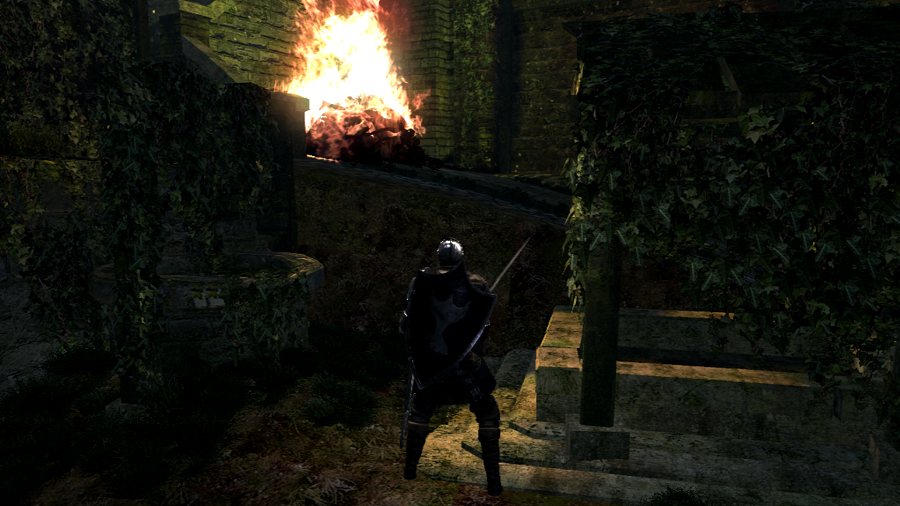 Lower Undead Burg is paired in my mind with the shortly upcoming Old Yharnam. Specifically, Lower Burg feels like a ruined town that the more modern Undead Burg was built on top of. The corpse fire provides an implication that either fire or a plague was involved, similar on both counts to Old Yharnam. We also see a structure to the right that maybe is meant to suggest some kind of vineyard. And of course a well in there for the ever present water imagery. Behind us we find this peculiar scene. 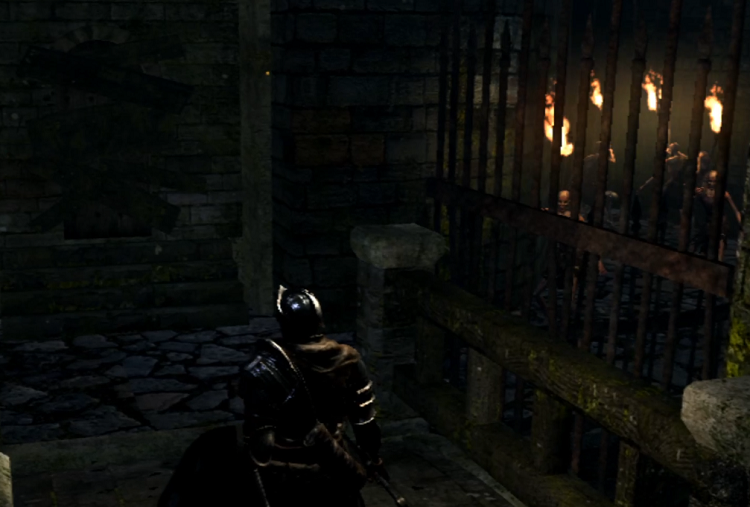 A large group of torch wielding Hollows appear to be trying to break into some kind of domicile. Within the context of Dark Souls this doesn’t make a ton of sense, but moving ahead a few games to Sekiro, we have a bizarrely similar setup:  In Mibu Village, the High Priest of the town is barricaded in a building by a mob including torch wielding undead villagers. He describes his provision of sake to the villagers: quote:Ahhh... It feels... Ohh... That's good... It's melting inside... But it's not enough... Keep pouring... Pour until it brims... Come forth, my people! Come forth and drink, drink! Indulge yourselves in the sweet nectar! Come forth... As citizens of the palace... One and all... Aahh... Please, accept us, as your humble servants... Gulp... Gulp... Gulp... And the one villager NPC you can talk to has this to say about his gift: quote:The head priest sometimes treats us to sake. My suspicion is that this somehow parallels a hidden history to Lower Undead Burg that perhaps never fully made it into Dark Souls 1. Aside from that, it’s curious how tiny the door and window of this building are compared to the usual FromSoft doors: 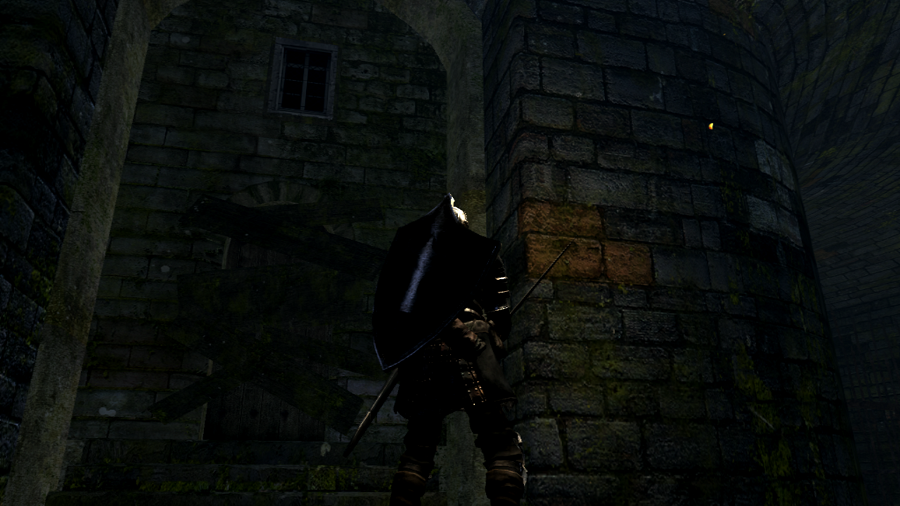 And in the latest example of missing water imagery, the entrance of this area is a dried up moat: 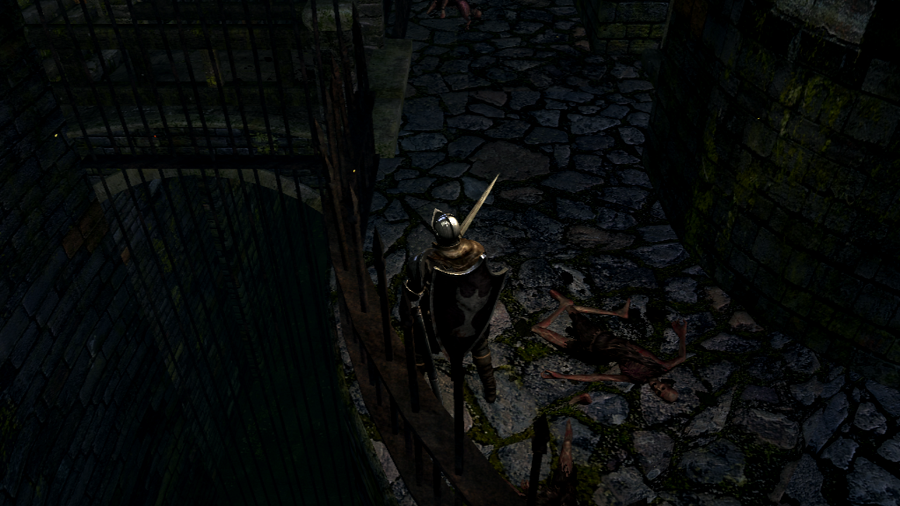 Finally, the side of this building features a Twin Humanities. Don’t have a good explanation, but I’m relatively confident it’s noteworthy. One of the repeating level design features in Dark Souls 1 are blocked off pathways, and Lower Undead Burg is absolutely full of them. 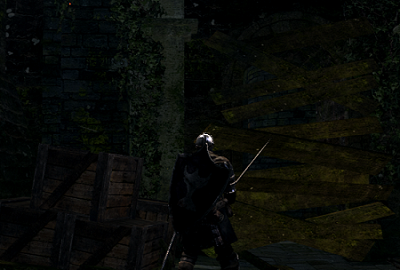 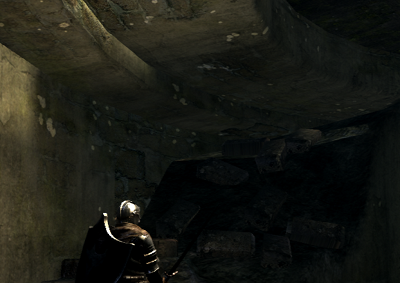 This ties into the theory I introduced back in episode two that Undead Burg is a map that was repurposed from a previous project with now vestigial areas of the map were blocked off. Shortly after the torch mob, we have Griggs of Vinheim. Here’s the room he would be in had my recording worked. 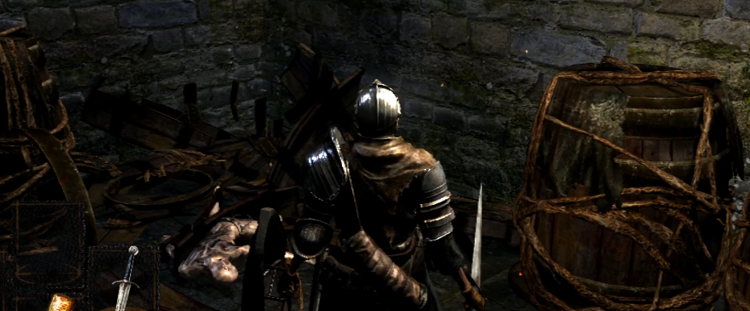 Don’t have a ton to say about him right now, but it’s curious that a corpse in the barrel drops most of his armor set. Maybe it’s a suggestion of corpse trafficking like we’ll see in Bloodborne, or maybe the current Griggs is an imposter and time is convoluted enough that both the imposter and corpse have the same clothes. Ultimately not an NPC I’m especially interested in atm. So let’s talk about the two major enemy types in the area.  The Undead Attack Dogs get brought up in the Design Works Interview: quote:Otsuka: How about the dogs in the depths, I actually found their movement a little unsettling. The accidental origin of their animation is something that will become more noteworthy later. As for the Hollow Assassins like the one next to the dog, they’re a precursor to the Hollow Assassins we see in DS3’s High Wall of Lothric, all the way down to a number of moveset similarities like the dagger throw. 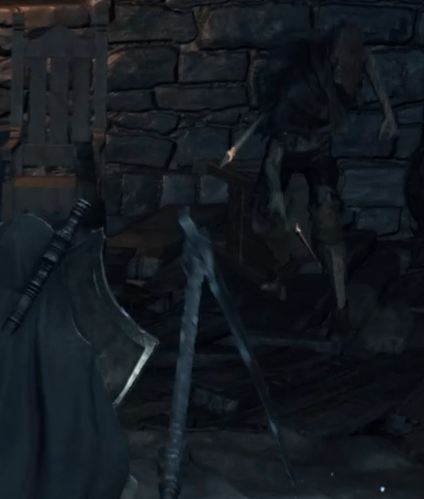 And just like High Wall of Lothric, one of them is standing in front of a Mail Breaker, which also happens to be Griggs weapon. Like the Mibu Village resonance, this suggests to me that the implied stories we find in the later games have their genesis in the original Dark Souls.  Finally, we get to the boss of the area, Capra Demon. Returning to the Design Works interview: quote:Nakamura: Before we move on, I'd like to ask you about the Demon enemies I designed, specifically those designs which incorporate some type of symbolism. I know that you dislike designs which are too easy or obvious, but spending too much time trying to force symbolism into designs can also be just as damaging to the development of the world. So I just wanted to know how you feel about the demon enemies overall. When he talks about how the head “hints at a developed culture,” I think this is intended to make you see the Capra Demon not as a traditional video game demon. It has humanity, after all. There’s a lot of subtle elements at the design that hint that something deeper is going on beneath the surface. 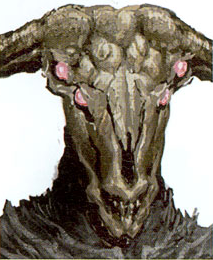 Looking at the head specifically, the multiple glowing eyes is evocative of a design seen in later games: 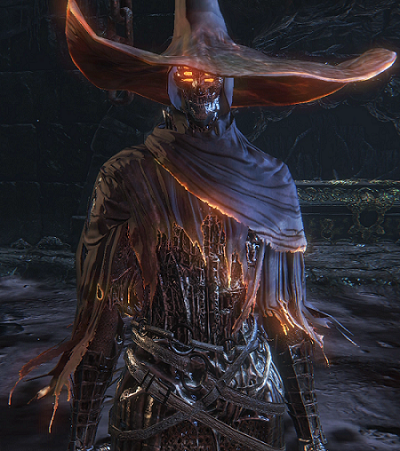 The Keeper of the Old Lords from the Bloodborne chalice dungeons. They both feature a rather distinct set of belts, with the Capra Demon’s belt making it look like its pants are held up with barbed wire. But the most striking similarity between the Capra Demon and the Keeper of the Old Lords is their distinctive companions, a demonic doggo duo. 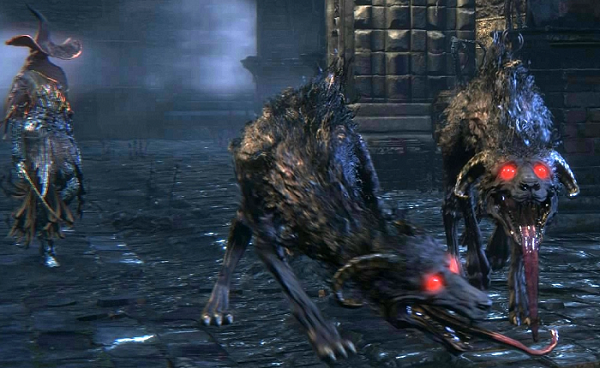 But there are yet more Bloodborne parallels we can draw to the Capra Demon. 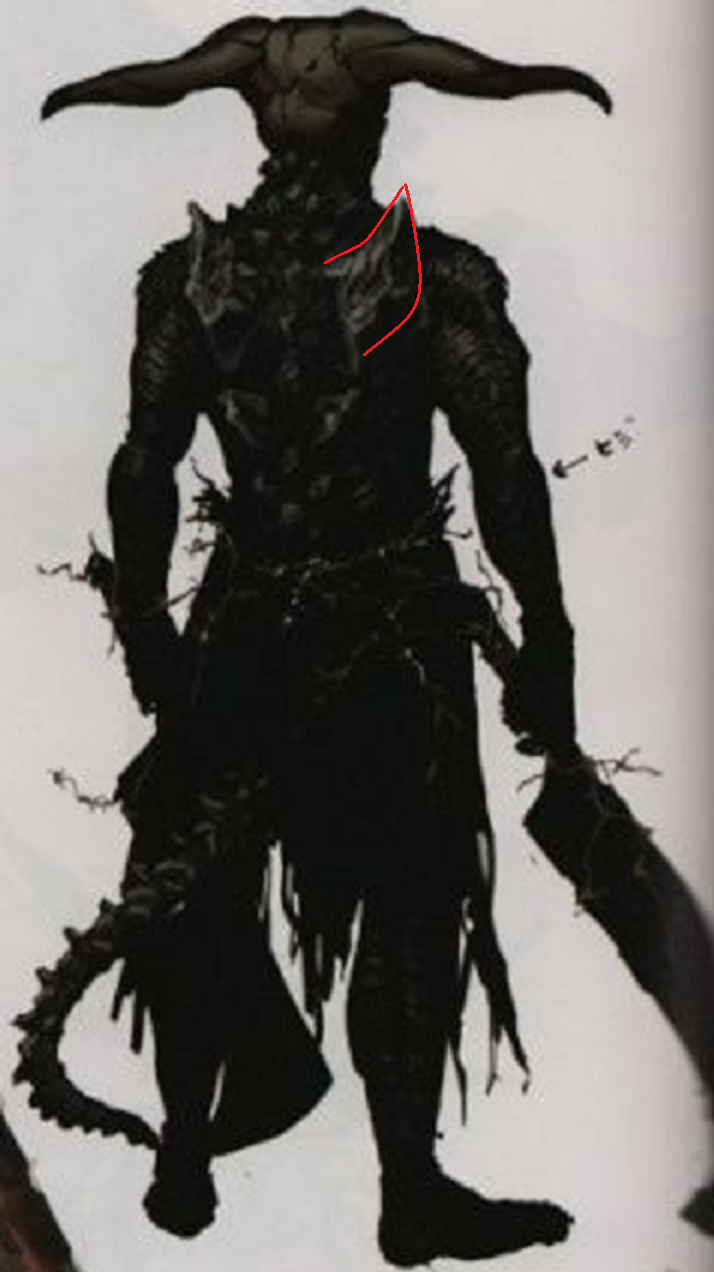 Returning to its concept art we notice two distinct protrusions on its back. The positioning gives the impression that at one time the Capra Demon had wings, a concept loosely resonant with the Design Works description of the Crow Demons in the Painted World: quote:Nakamura: I like to think that they were humans who wanted to fly so badly that they sprouted wings, but rather than their skeletons evolving over time, they instead twisted their limbs into unnatural positions, forcing their bodies into a birdlike shape, that's how I've always imagined them. But following the same line of thought, the Oh The Humanities video How Bloodborne Transforms the Myth brings up a detail I had not noticed about the Bloodborne cover art: the hunter appears to have similar imagery involving bloody wings.  As the video goes on to point out, this blood spurting out the back motif shows up again in the wings of blood that Amygdalas have during their boss fights. But the visual references don’t end there. As gamefaqs user Grisonaut points out the saw cleaver is positioned in such a way to make it look like a tail, a tail that would be rather similar to the intricately detailed Capra Demon tail. Before I get to my final point, I want to make a quick observation about the Capra Demon’s weapon. Demon Great Machete posted:The lesser Capra demons use these greatswords in pairs. The blade is cast iron and hooked. There’s potentially a level of storytelling going on in the development of metallurgic technology. The previous boss, the Bell Gargoyles, had equipment made of bronze. The weapons of the Capra Demon are made of iron. According to wikipedia, iron weapons generally were not much stronger than bronze, but were much easier to produce, which is appropriate given the number of Capra Demons we’ll be seeing later. The Demon Great Machete is also specifically “cast iron.” My understanding is that casting iron produces brittle weapons, but curiously the Demon Great Machete has one of the highest durabilities in the game. Its durability of 600 is shared with a lot of other demonic weaponry such as Quelaag’s Furysword, Demon’s Greataxe, and the Titanite Catch Pole as well as other iron-based weapons like the Golem Axe and Grant. In fact, Nito’s Gravelord Sword is the only 600 durability weapon that isn’t either directly associated with demons or iron. Given the Celtic roots of much of the inspiration behind Dark Souls, it's possible that Capra's weaponry was inspired by historical sources along these lines: quote:Polybius reports that the Gauls at the Battle of Telamon (224 BC) had inferior iron swords which bent at the first stroke and had to be straightened with the foot against the ground. Plutarch, in his life of Marcus Furius Camillus, likewise reports on the inferiority of Gaulish iron, making the same claim that their swords bent easily. These reports have puzzled some historians, since by that time the Celts had a centuries long tradition of iron workmanship. In 1906 a scholar suggested that the Greek observers misunderstood ritual acts of sword-bending, which may have served to "decommission" the weapon. Such bent swords have been found among deposits of objects presumably dedicated for sacred purposes. Anyway, we finally get to Thorolund’s douchebag brigade: 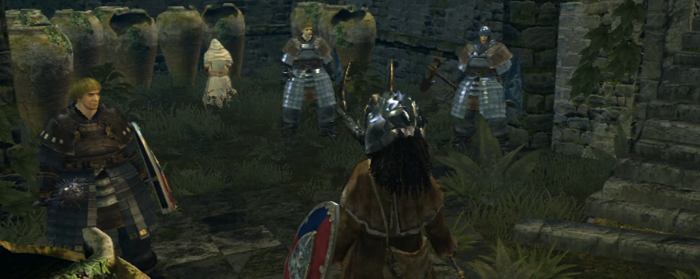 Rhea and her bodyguards show up after you beat the Capra Demon, and there’s a couple of interesting things going on here. First, there’s a peculiar resonance between Rhea’s guards Vince and Nico and Anri and Horace from Dark Souls 3. Specifically certain locational elements of their questlines and how one of each group has a much more covered face and appears to be mute. But the thing that I’m playing with in my head is the similarity they have to the Capra Demon and its dogs, as though by ending one journey prematurely you allow the next one to take place. A fantasy series I’ve been reading has chapters where a parallel journey to the main characters is being undertaken by individuals from a different civilization, and I can’t help but wonder if something similar is occurring here. Like most of the demon bosses in these games (along with the upcoming Gaping Dragon) the Capra Demon drops a Homeward Bone. While we could just see the Capra Demon as a generic filler boss, there’s something poetically tragic about the idea that it was just a lone individual on a quest to acquire some sacred rite that could save its entire civilization. That is was clinging on to this single Homeward Bone as a way to return once its target was secured. And that you squashed all those hopes and dreams with no more thought than you might put into stepping on an ant. A bone, belonging to one whose journey was cut short, with the power to travel to bonfires, as if it yearns to resume its futile quest... Sibyl Disobedience fucked around with this message at 05:22 on Jul 31, 2020 |
|
|
|

|
| # ¿ Apr 25, 2024 14:29 |
|
Blaziken386 posted:It could be that, but I think it's moreso to go along with the plague theme - instead of walls, condemned buildings. Let the variable stand for both. In a game design perspective, you board off sections that are no longer useful for your game design purposes. In a narrative perspective you explain that boarding off as condemning plagued buildings. And to achieve a three-dimensional* ludonarrative harmony, the source of the plague is symbolically tied to reason the map had originally been condemned before it was given a second chance at life. *in this case, harmony not only between the narrative and your actions as a player, but also including the primordial state of the game's own development quote:Also, poor Capra demon, doomed to generic bosshood. Just wanted to add, this may be more apt than you realize. Sibyl Disobedience fucked around with this message at 22:26 on Jul 23, 2020 |
|
|



